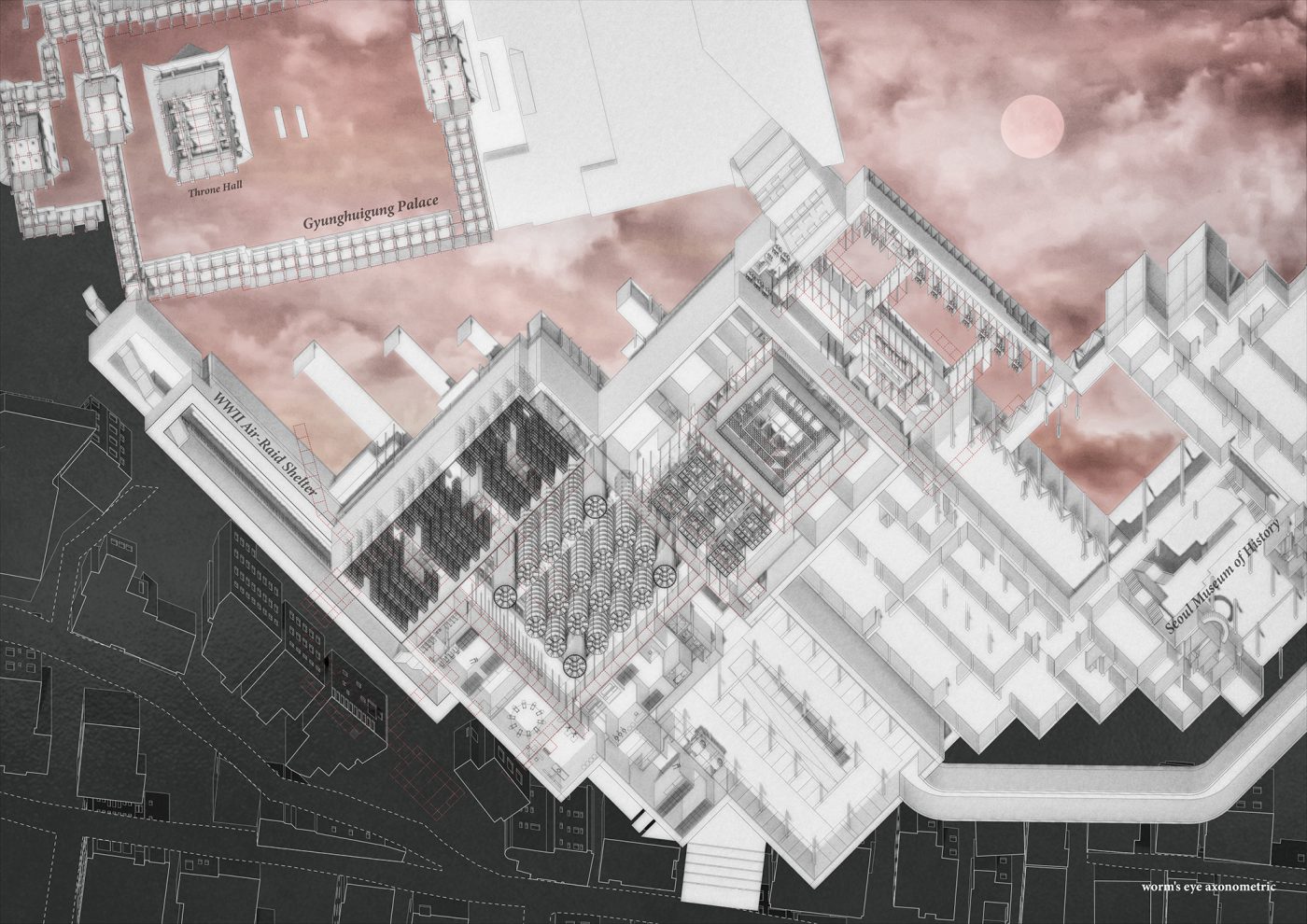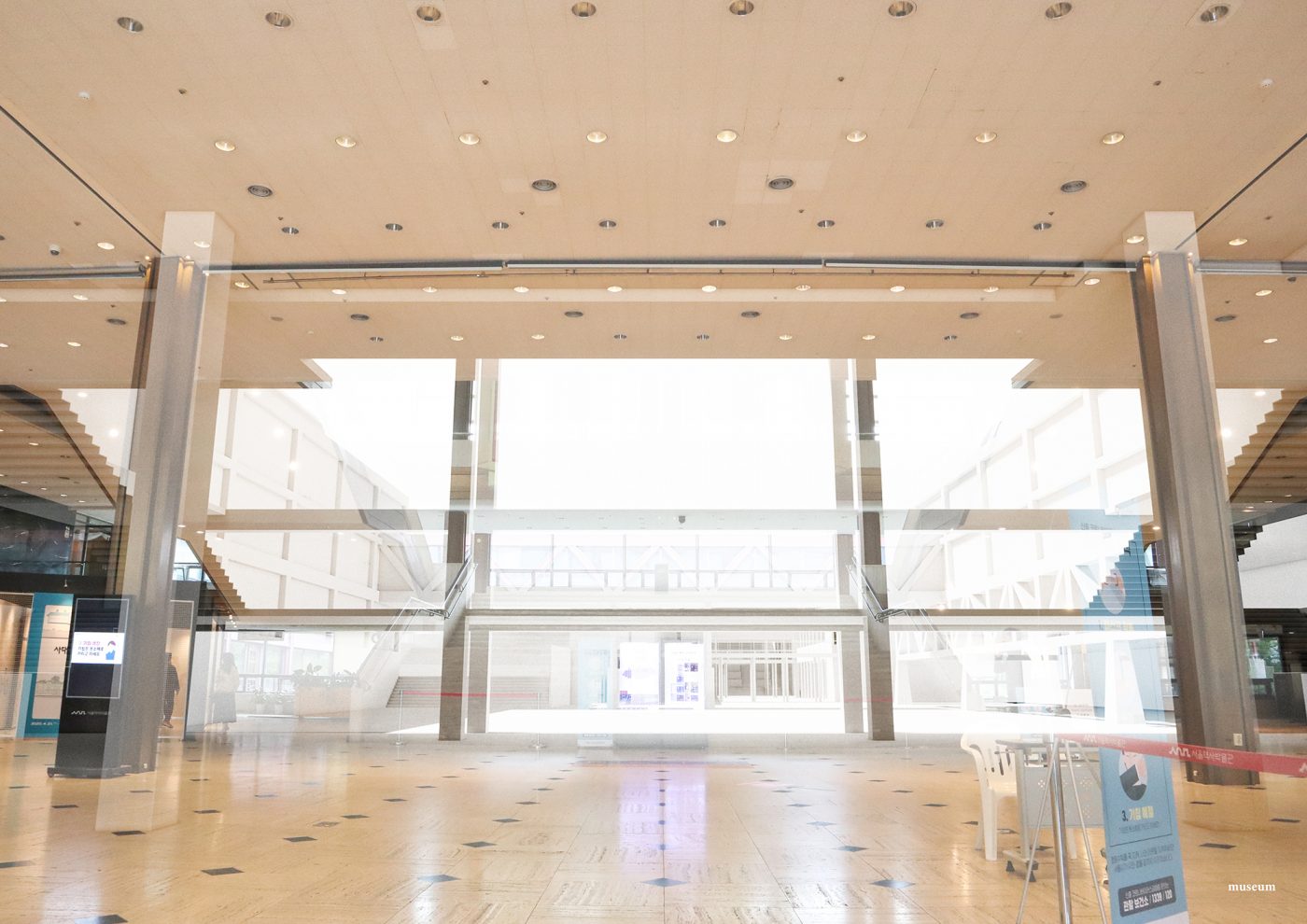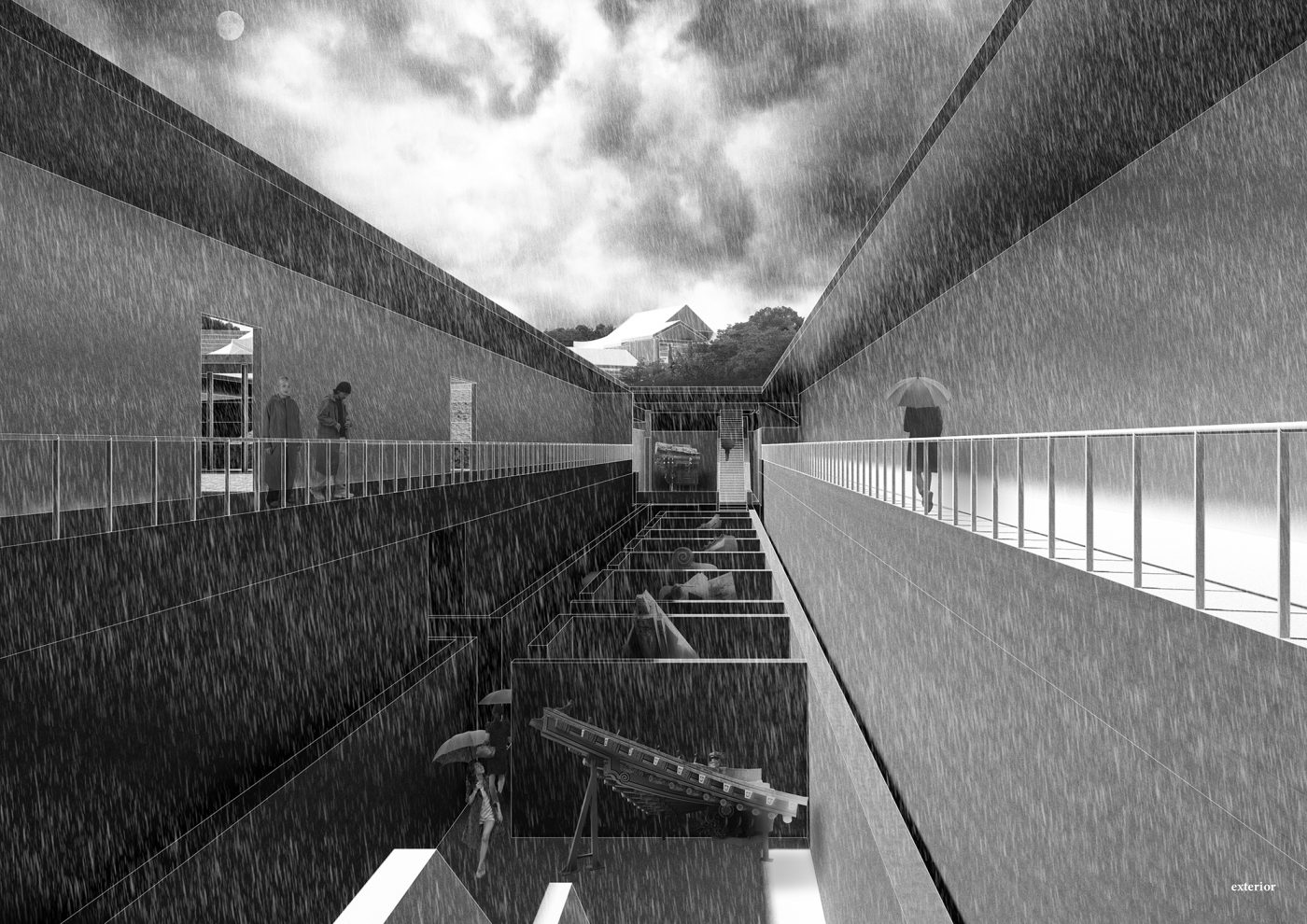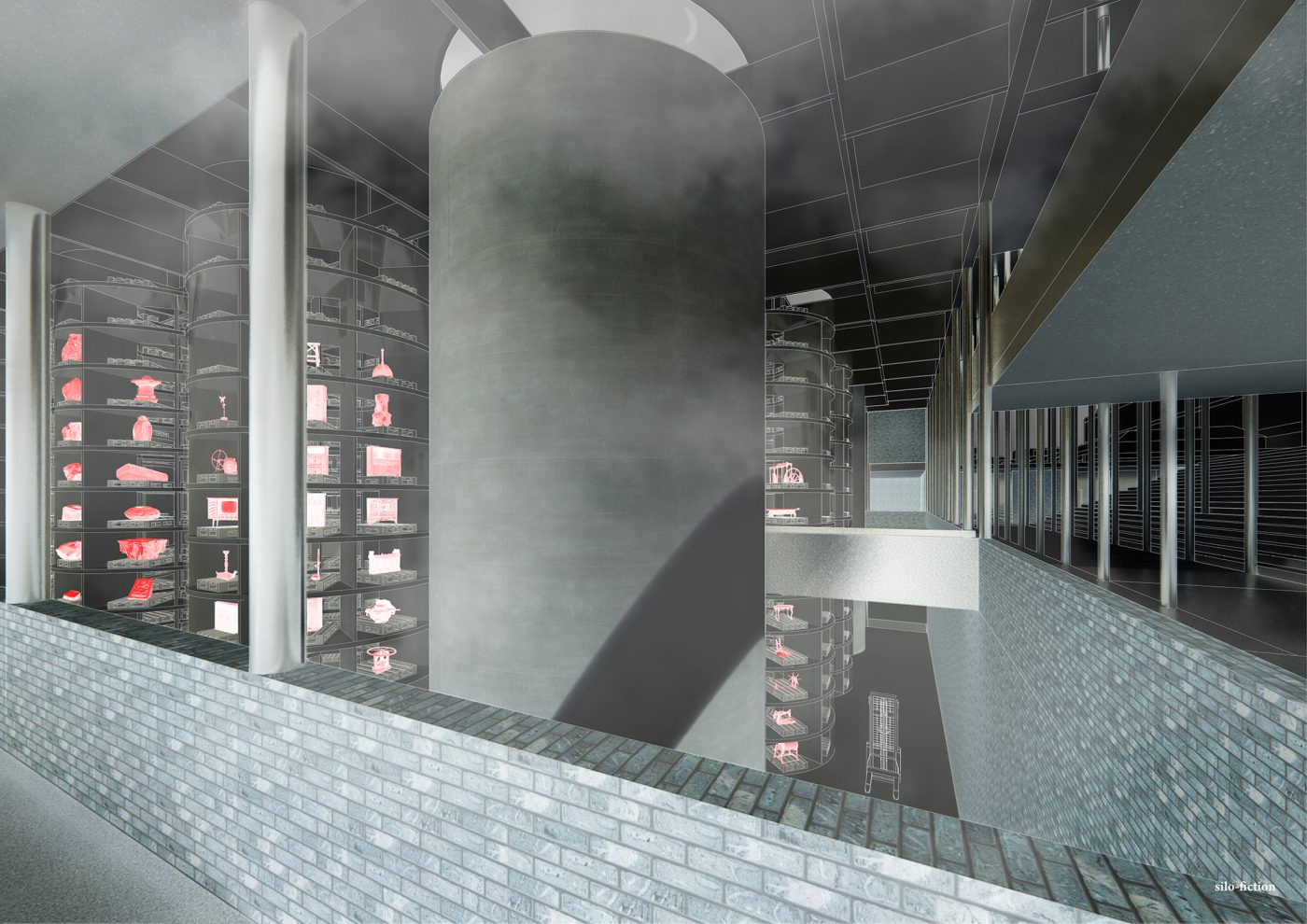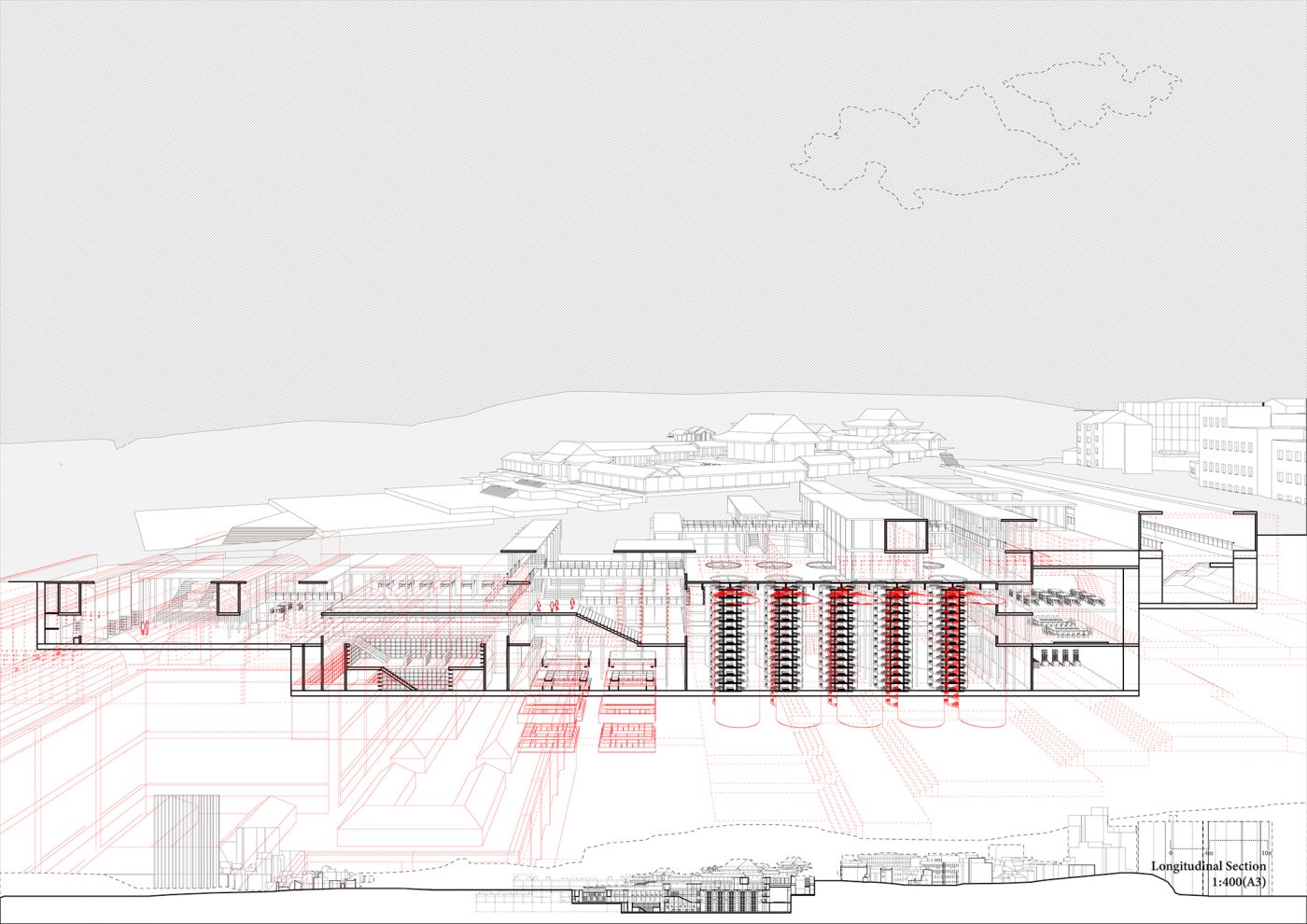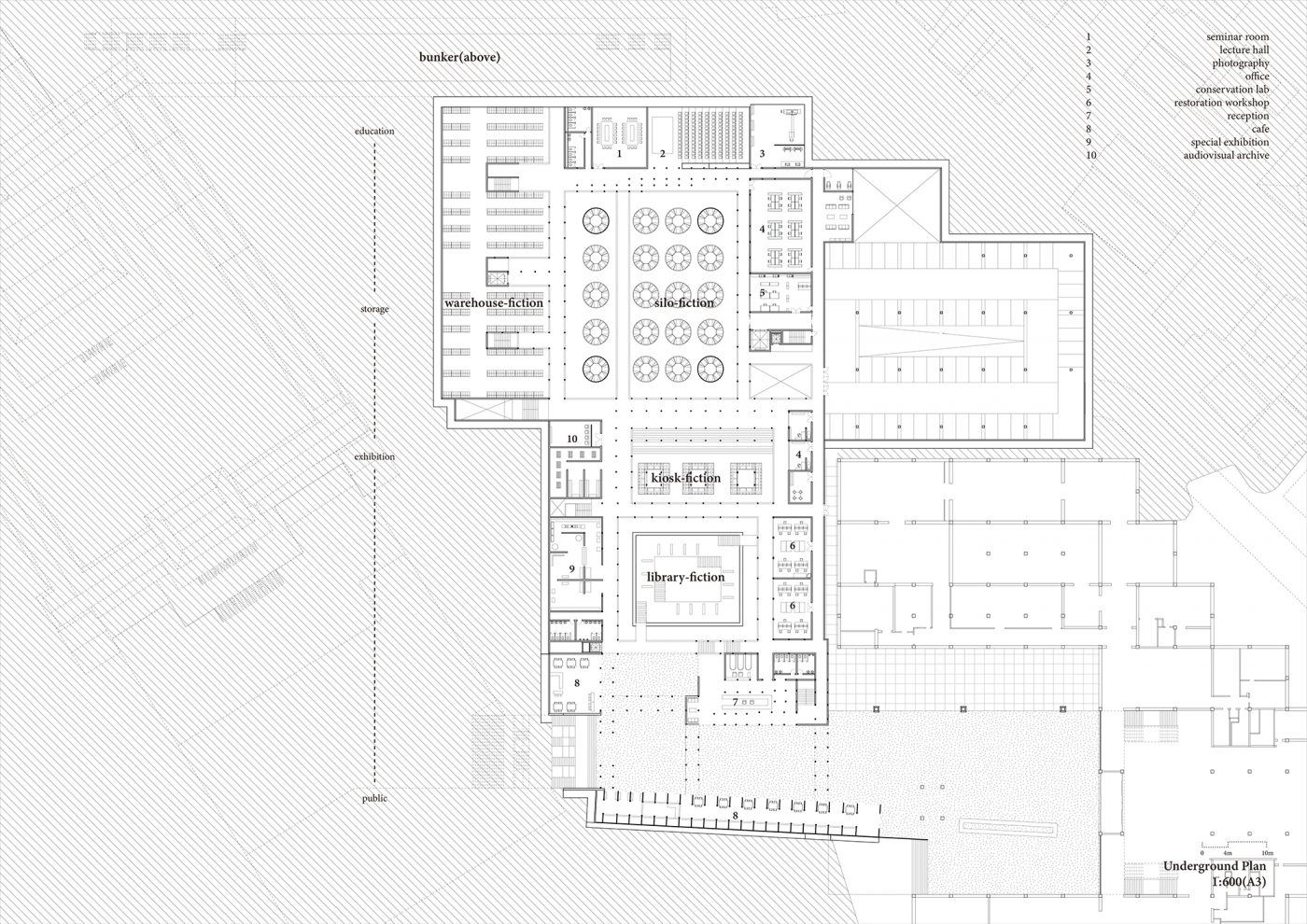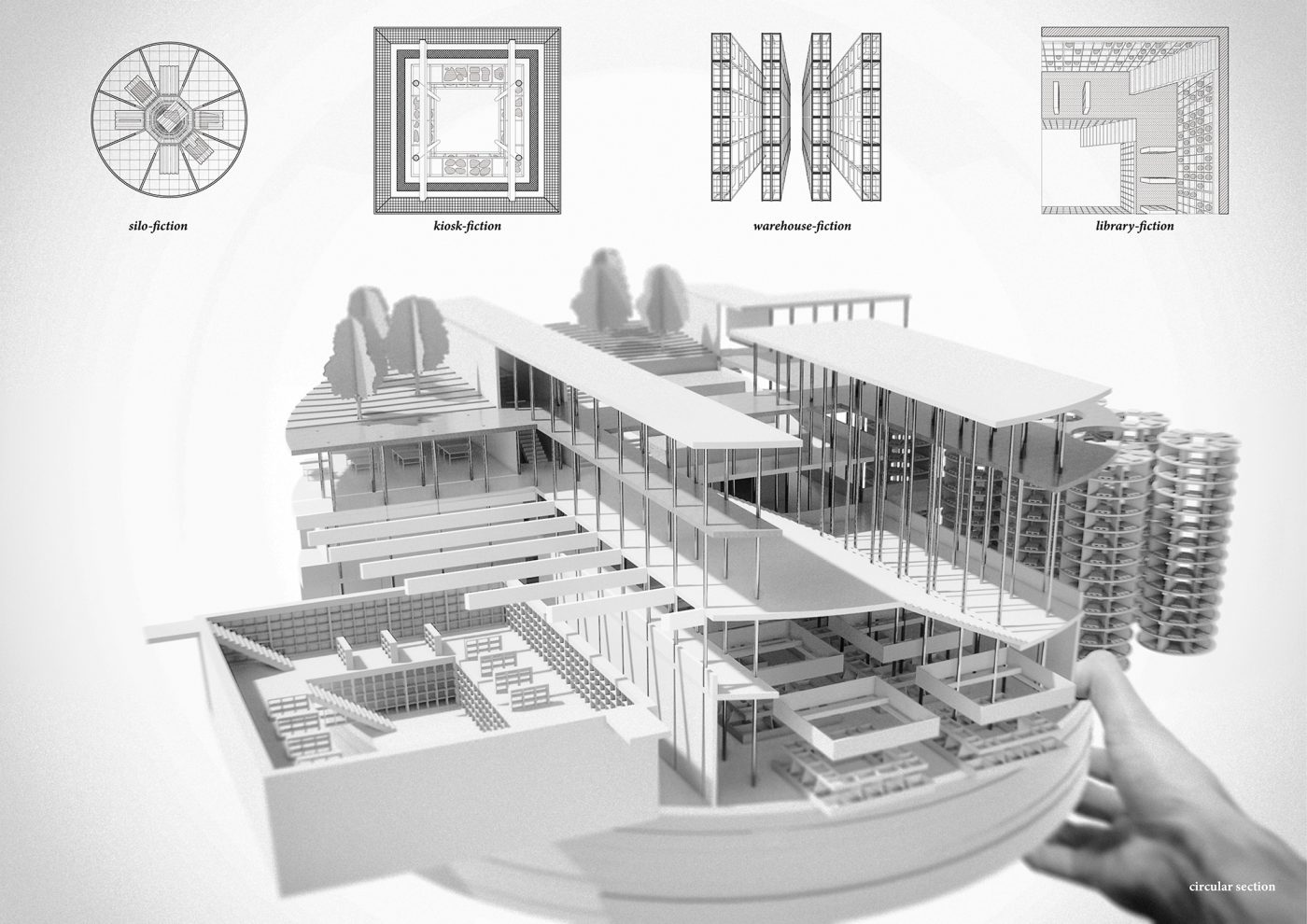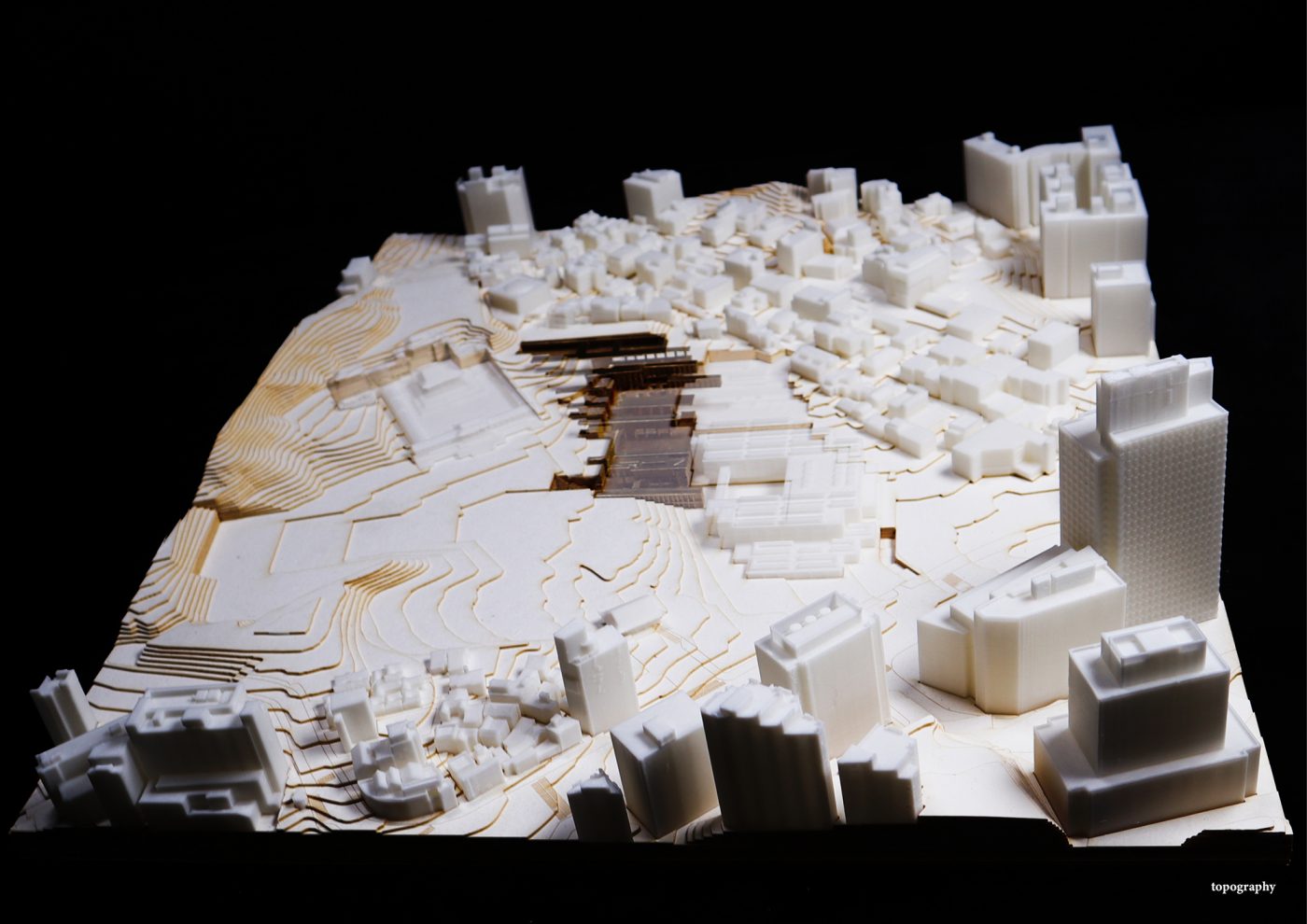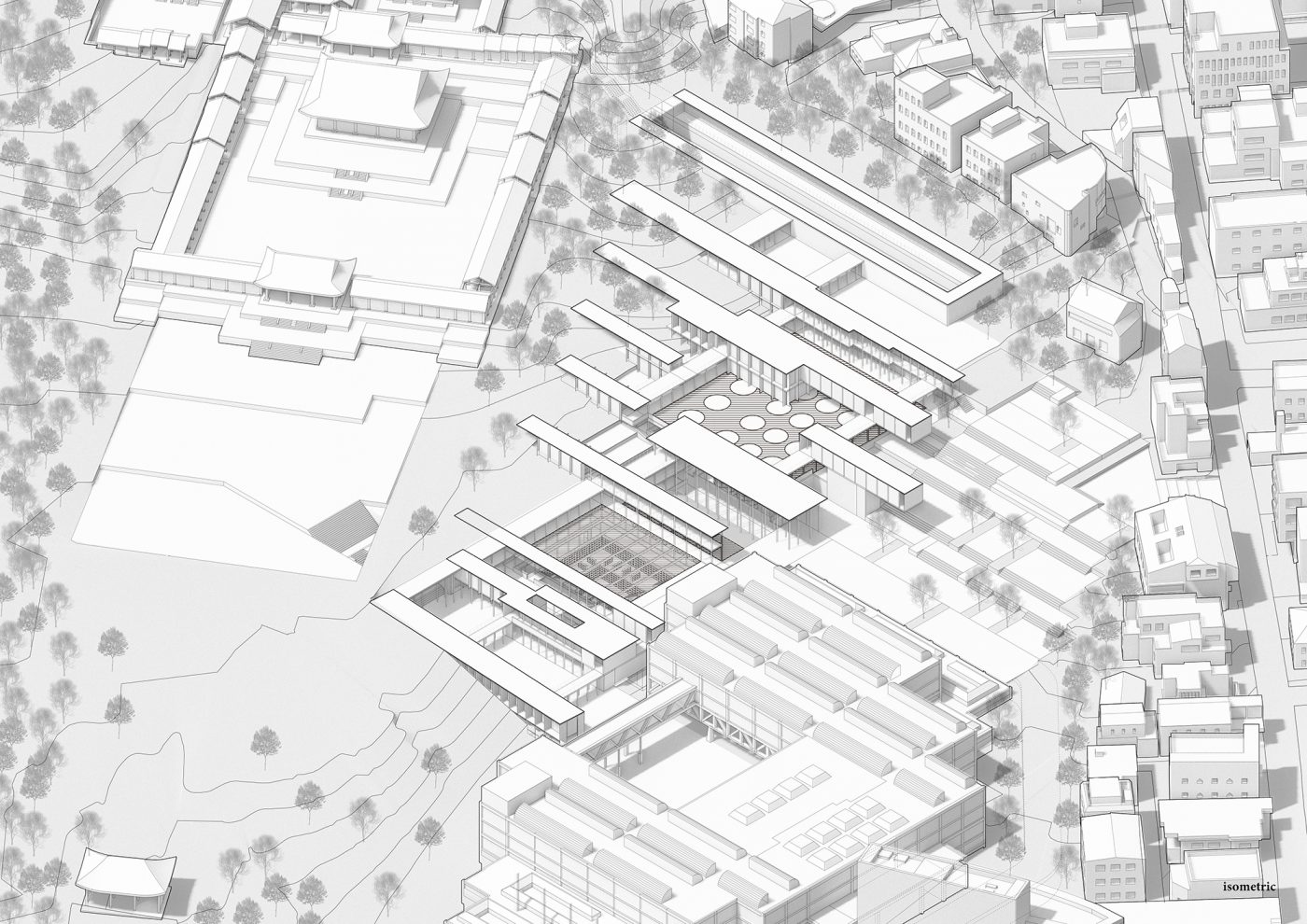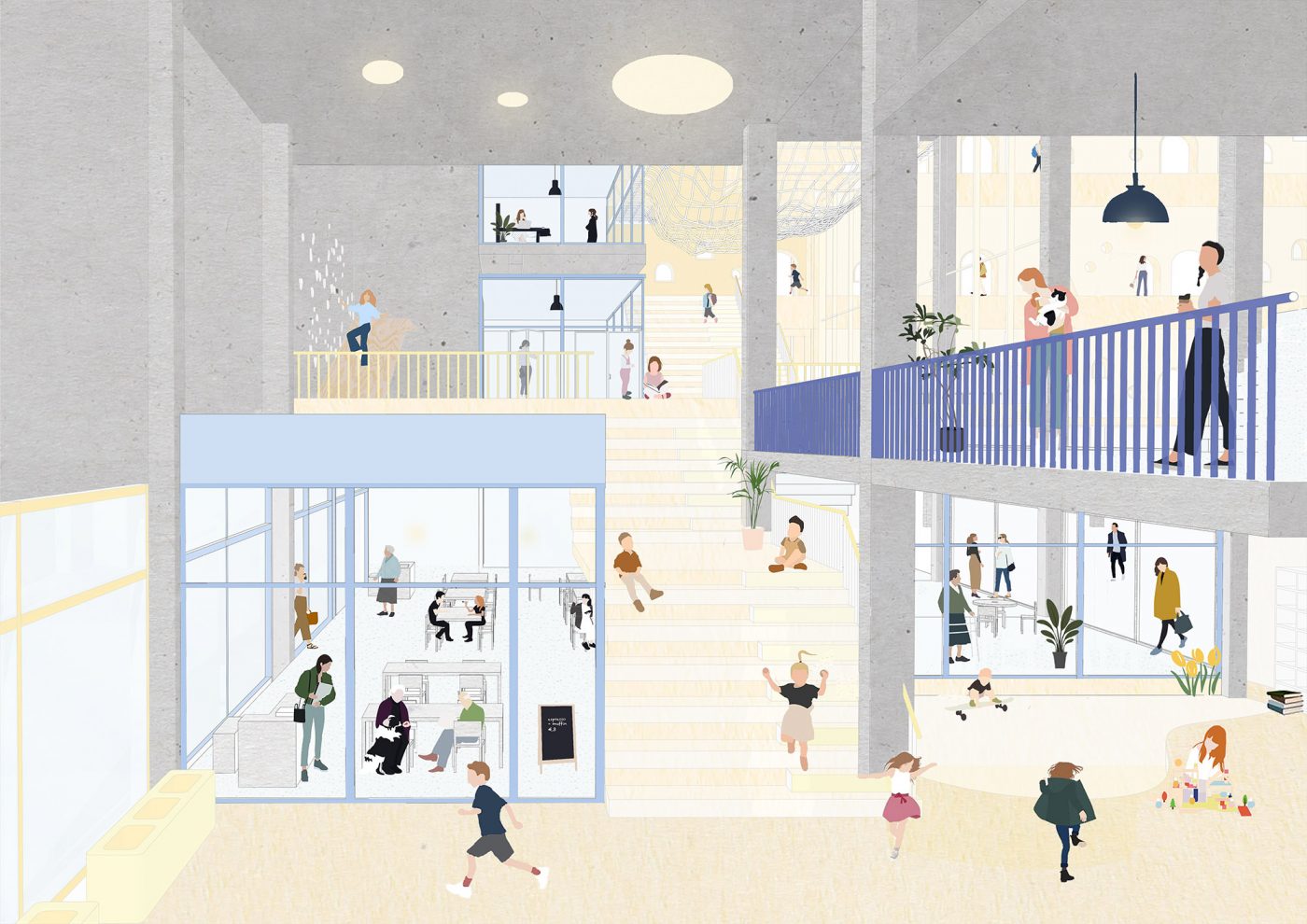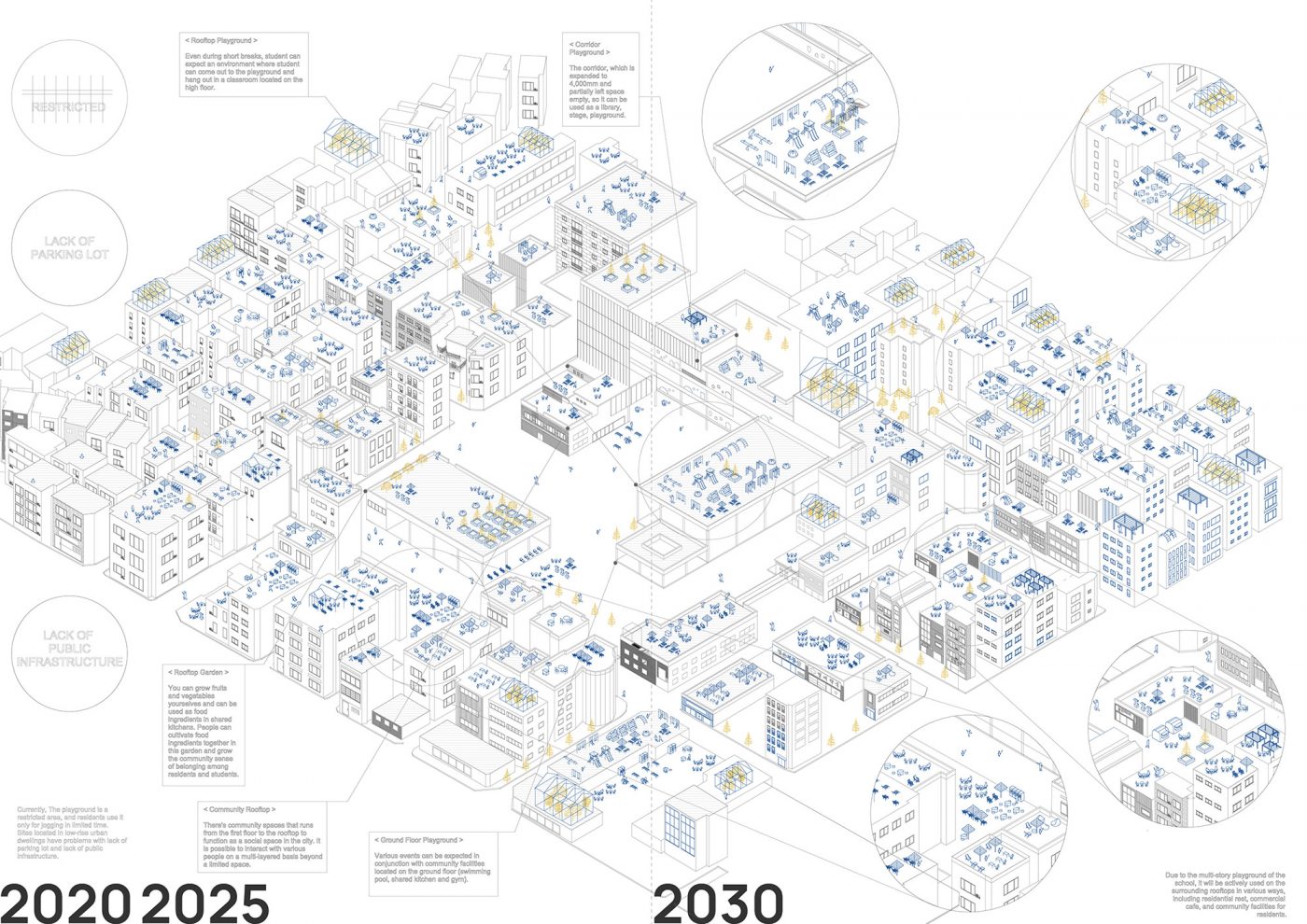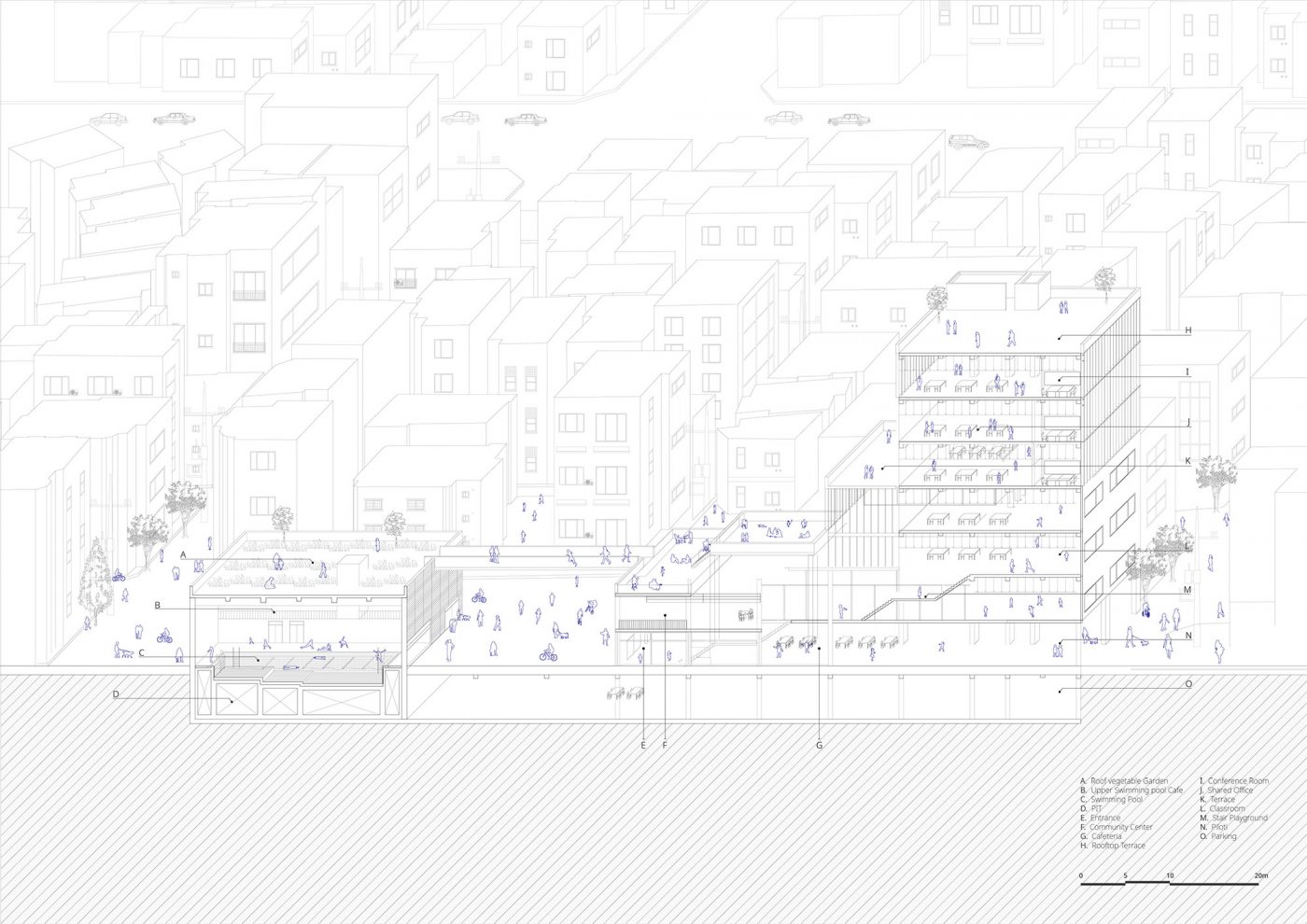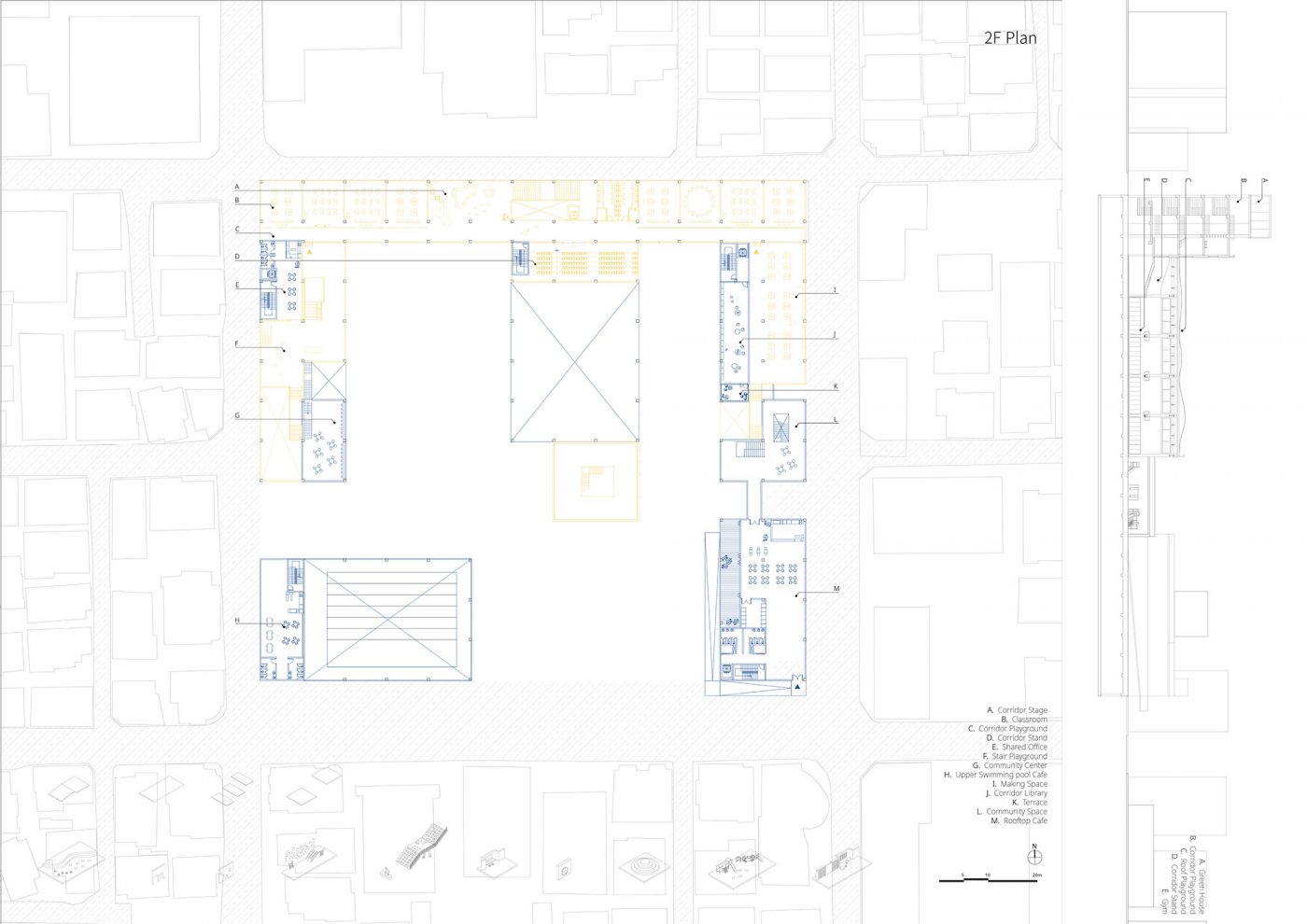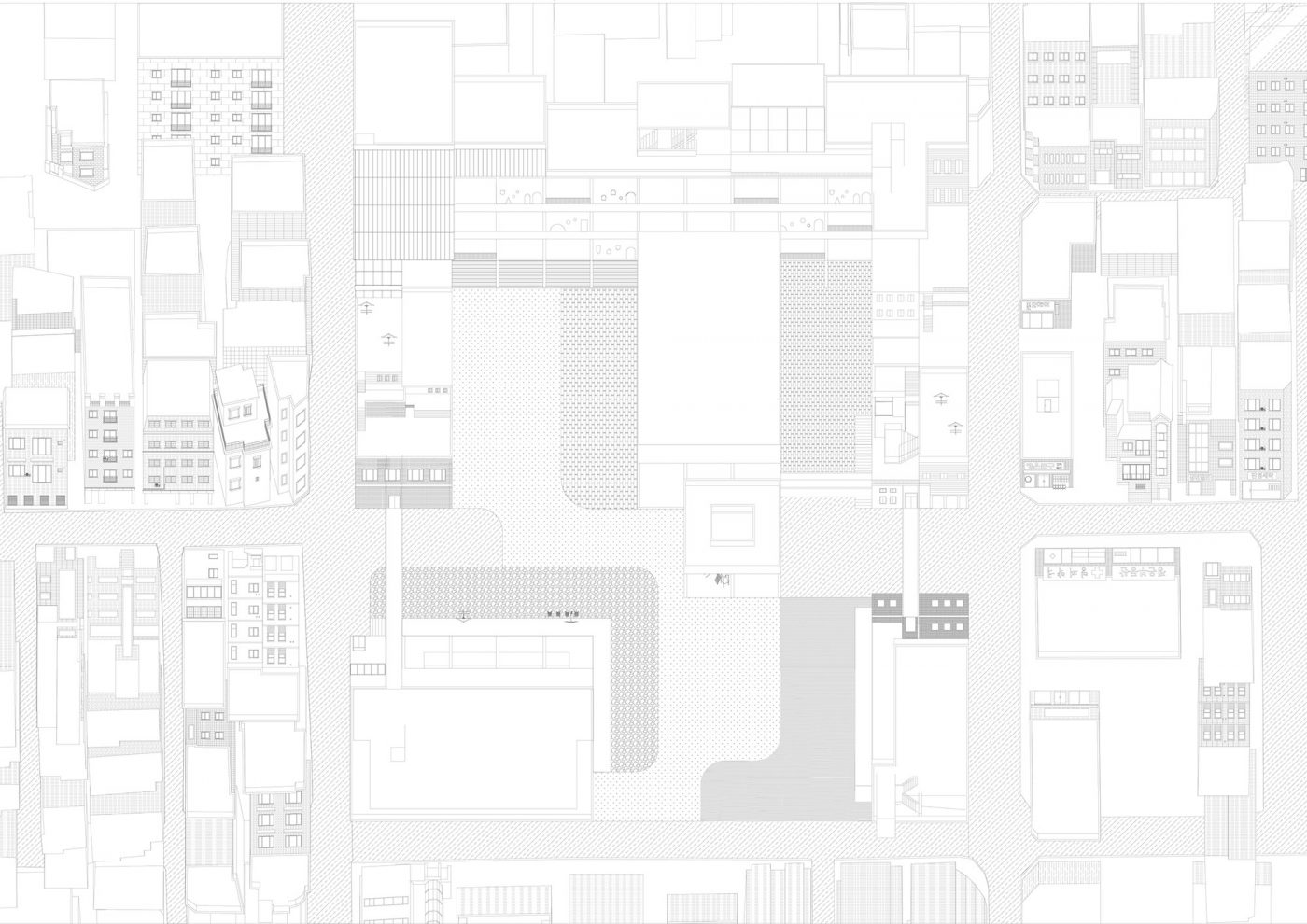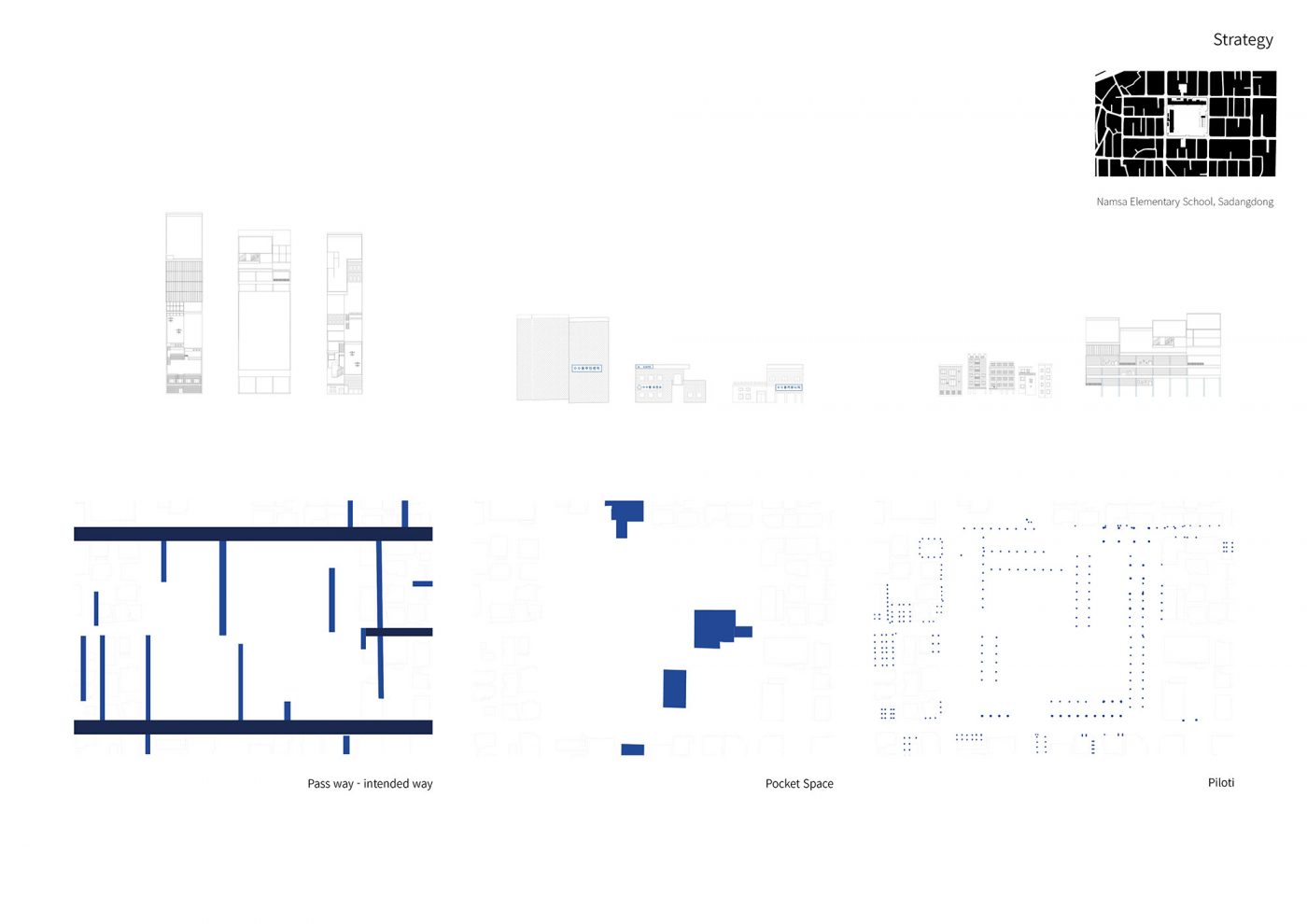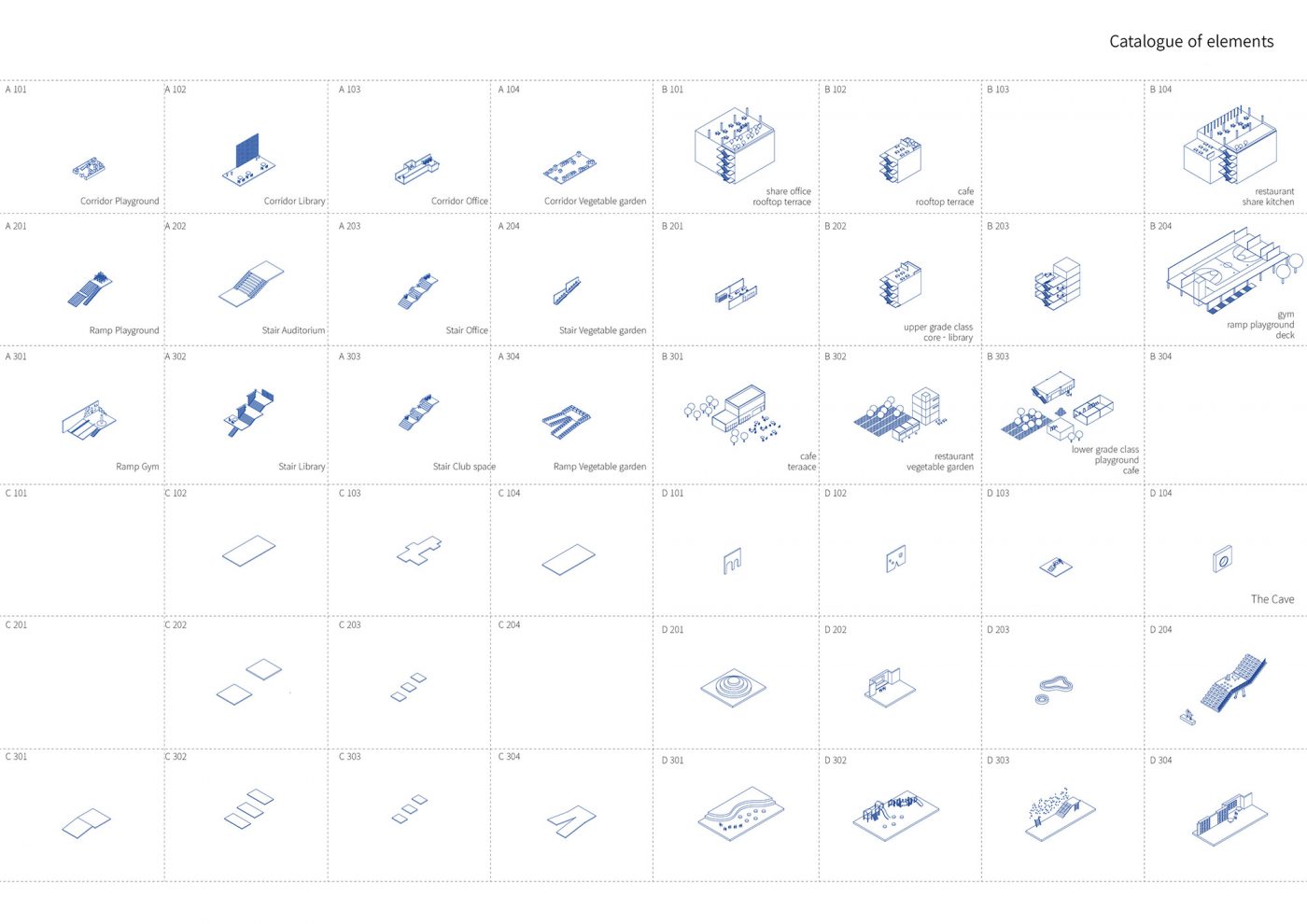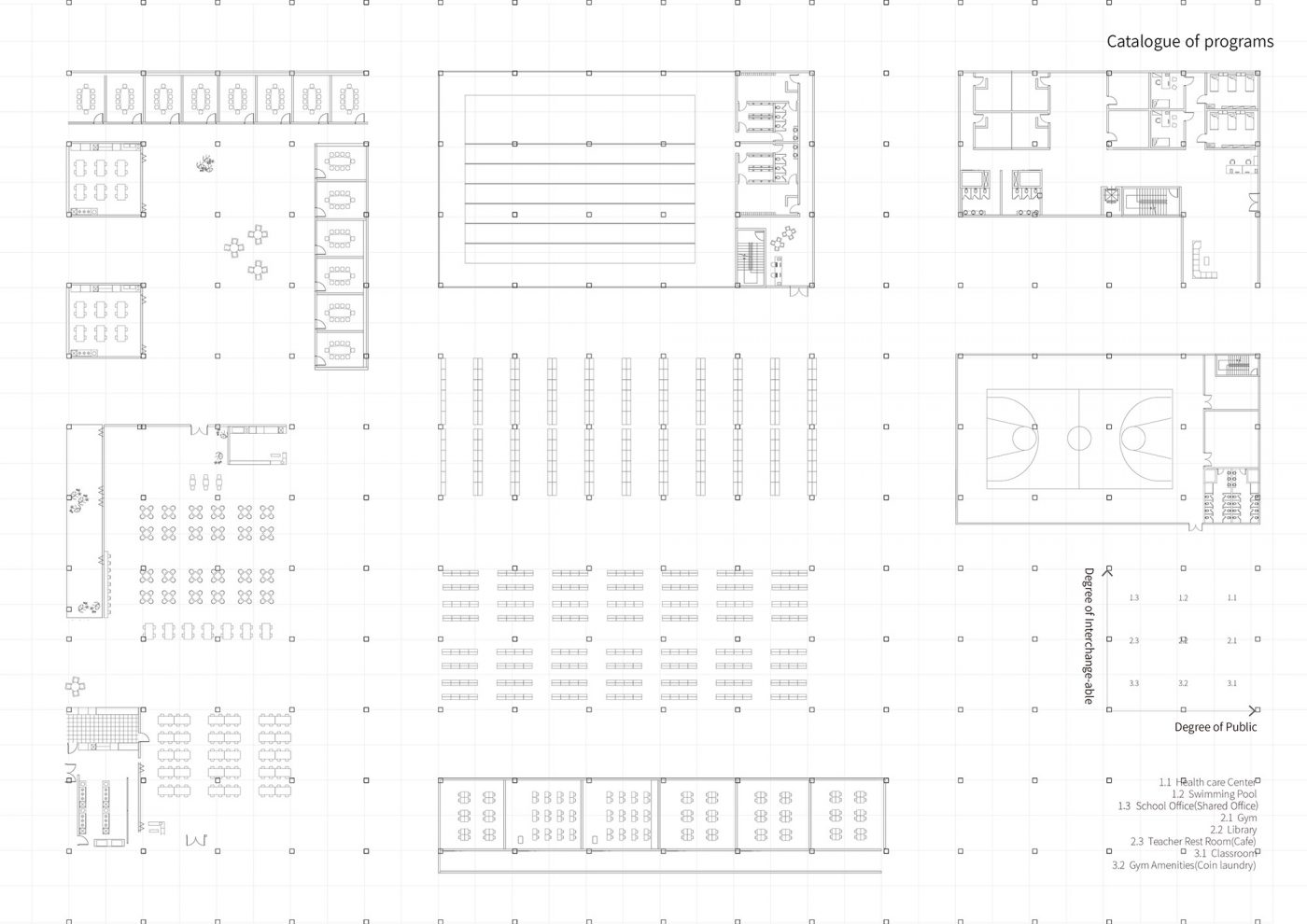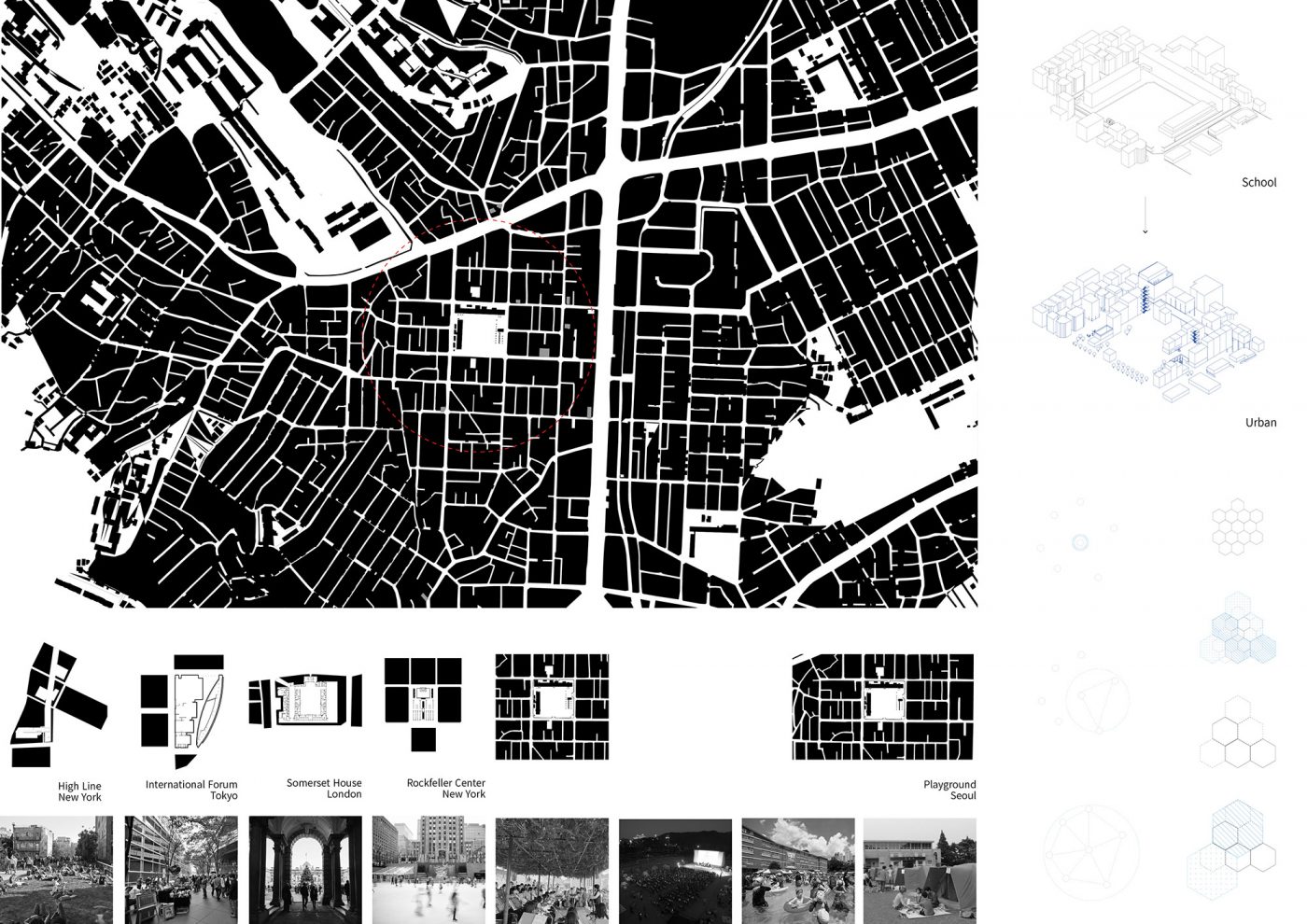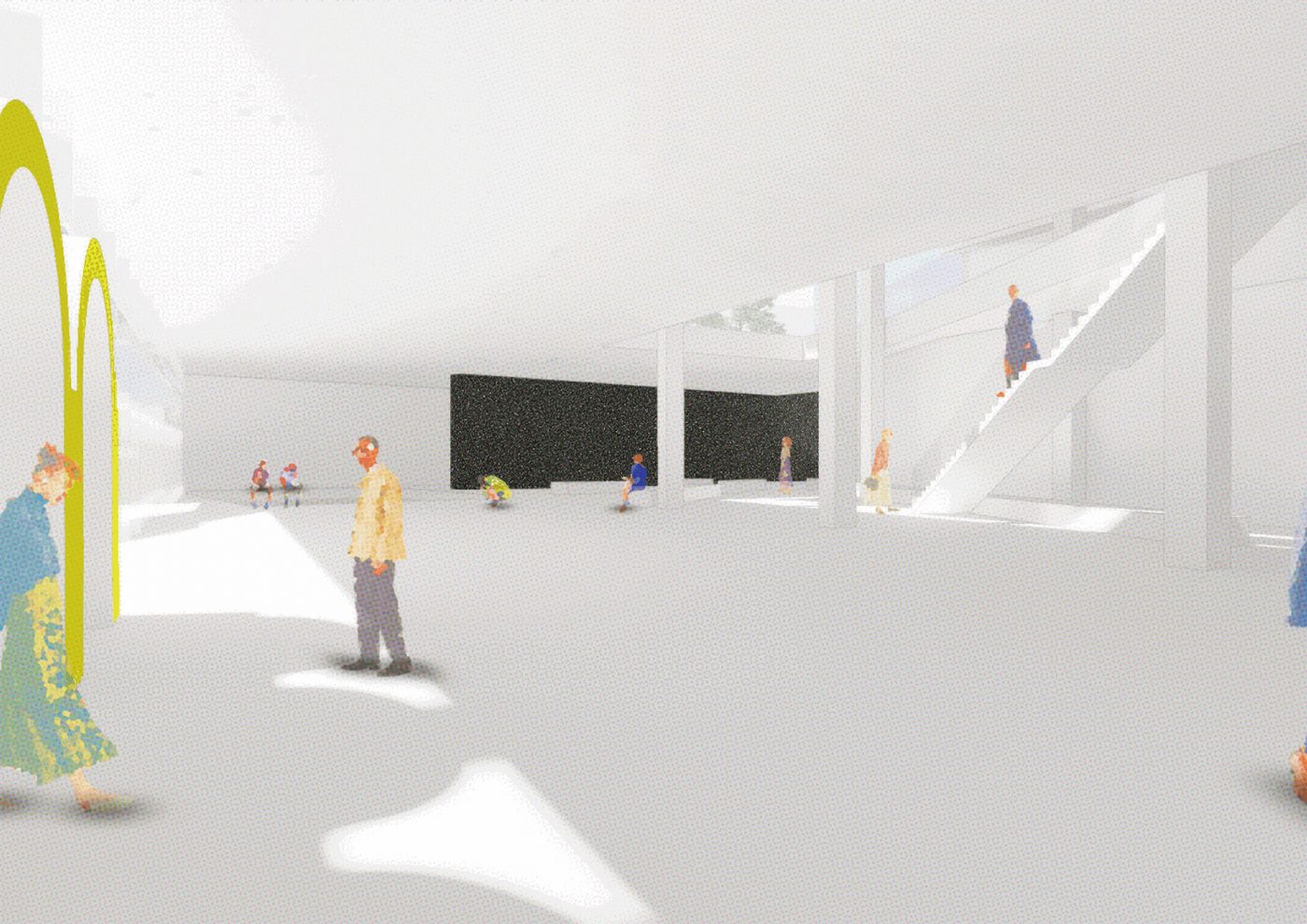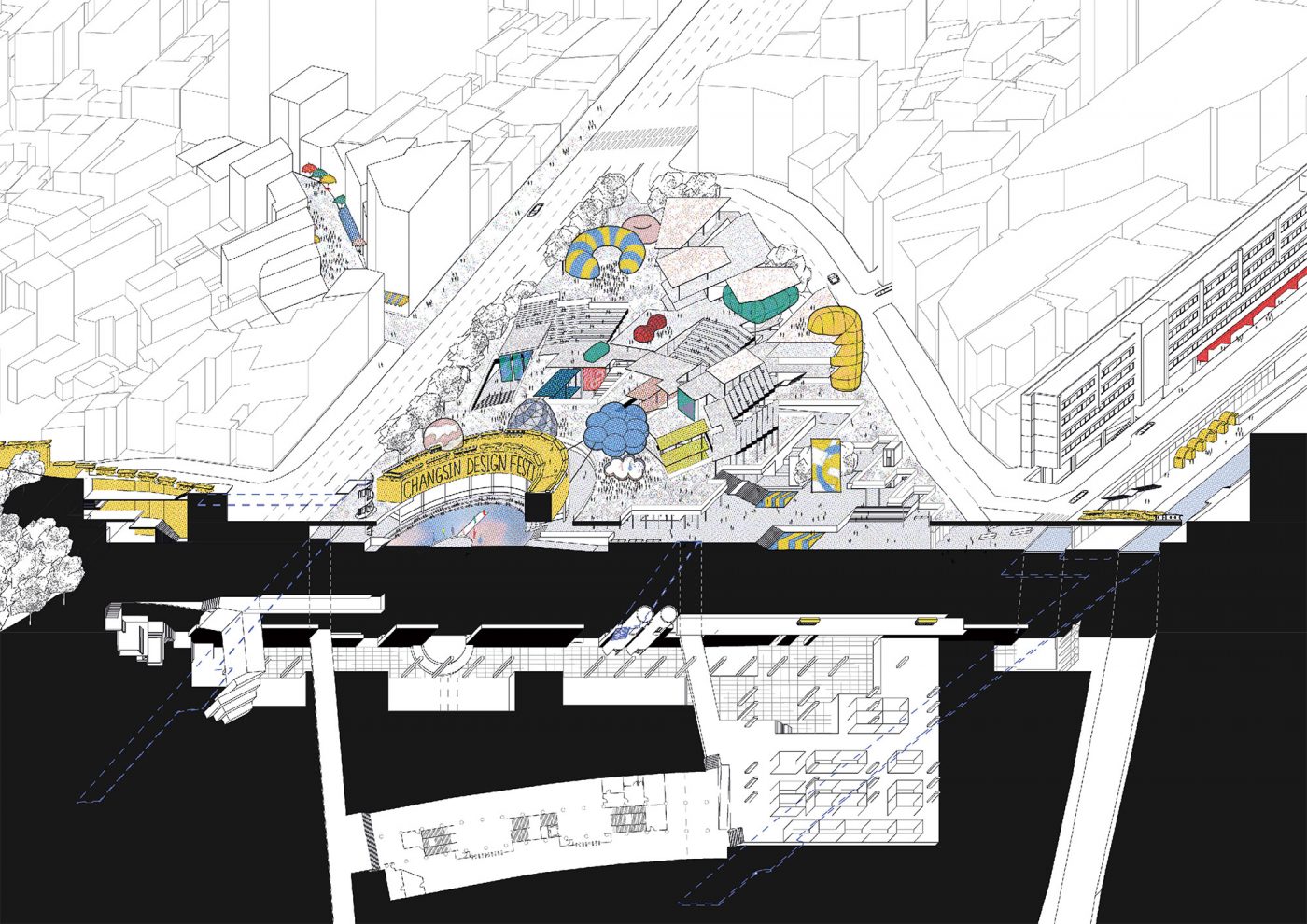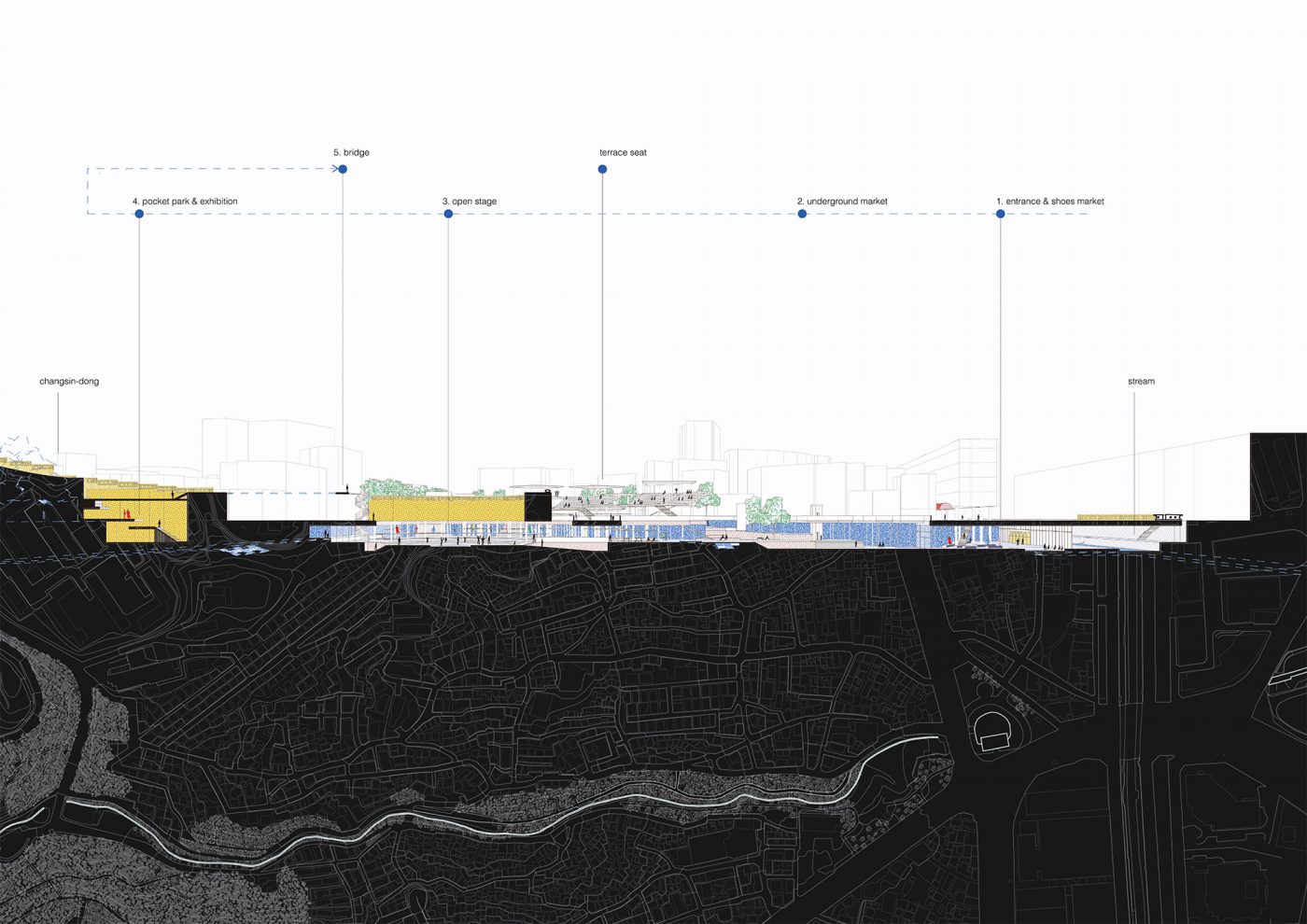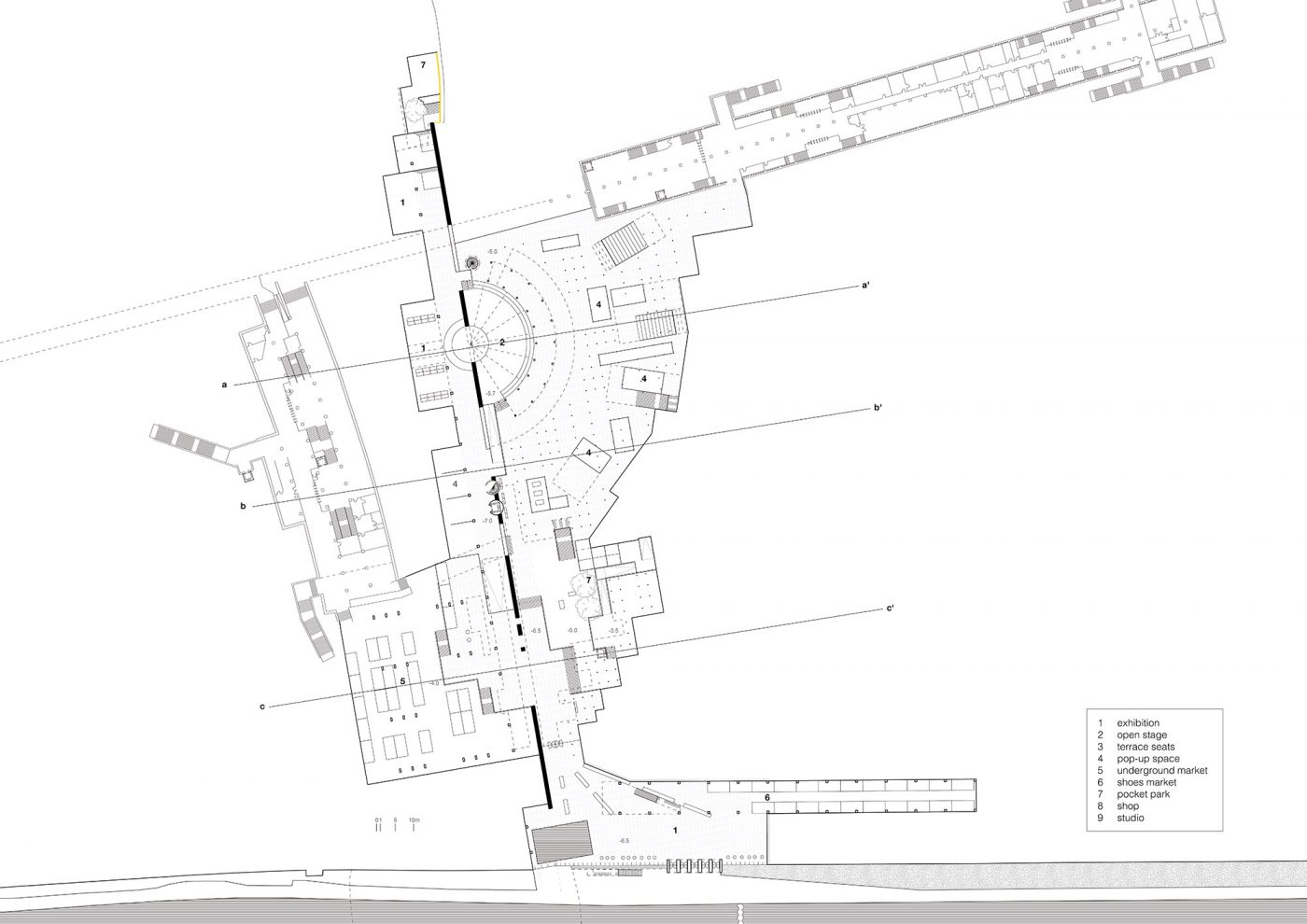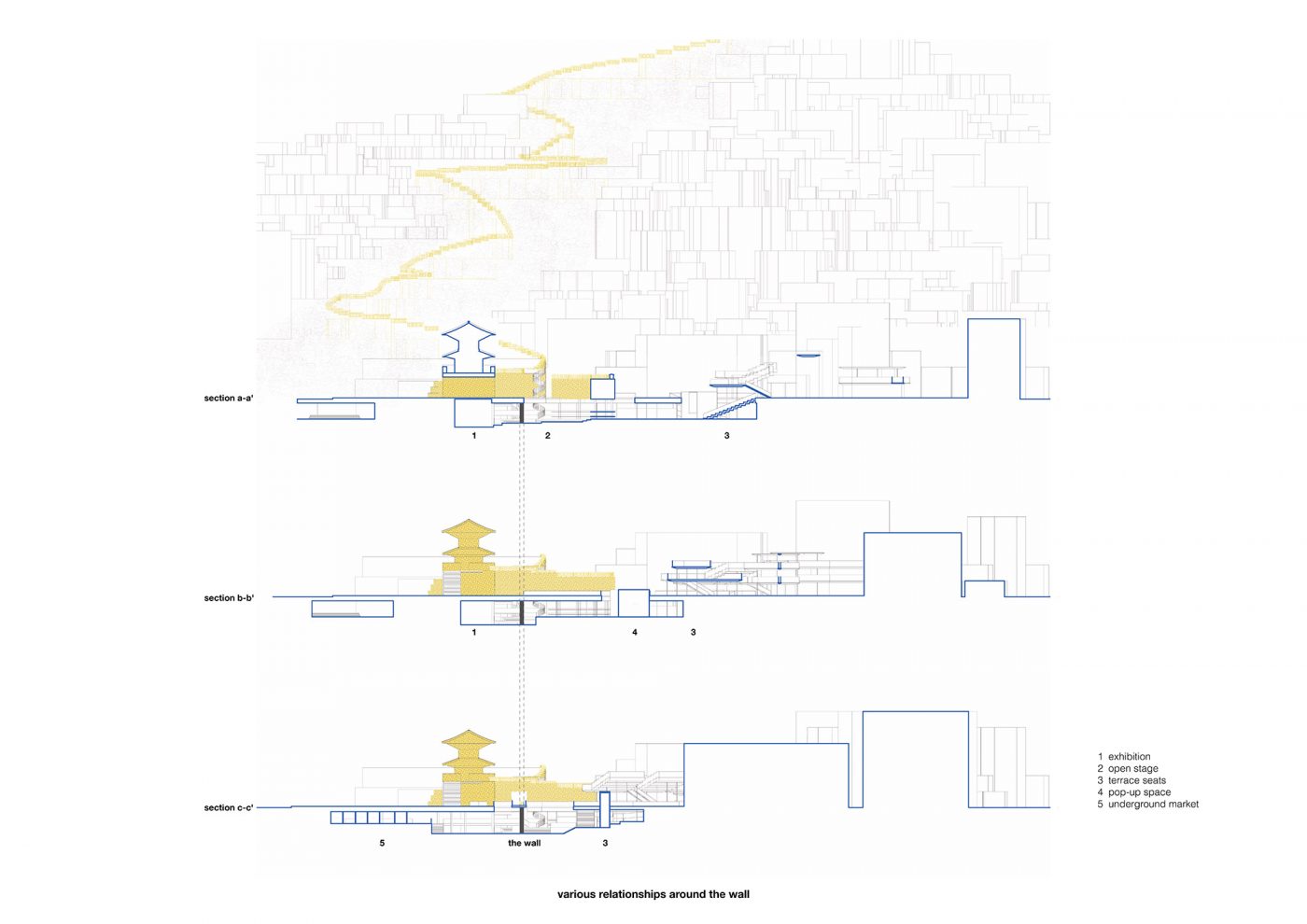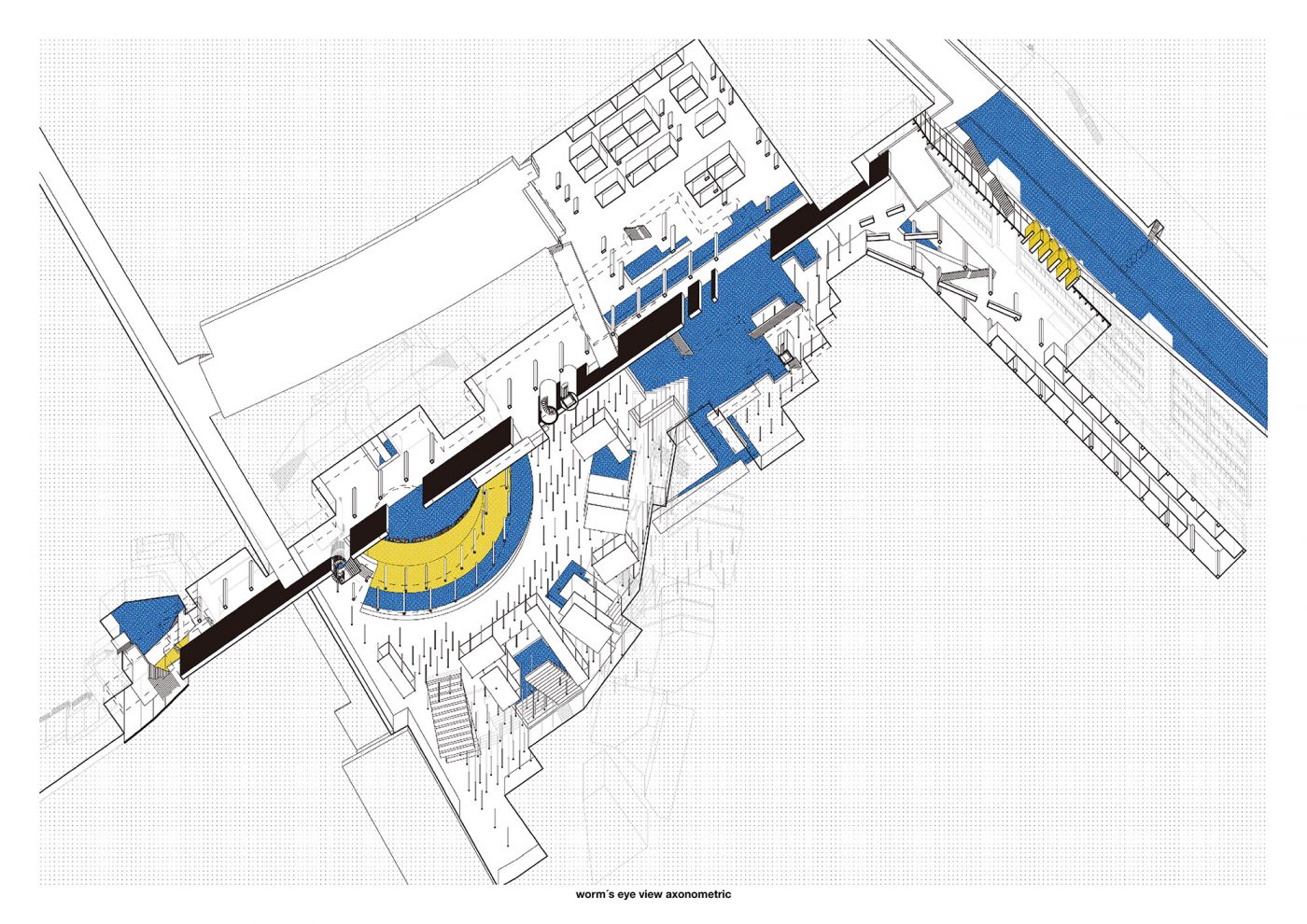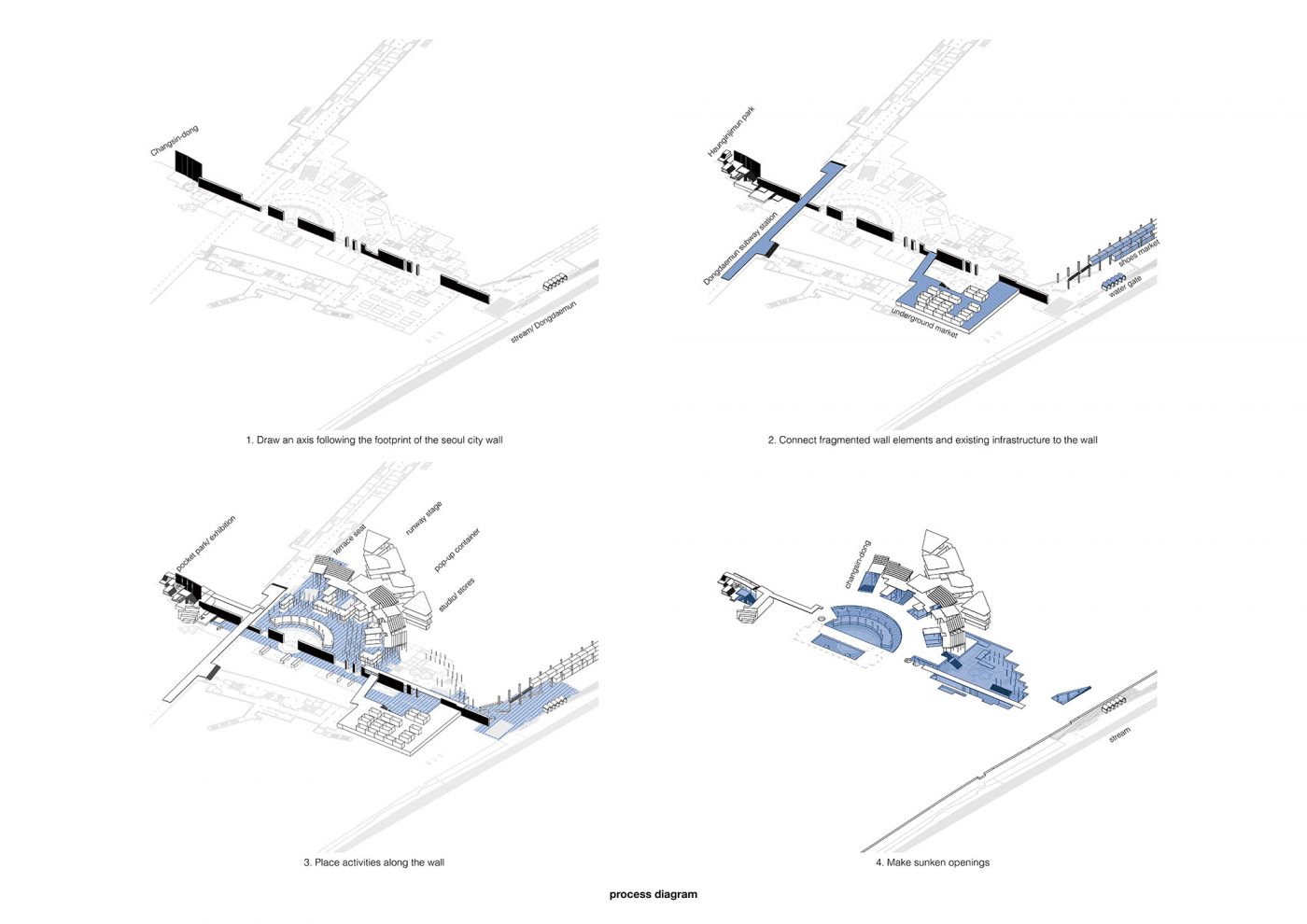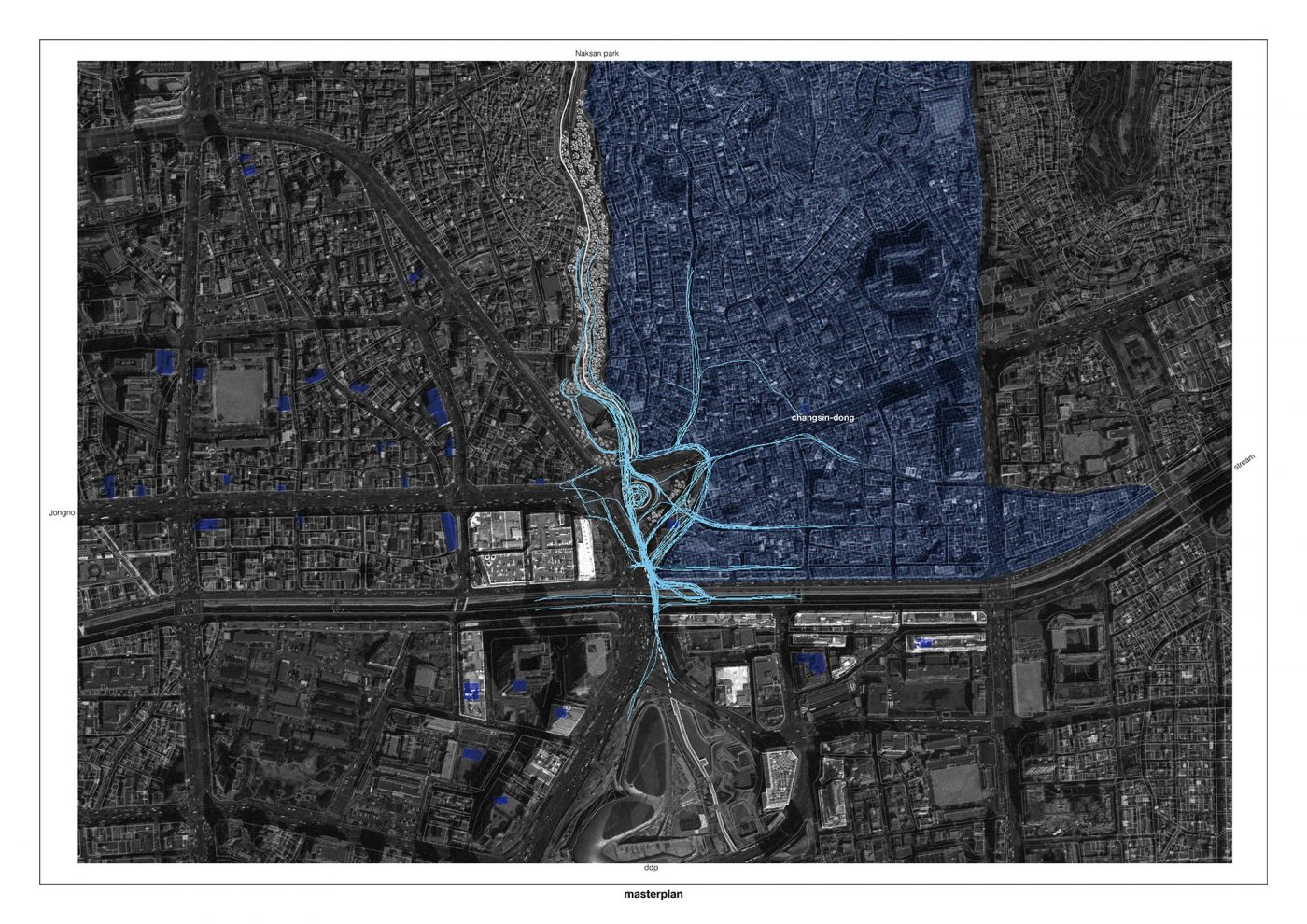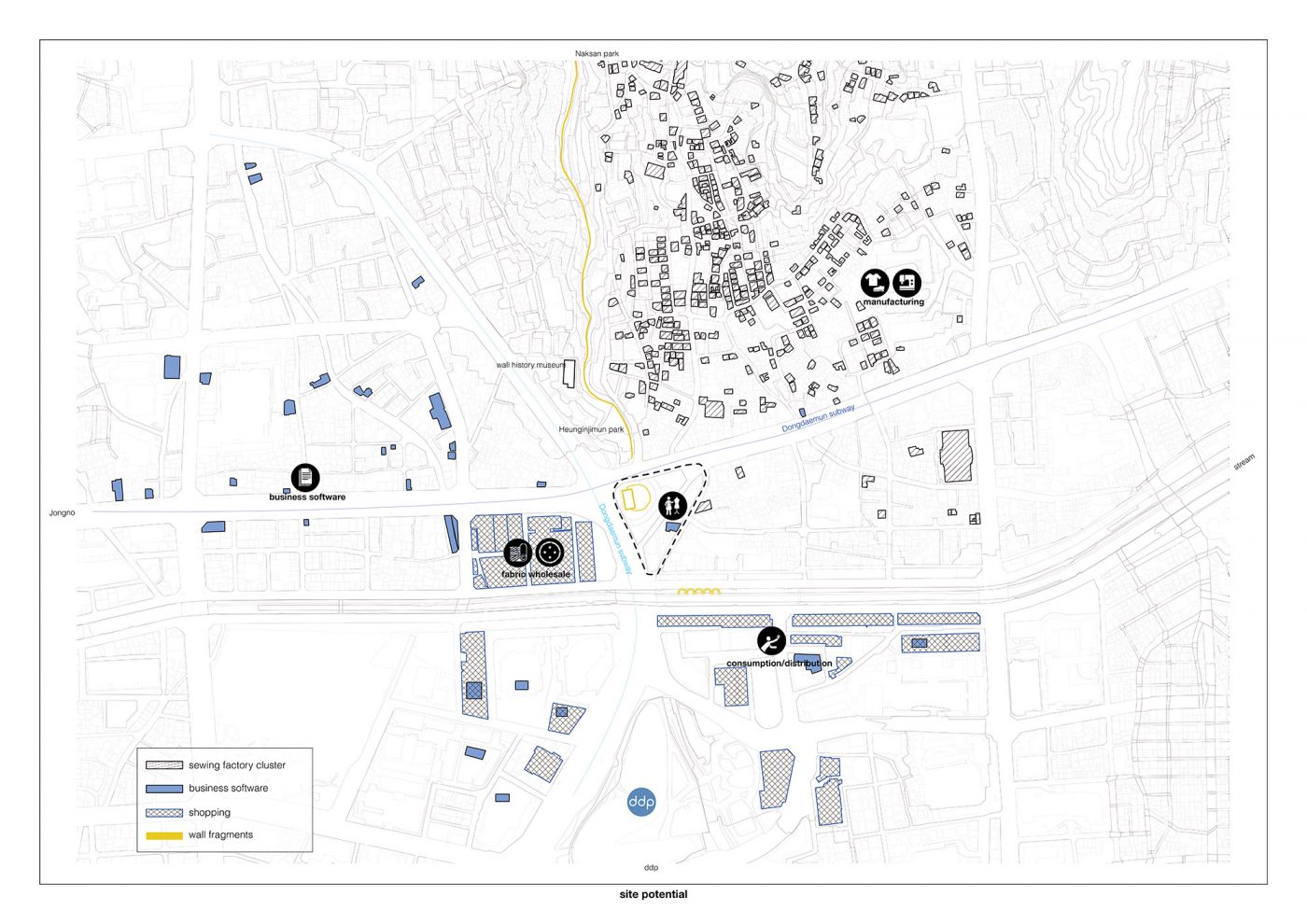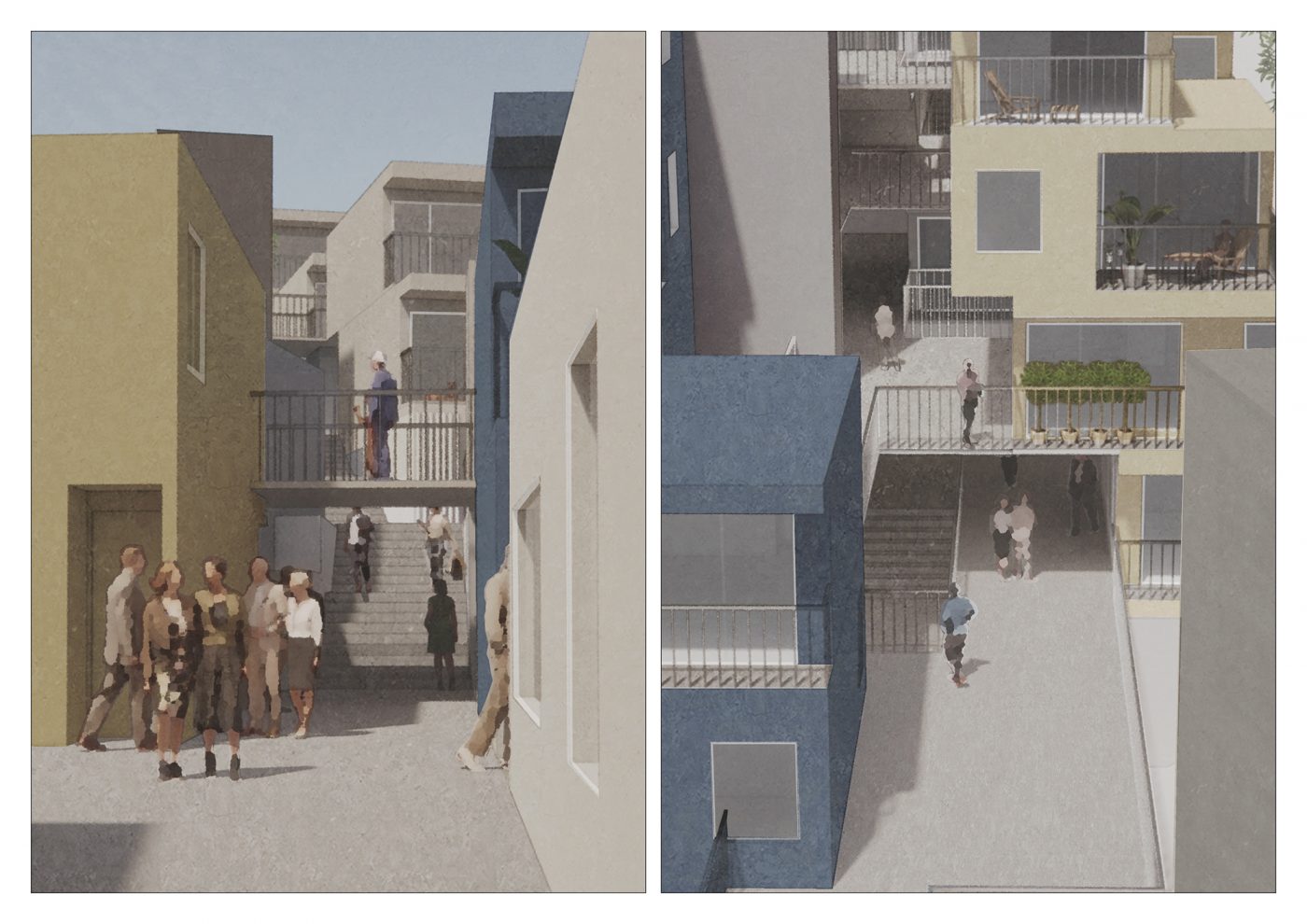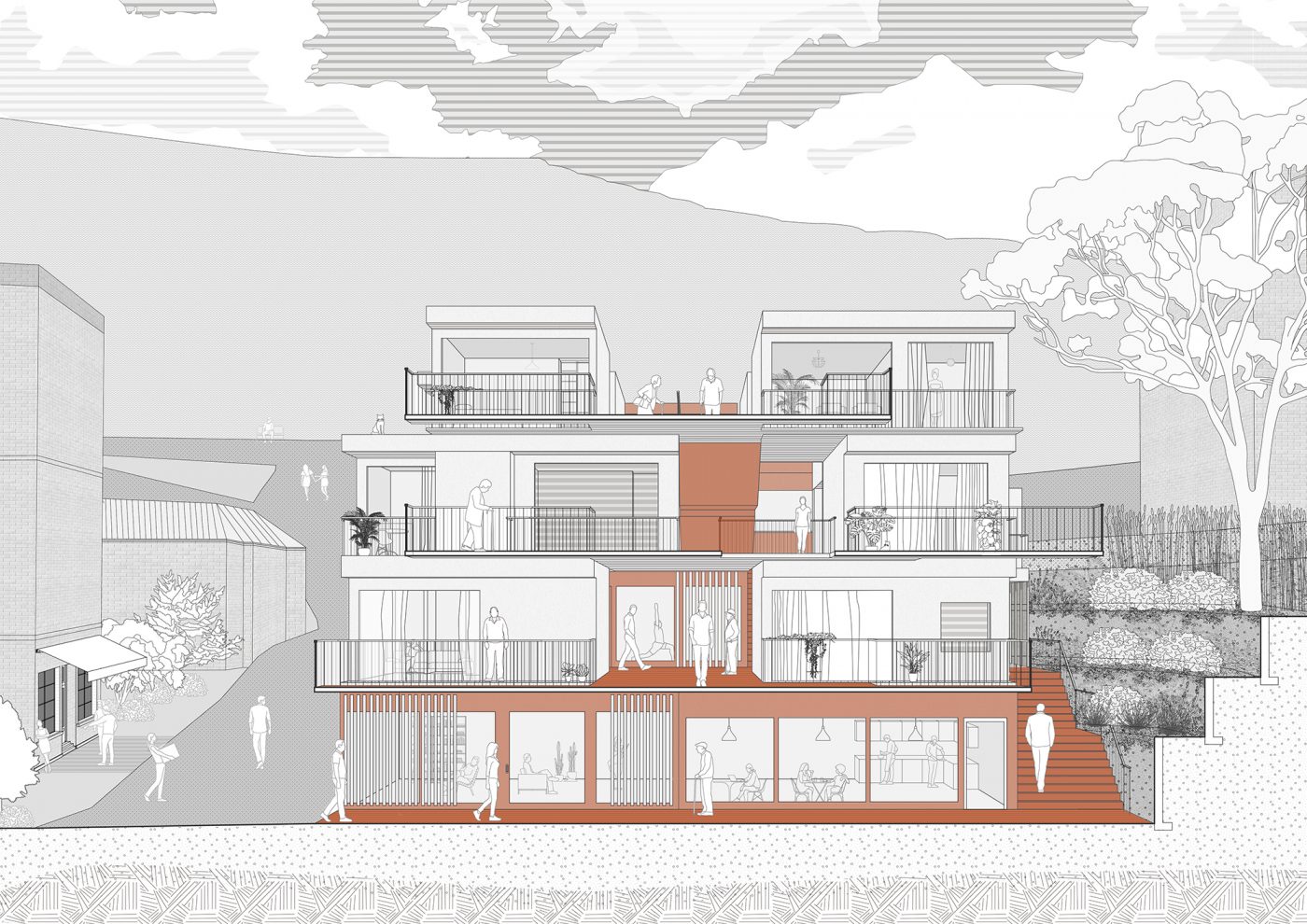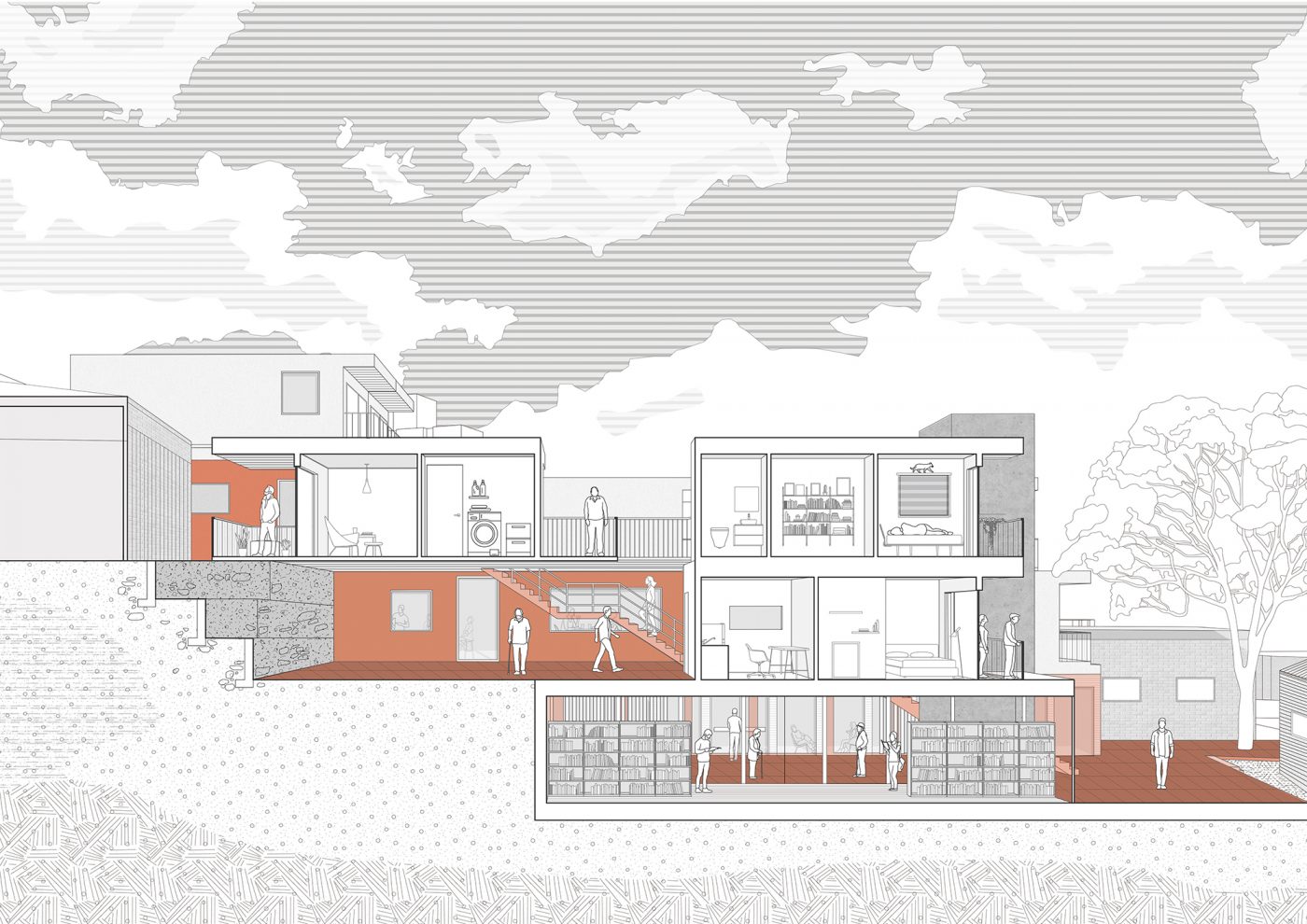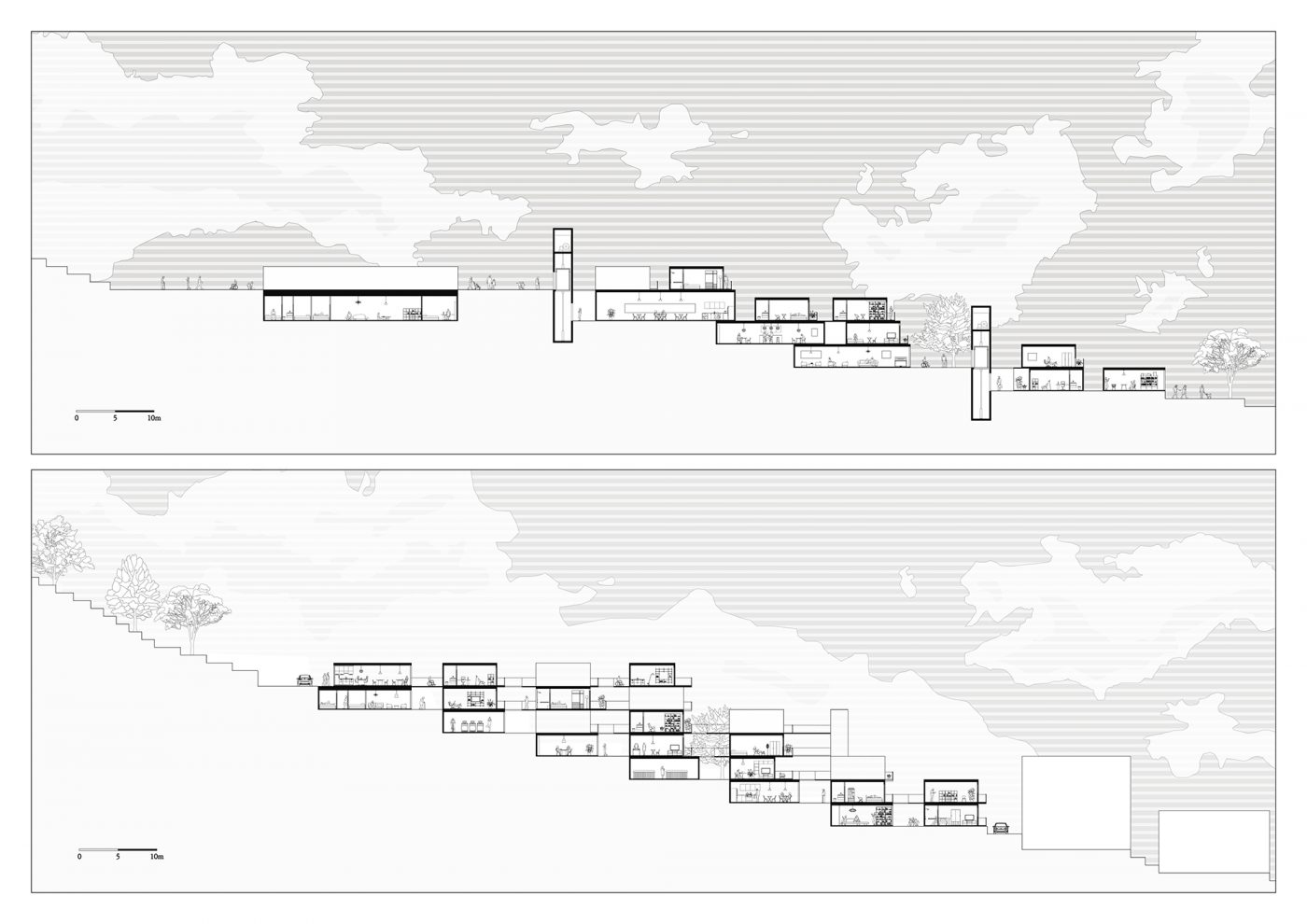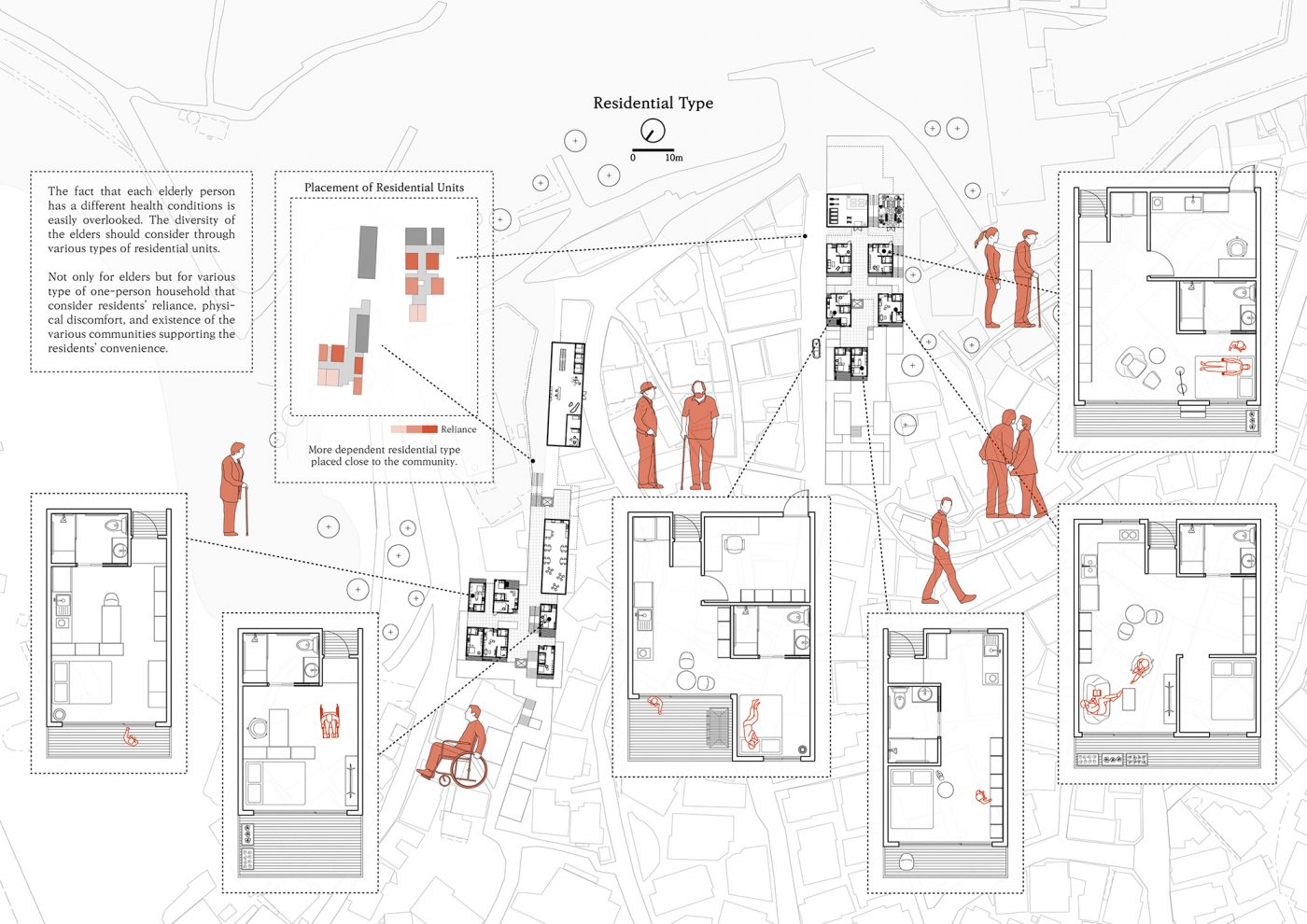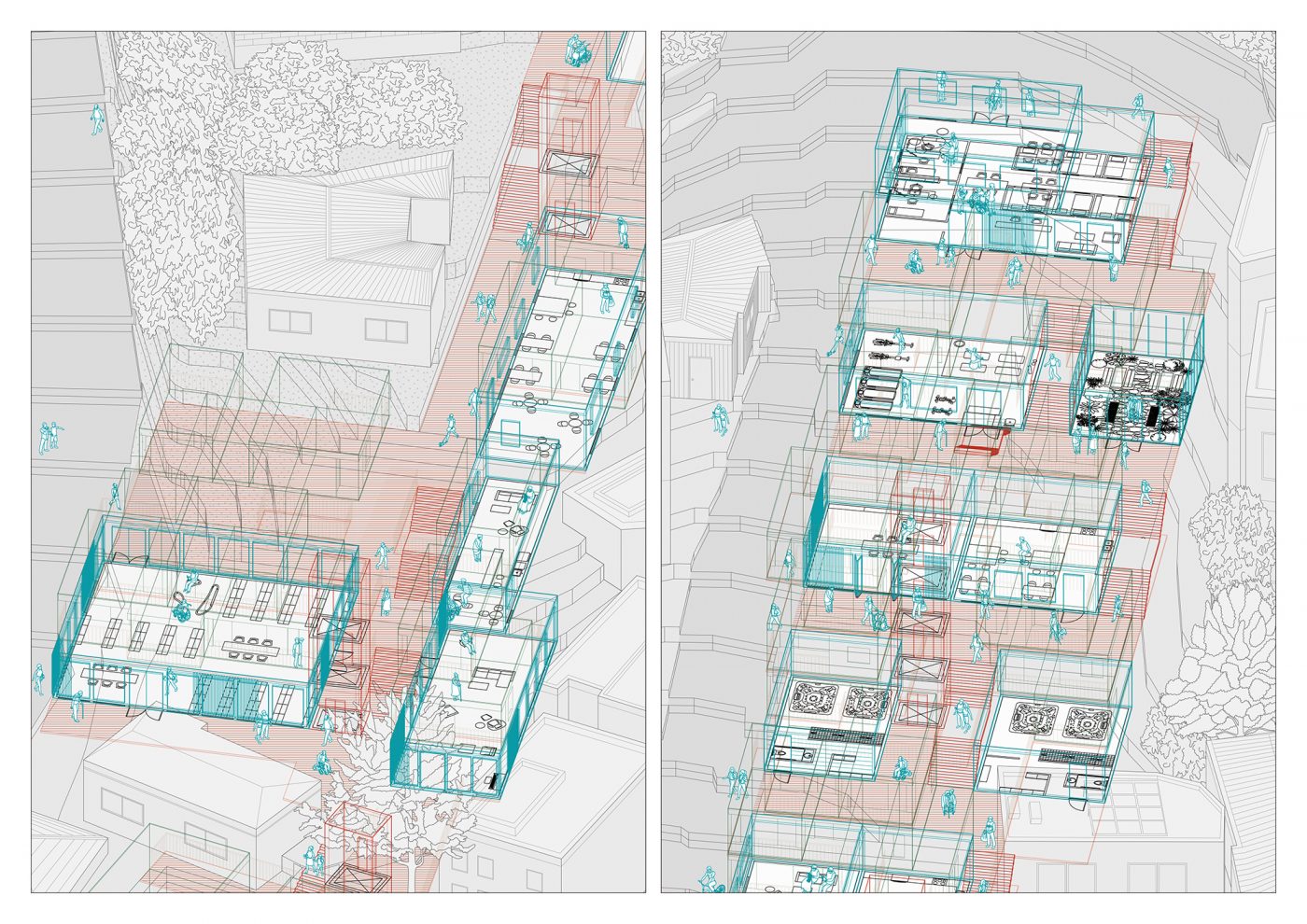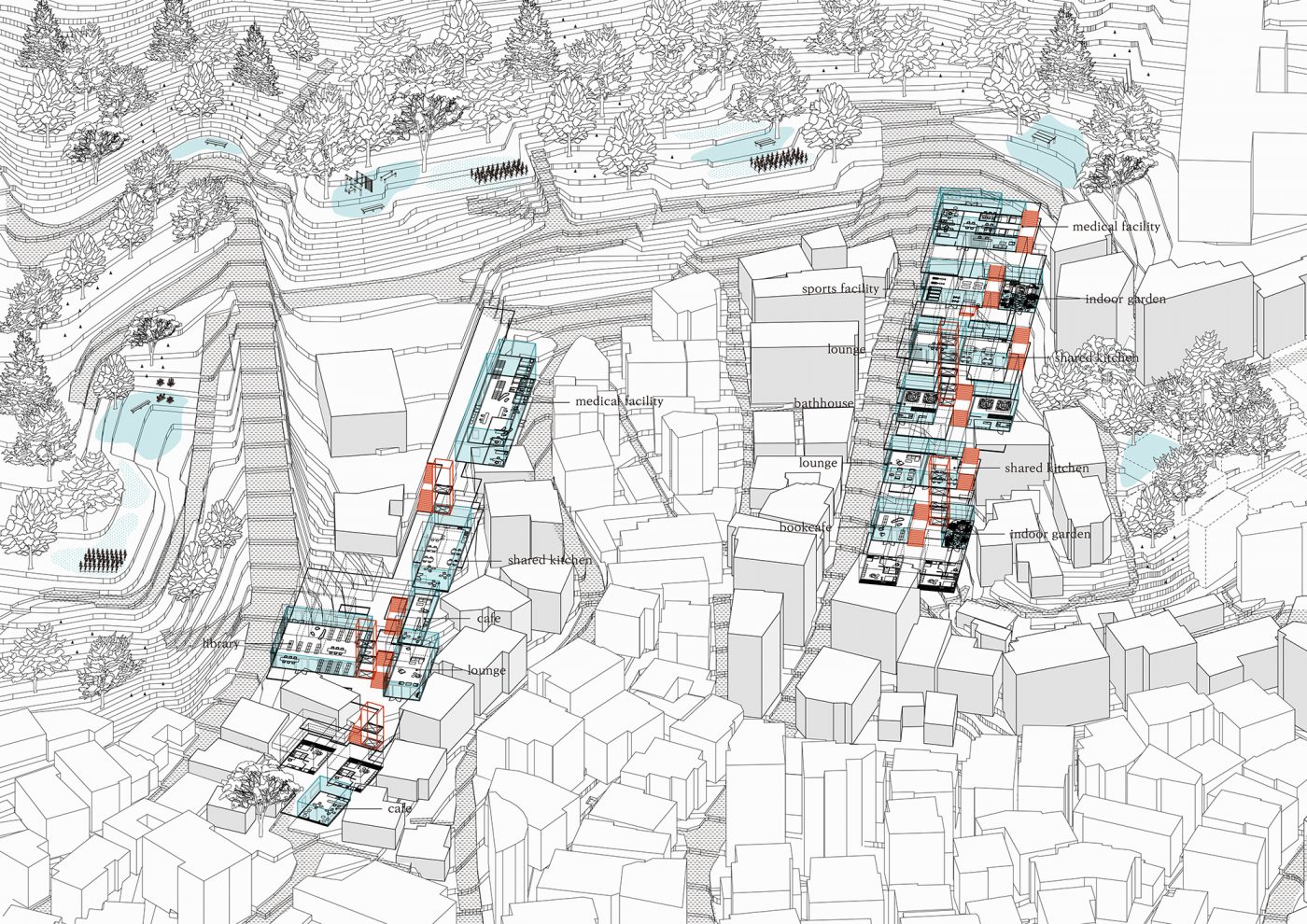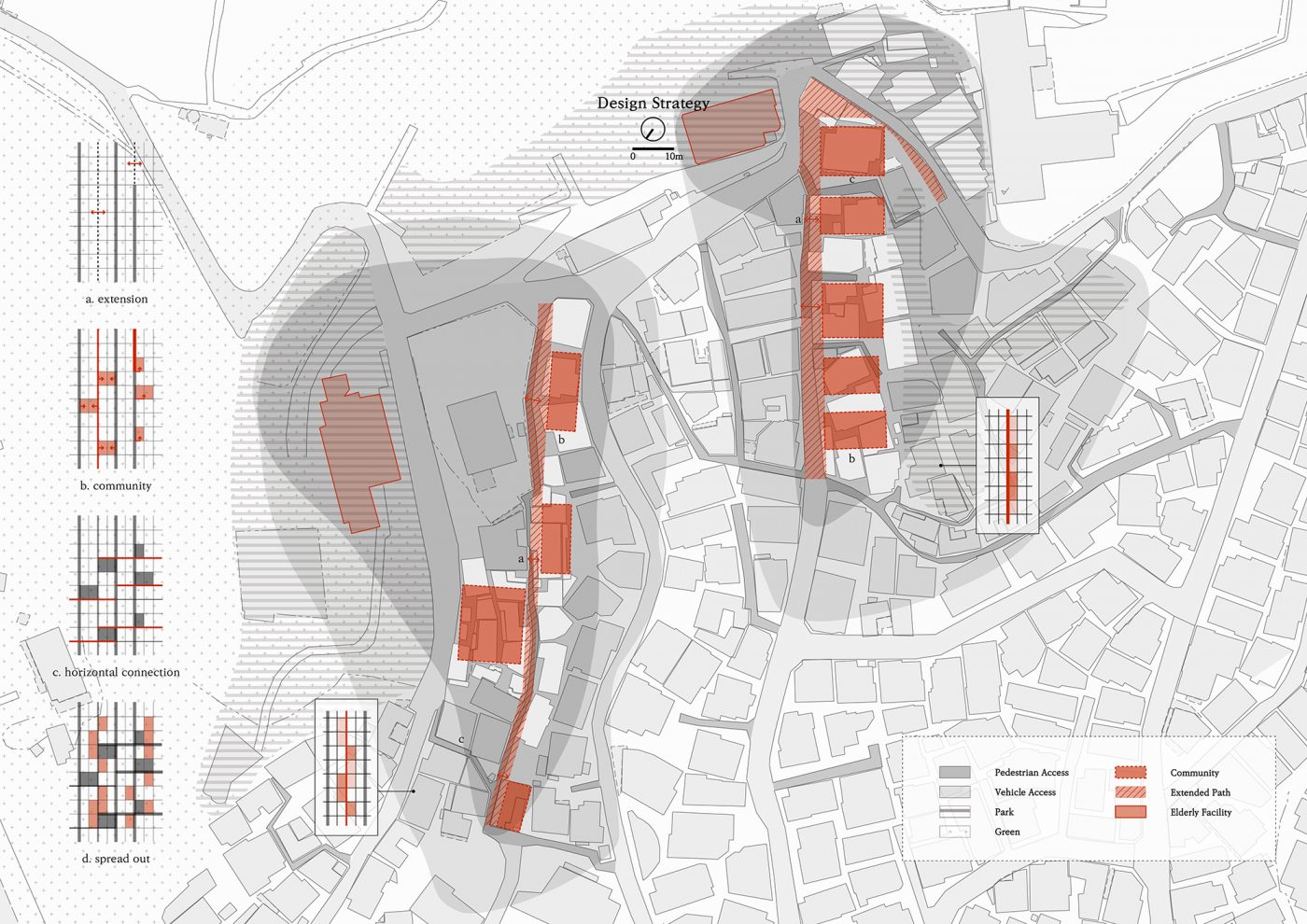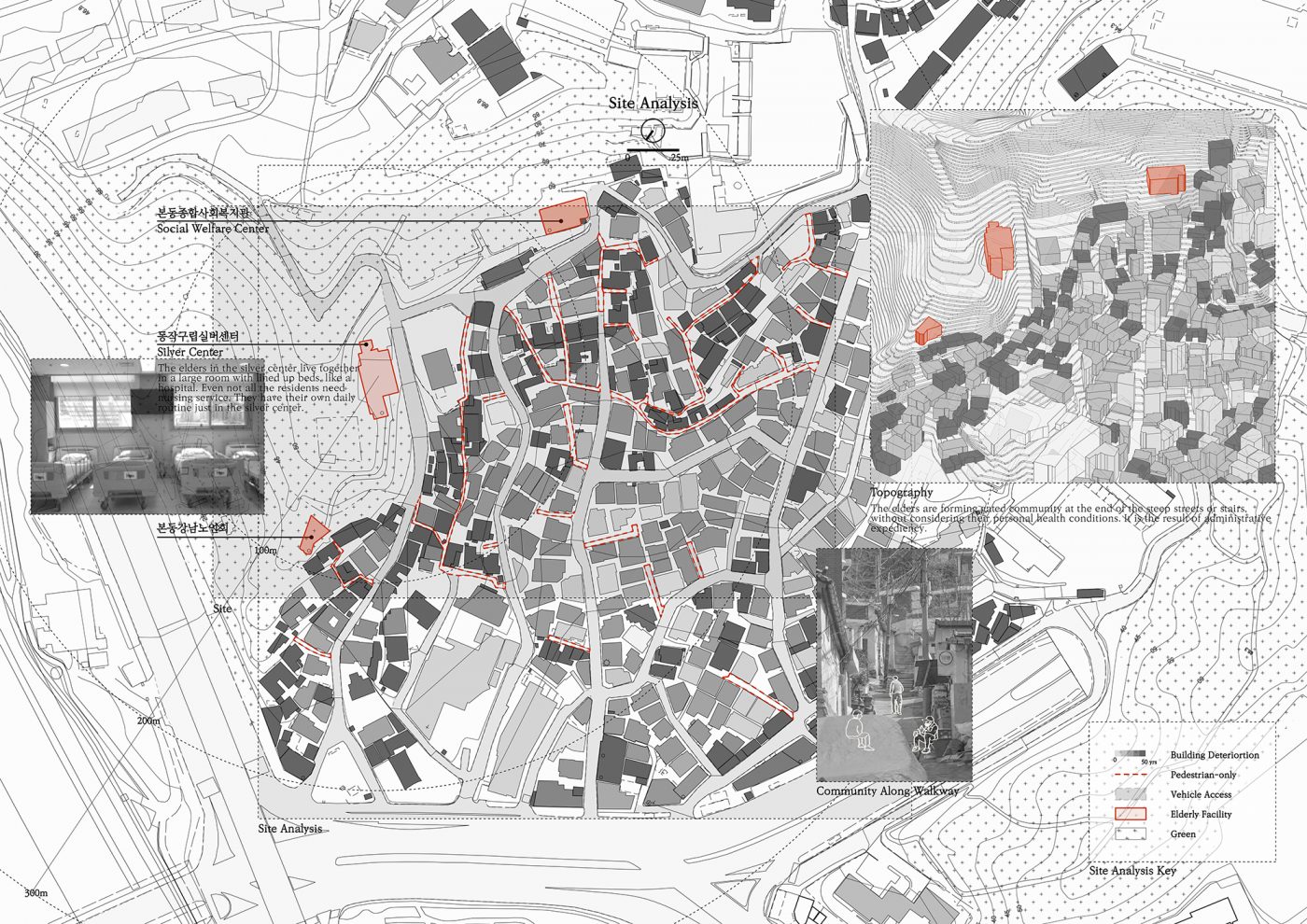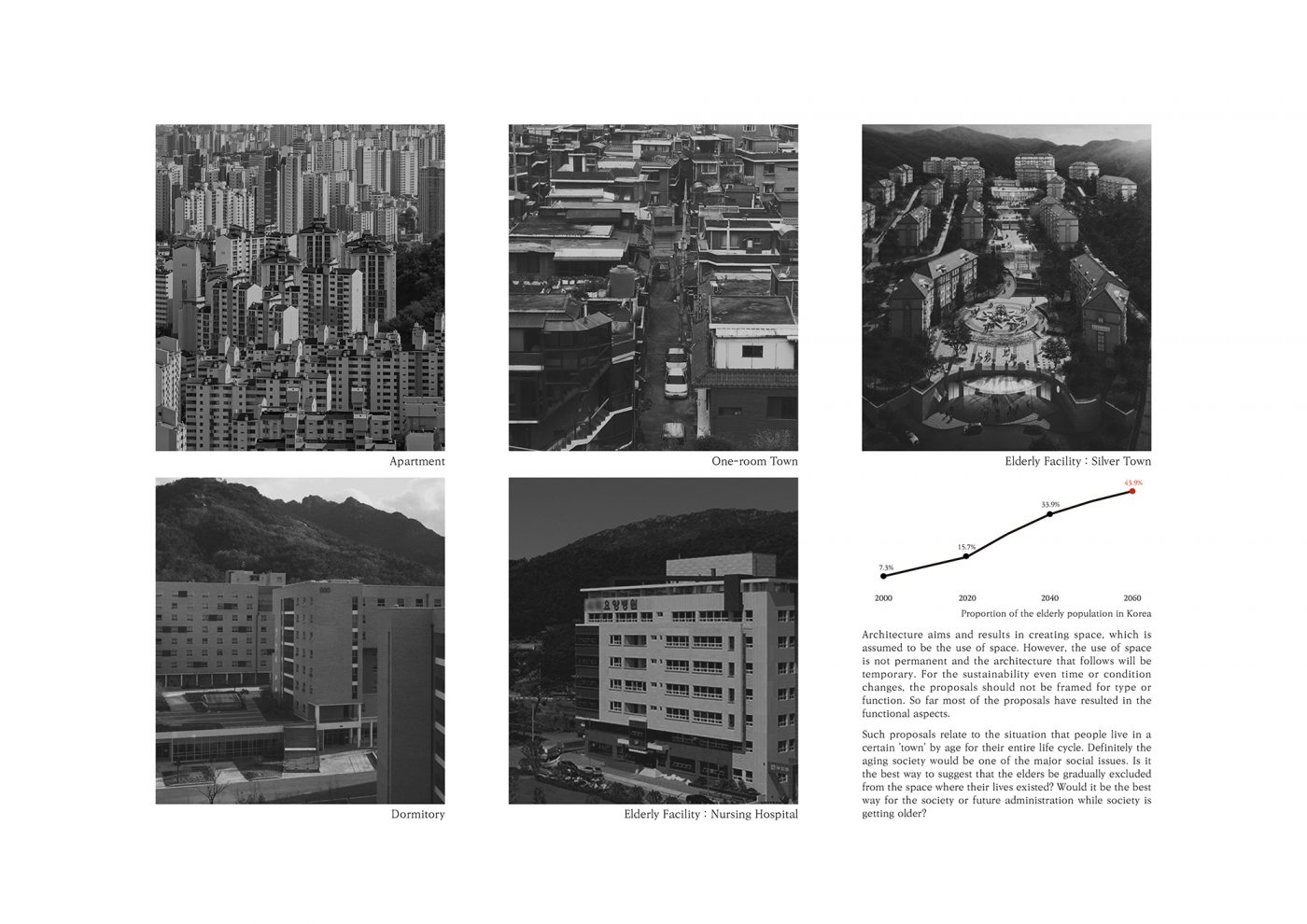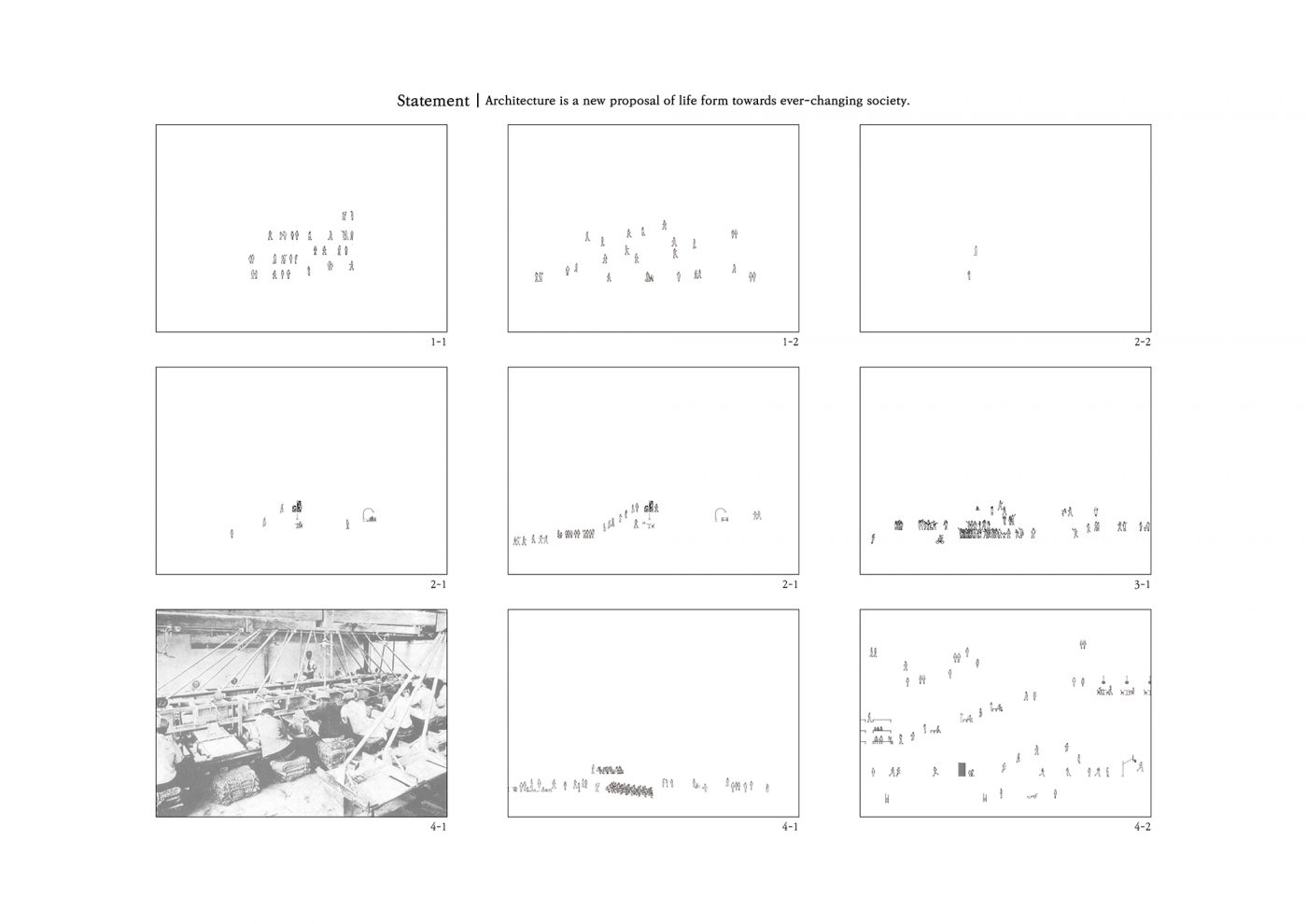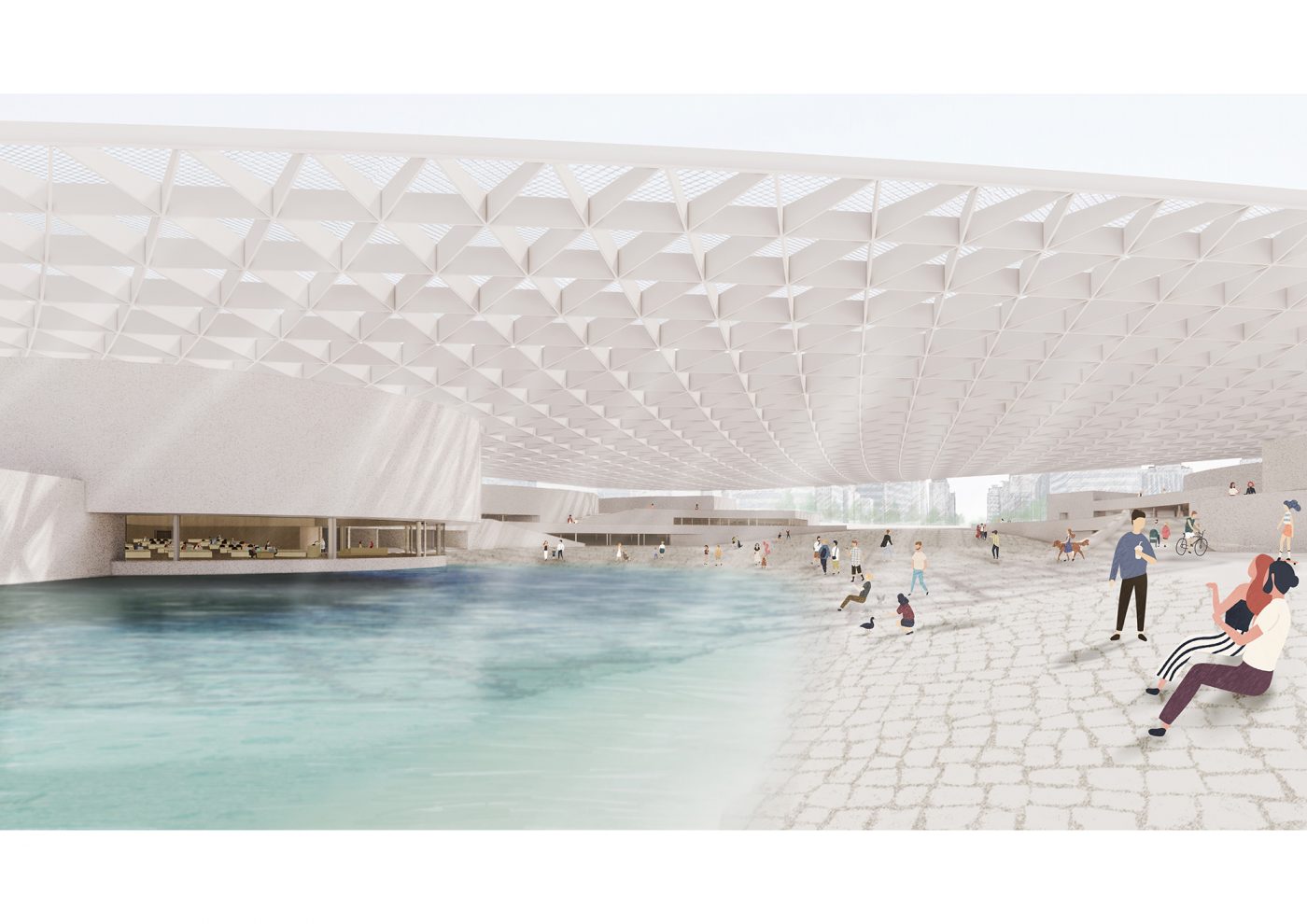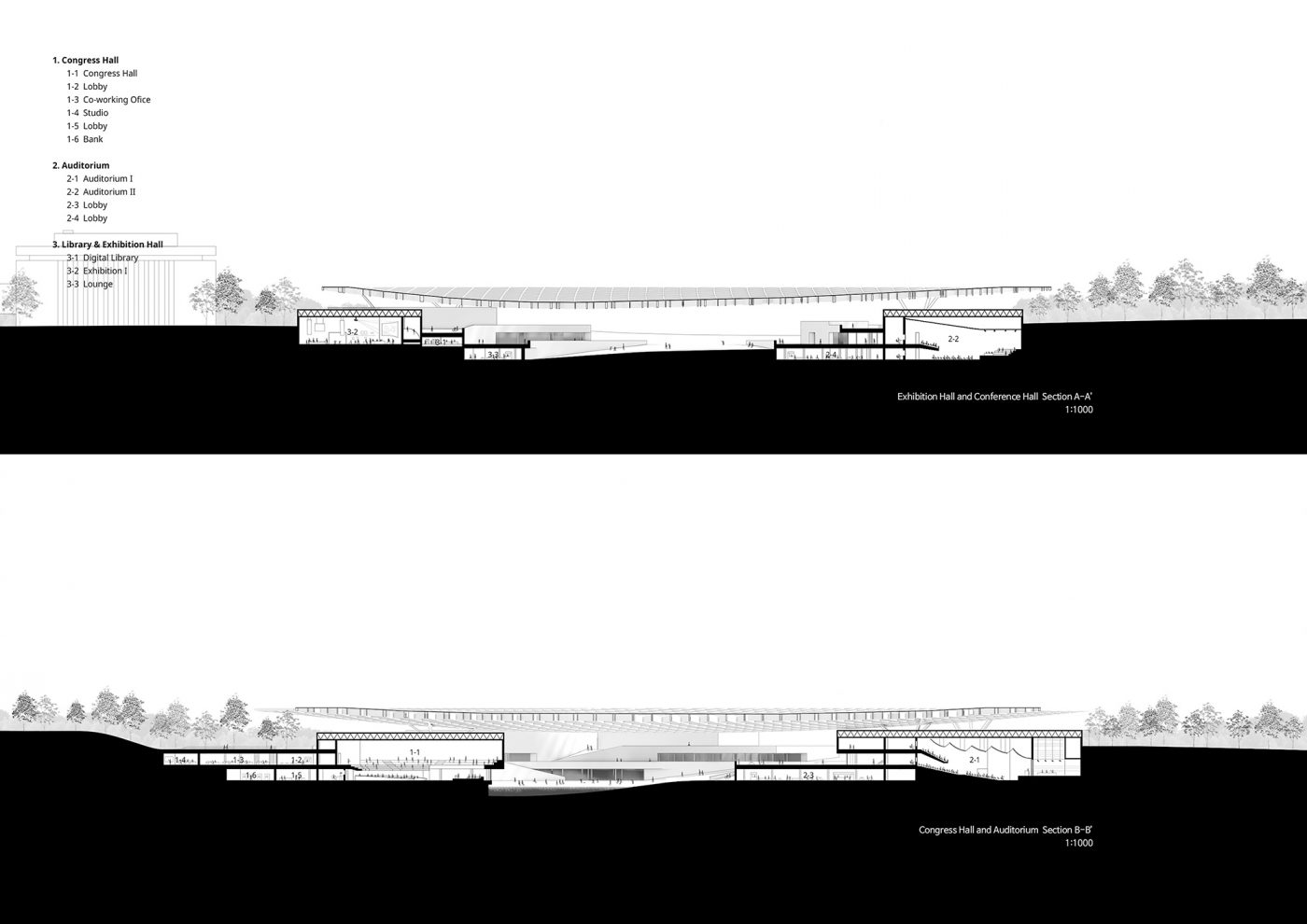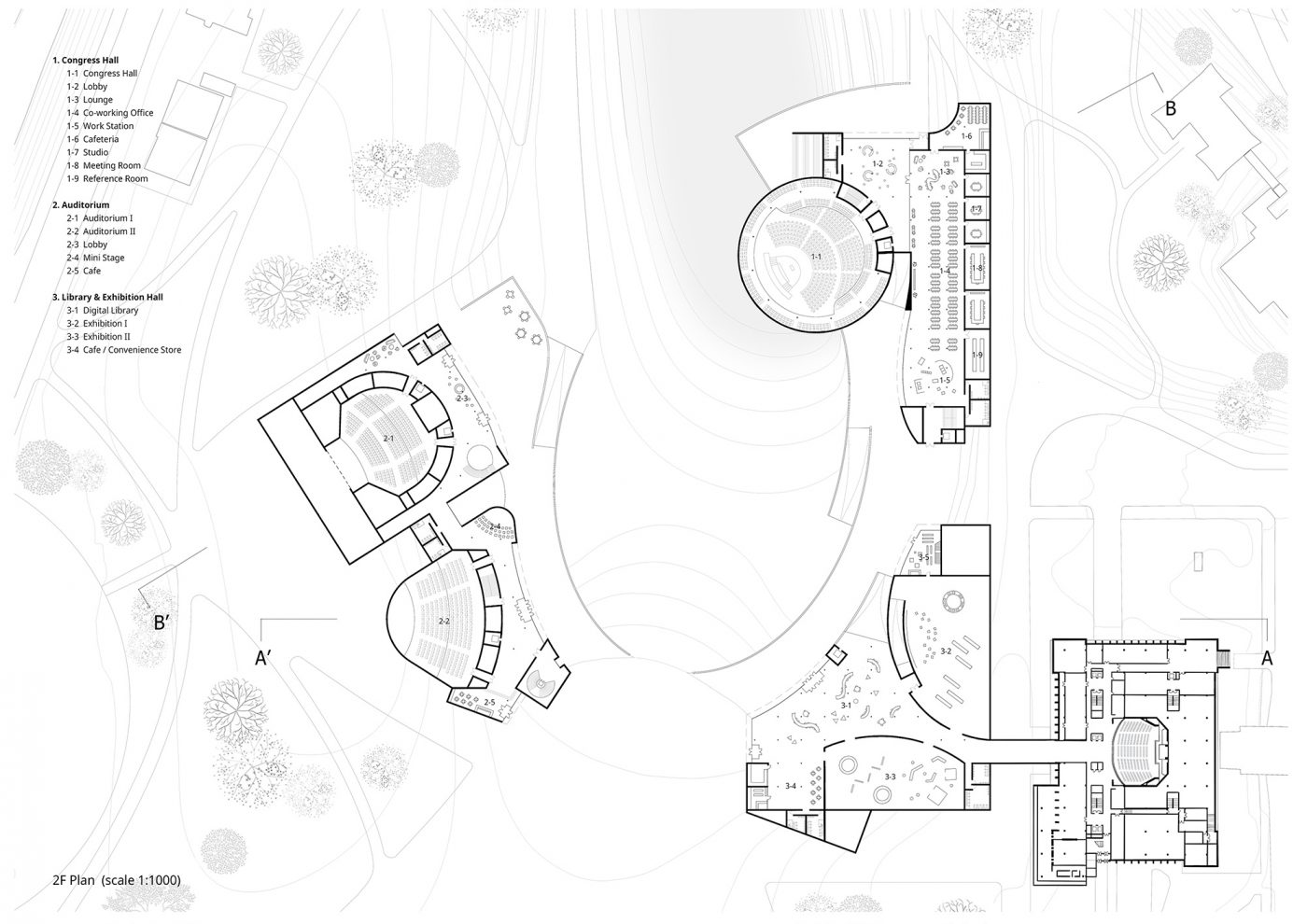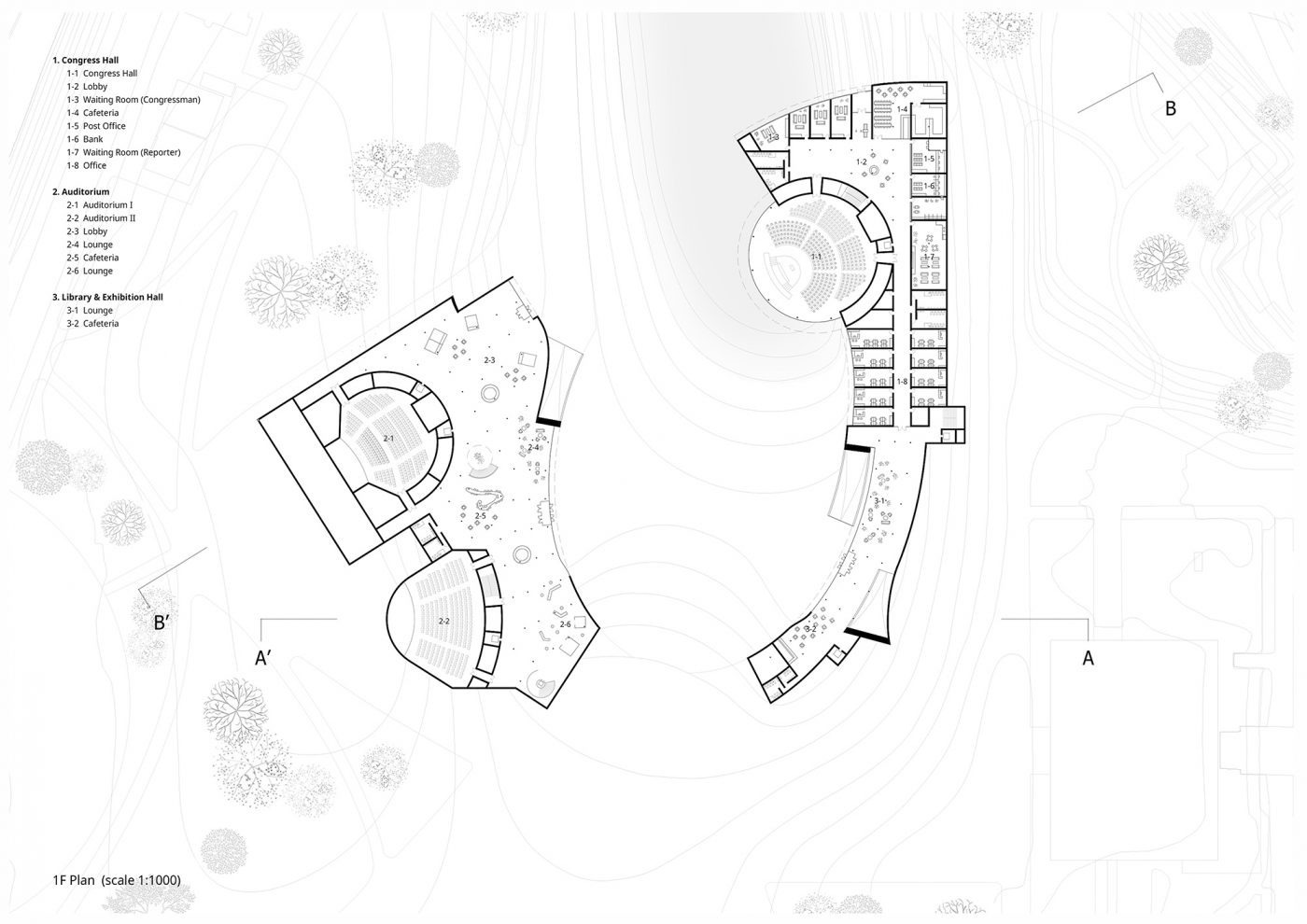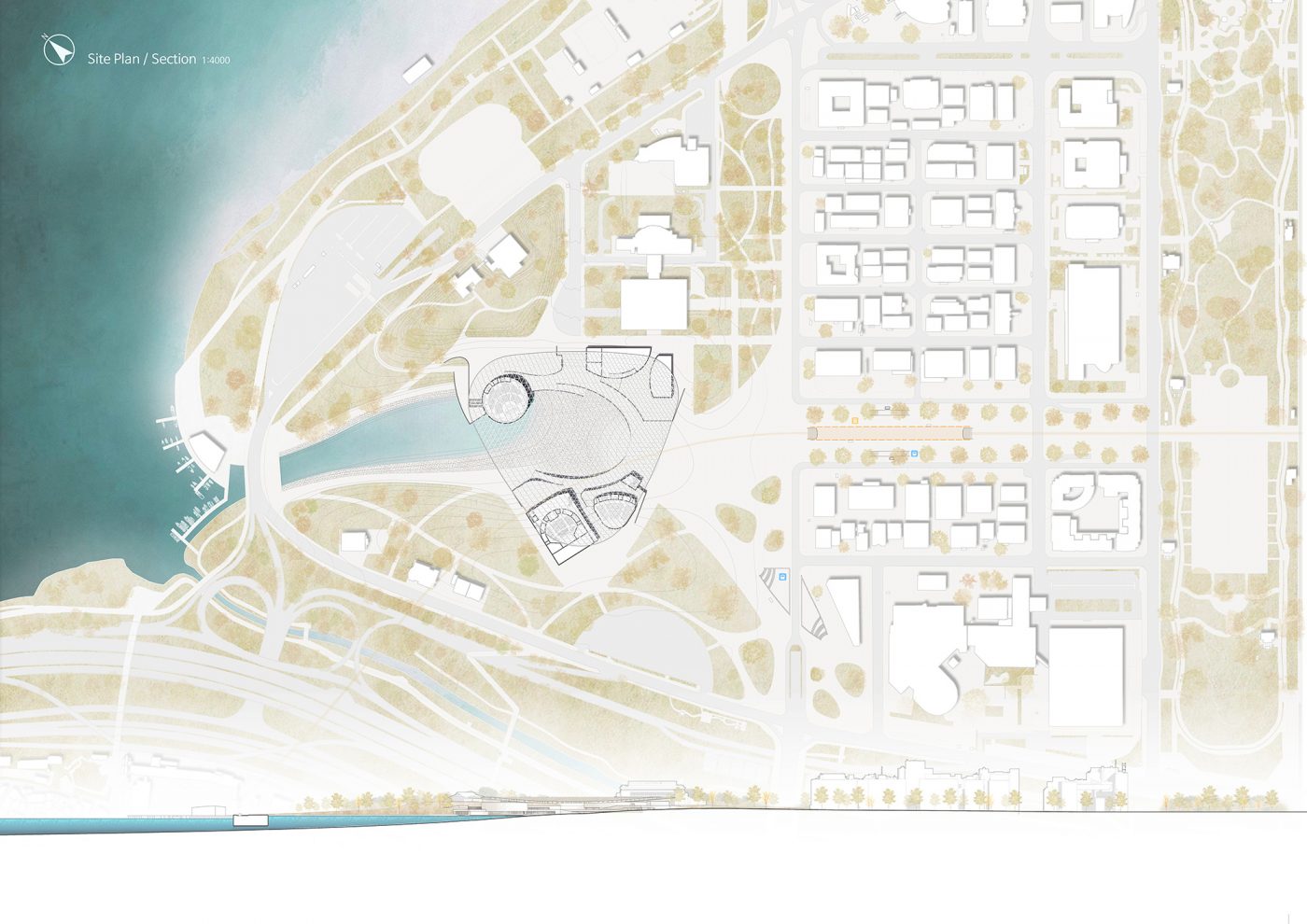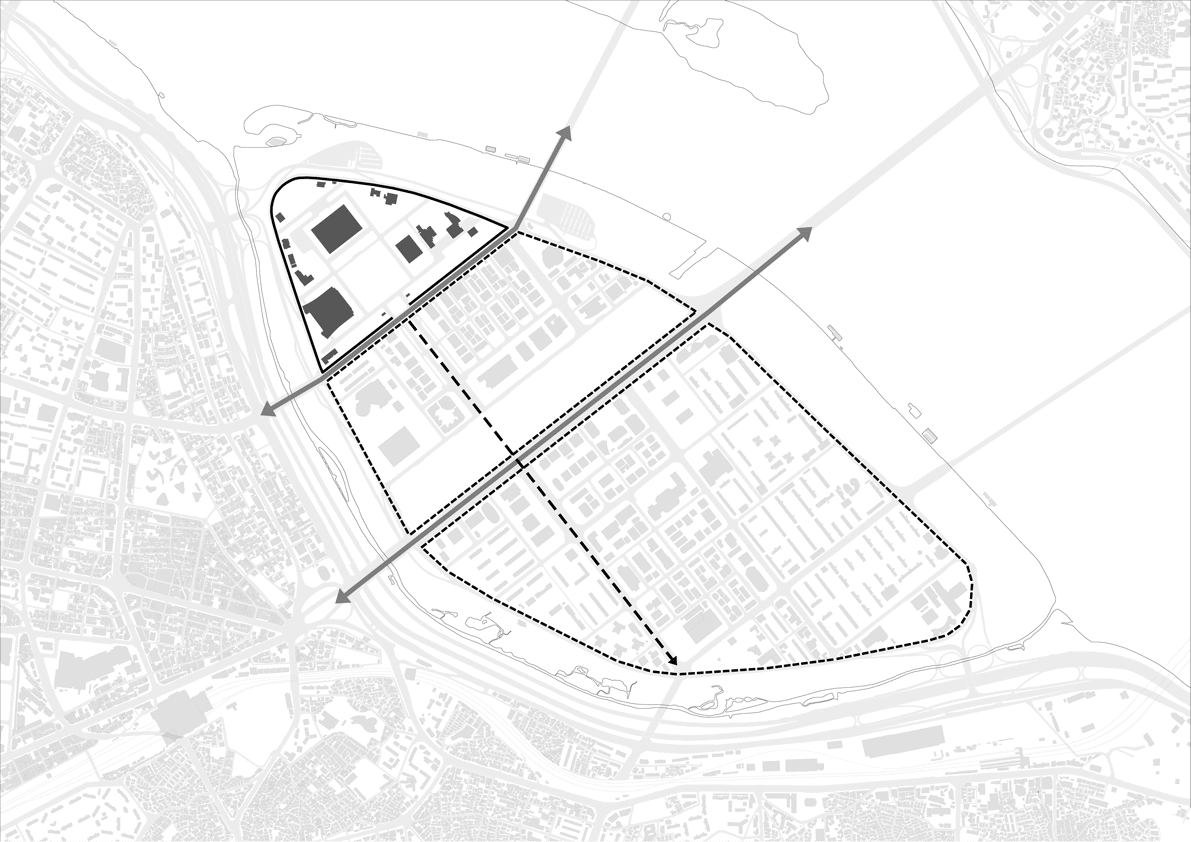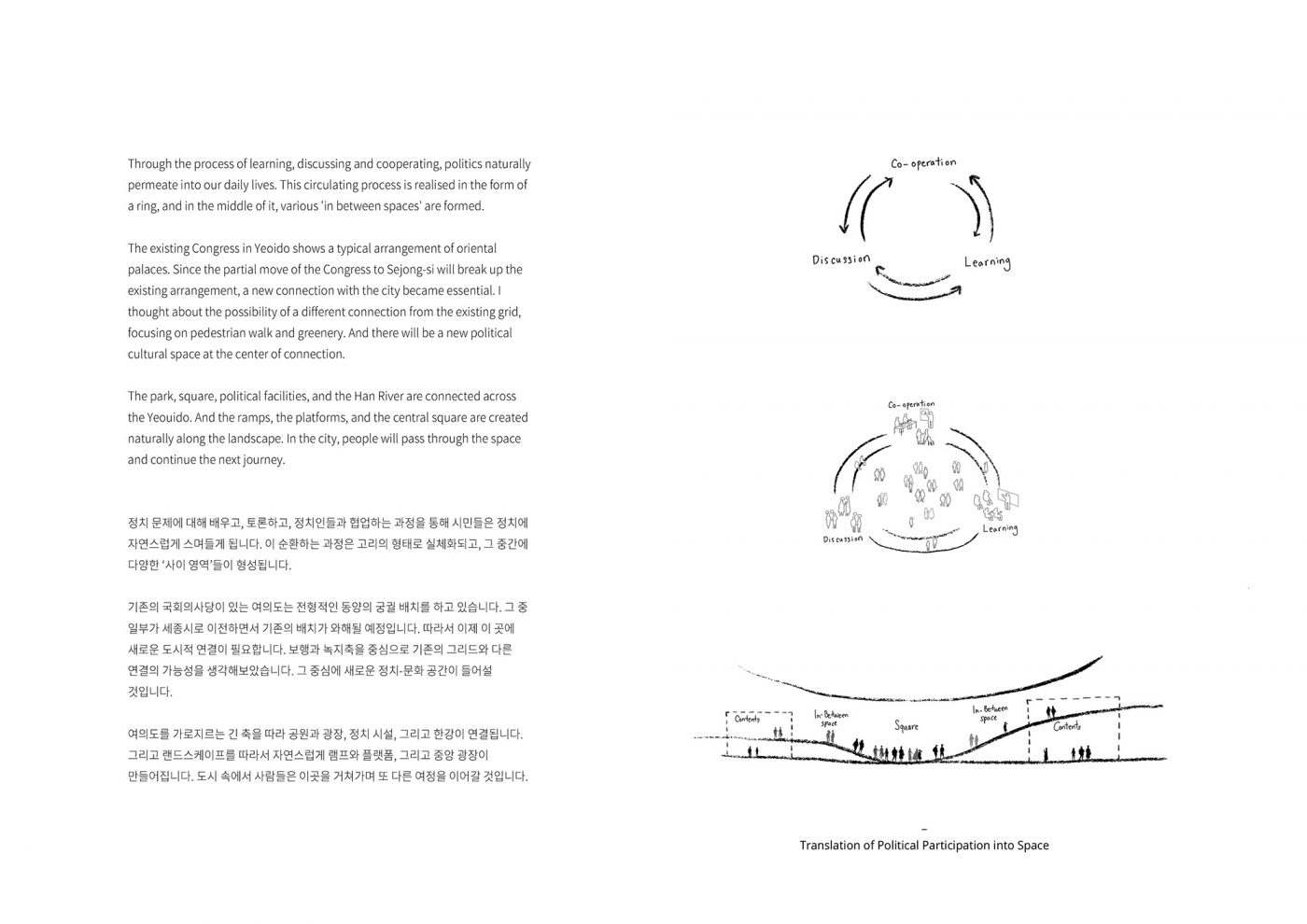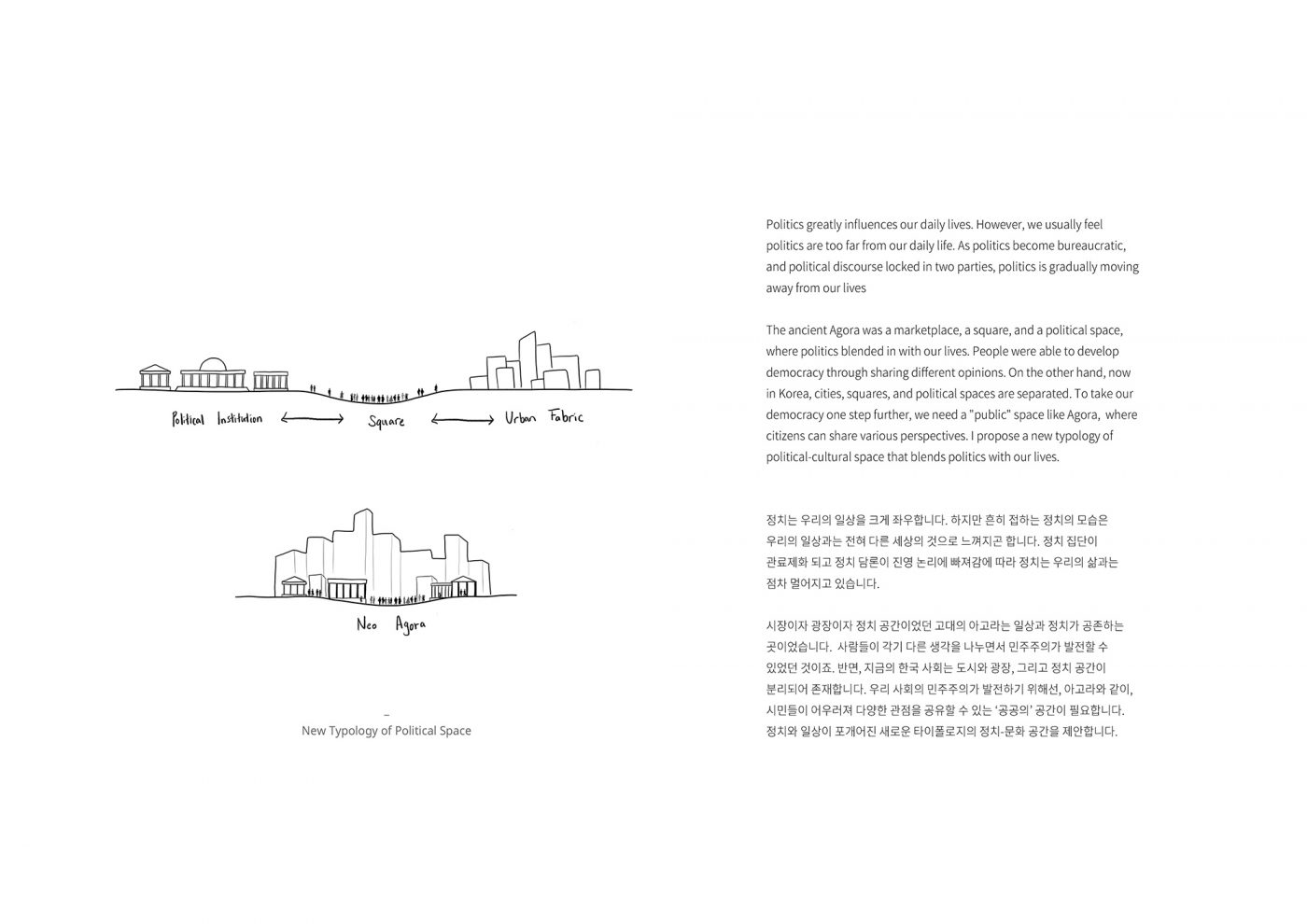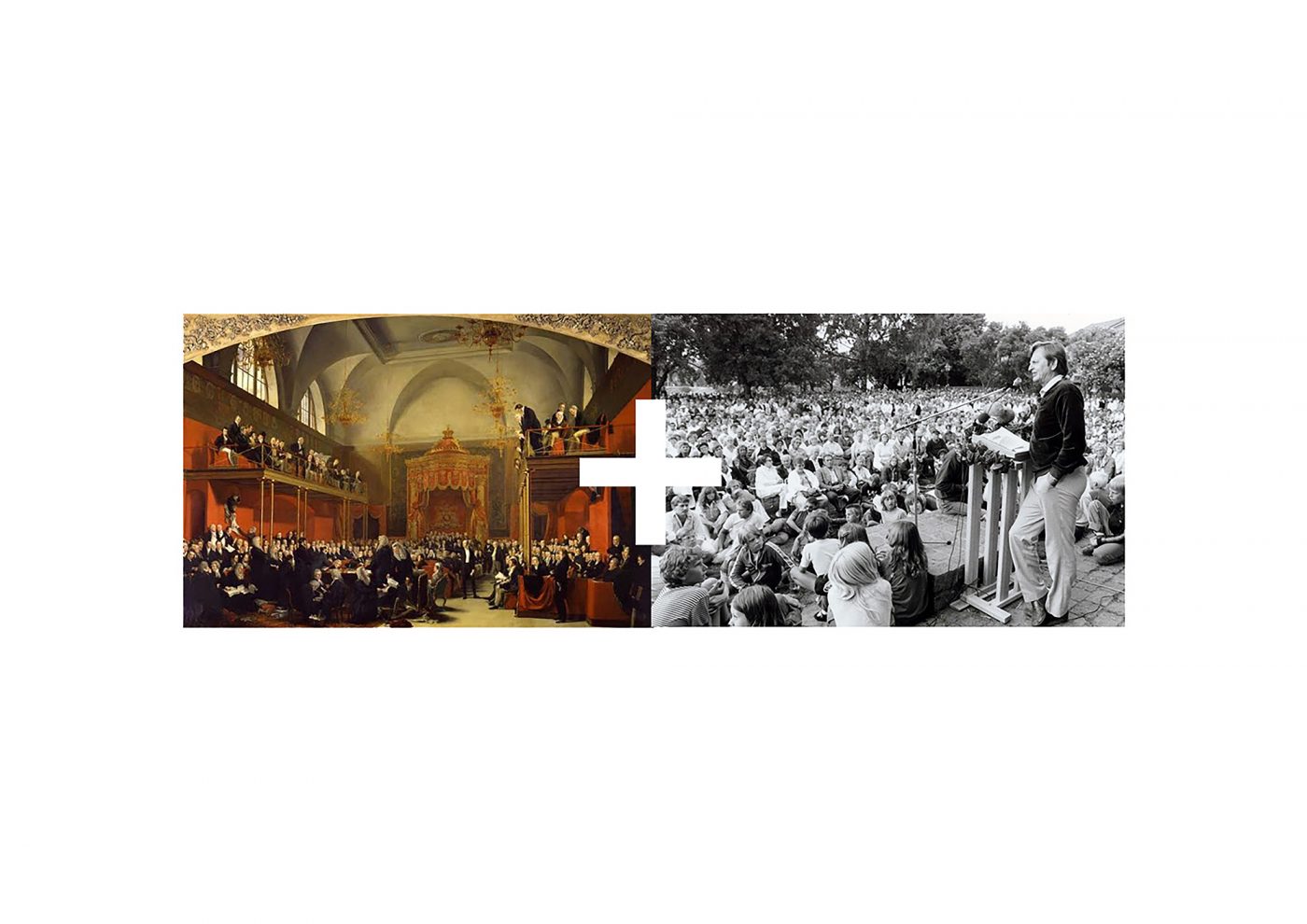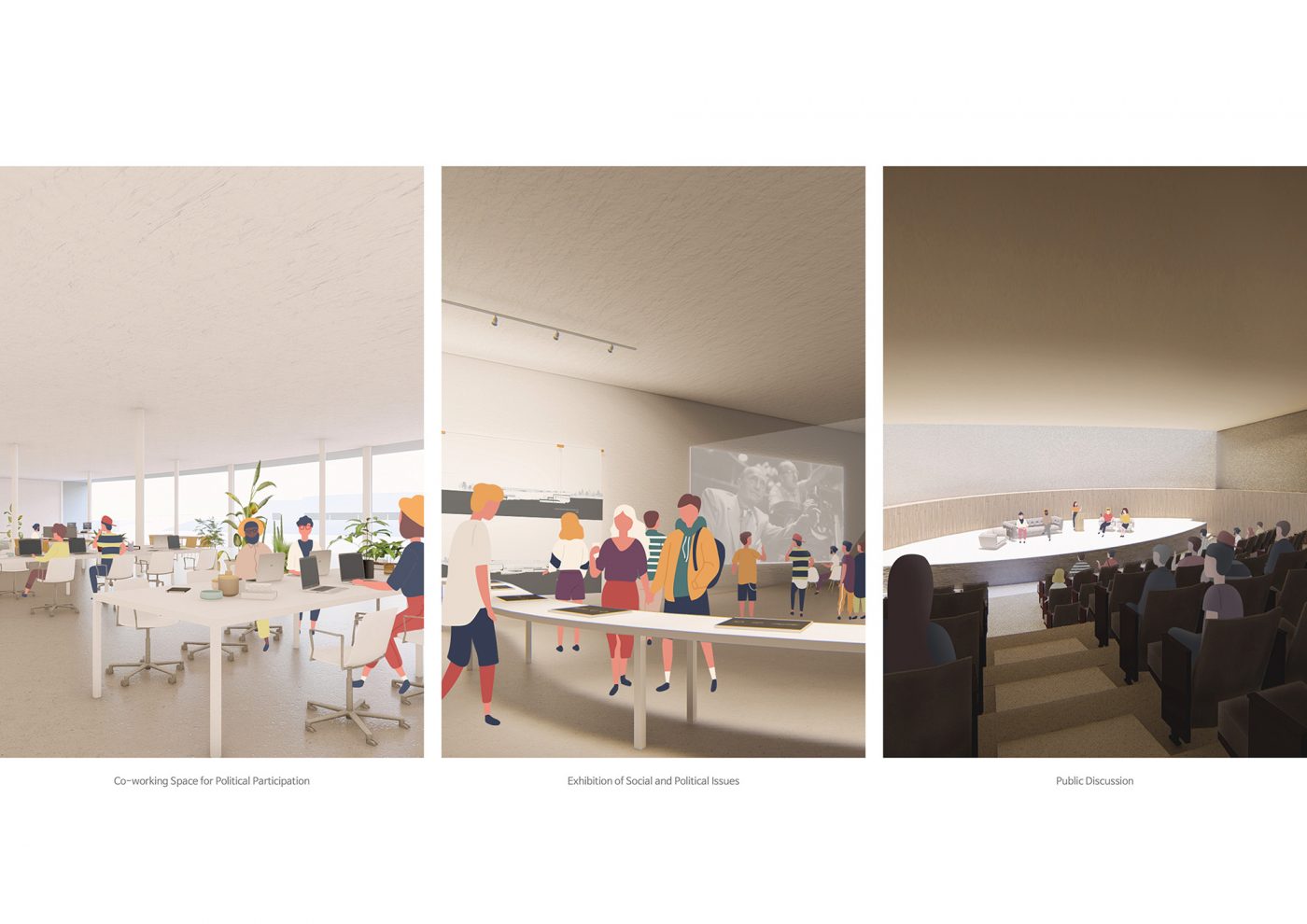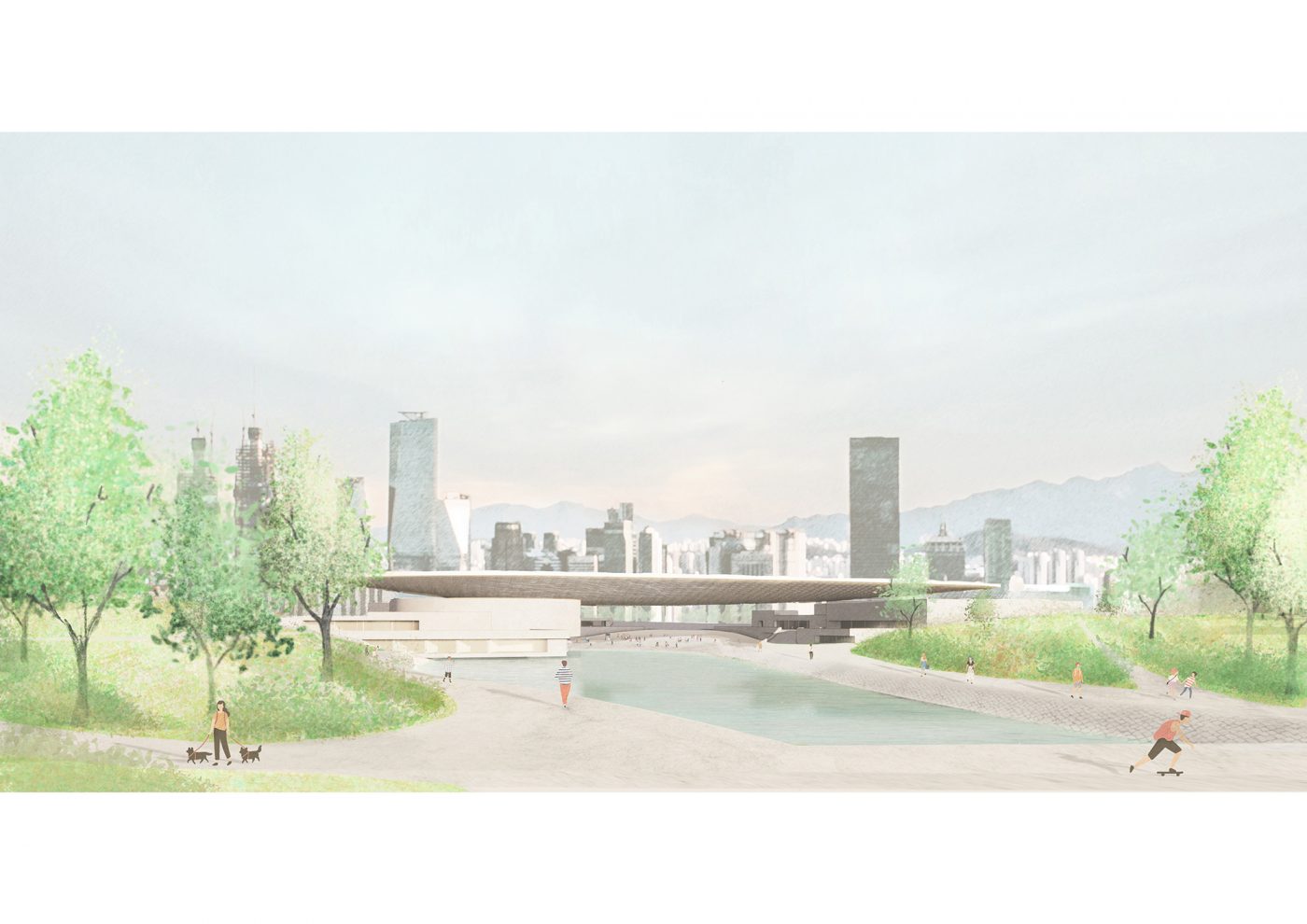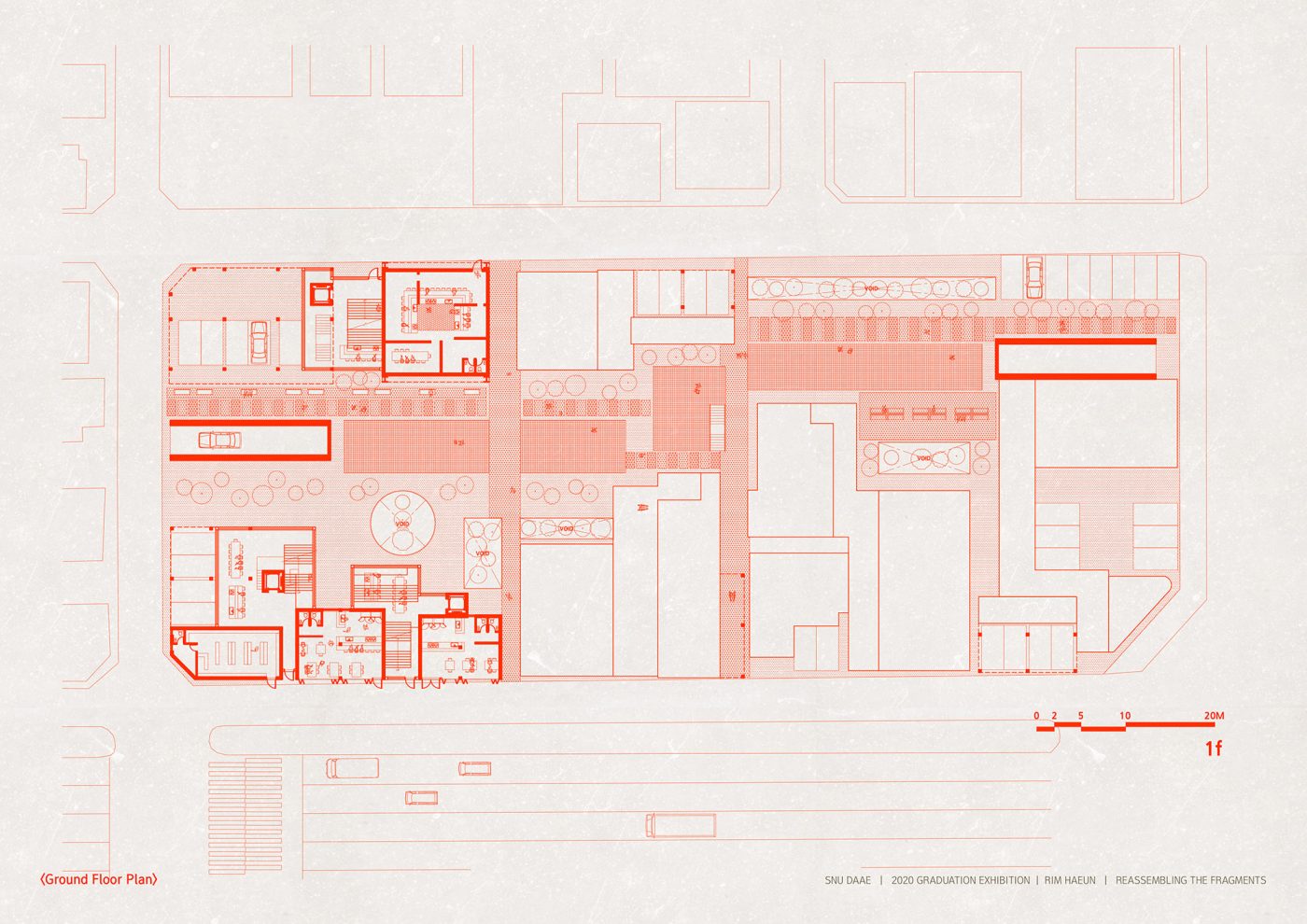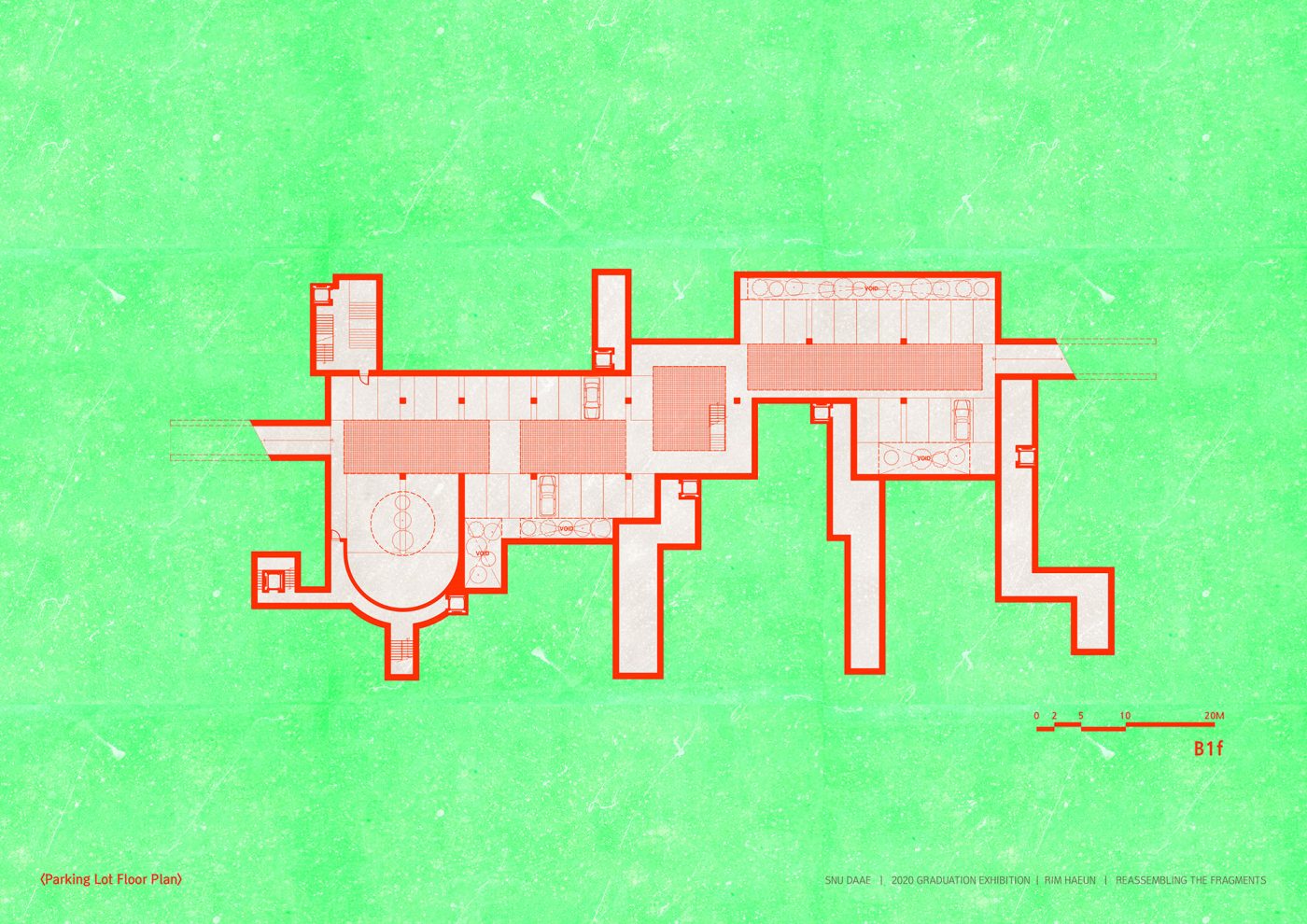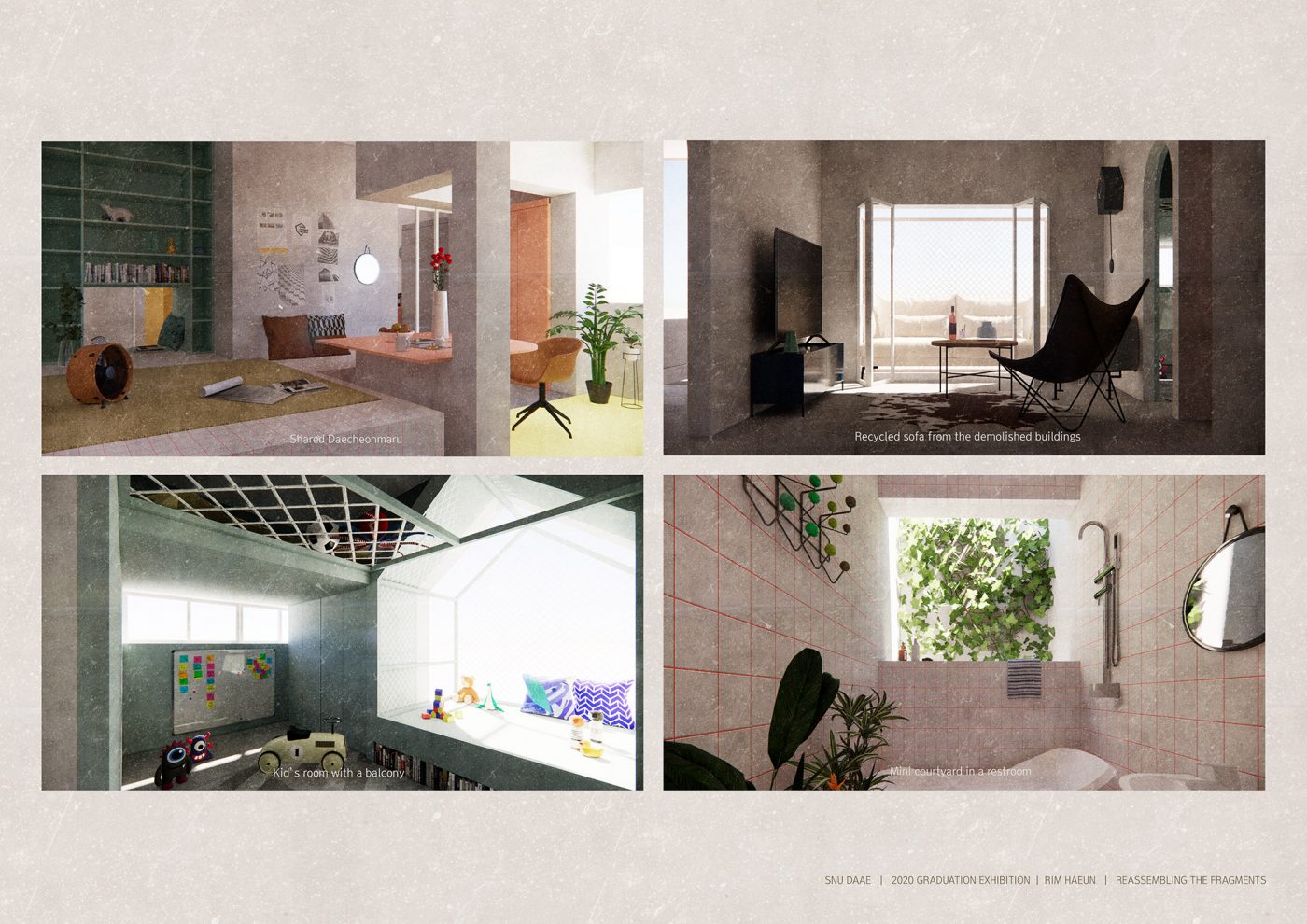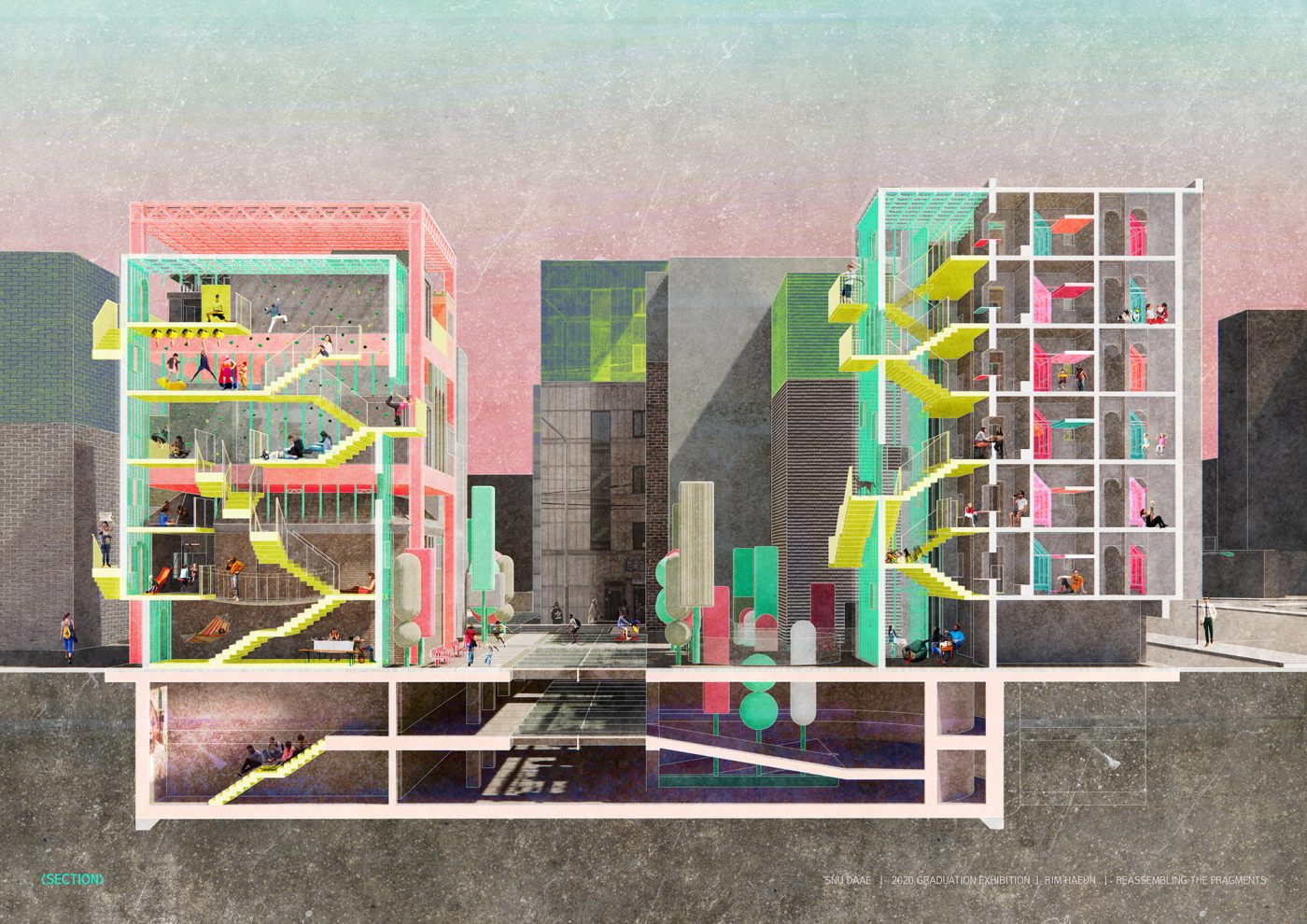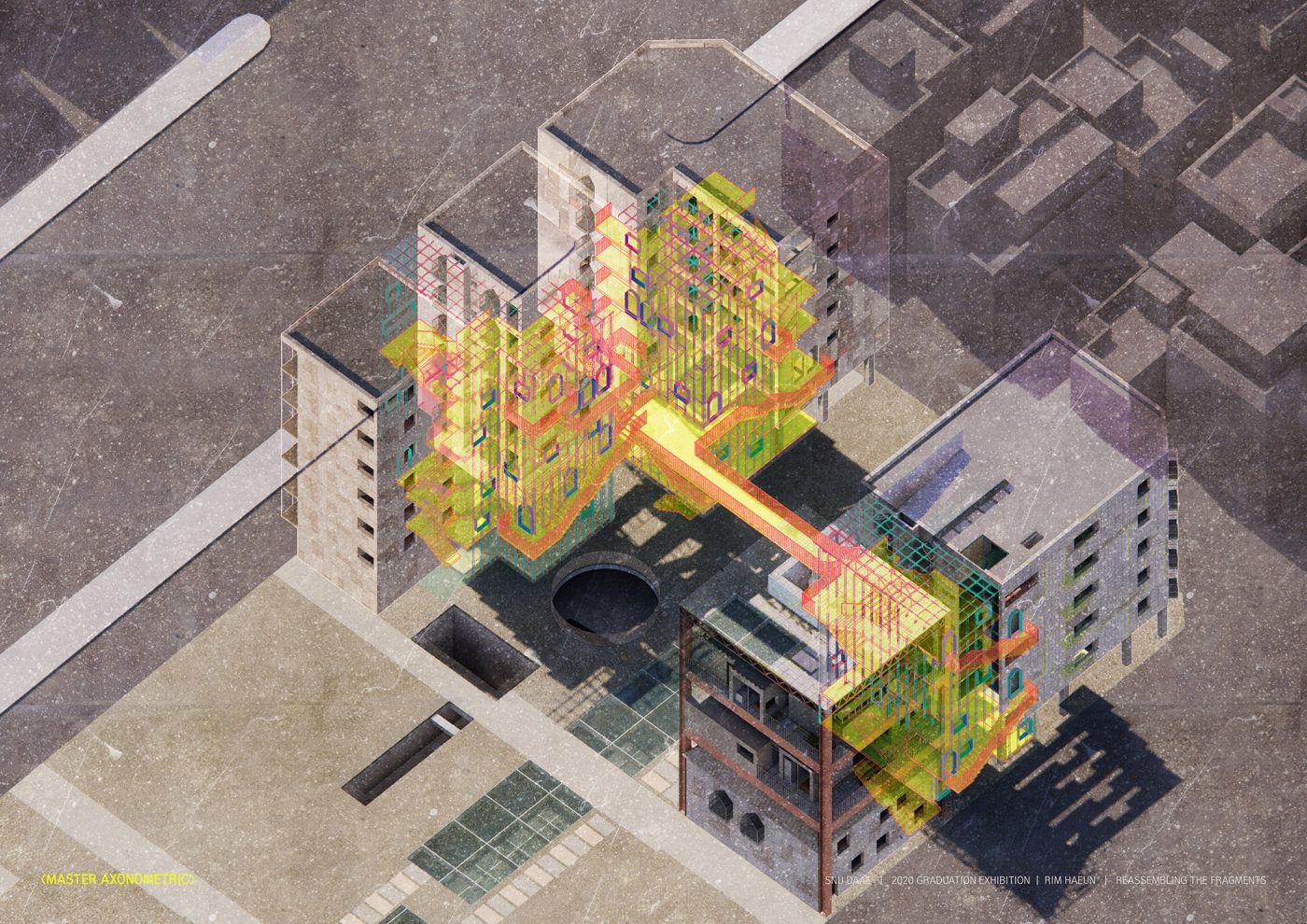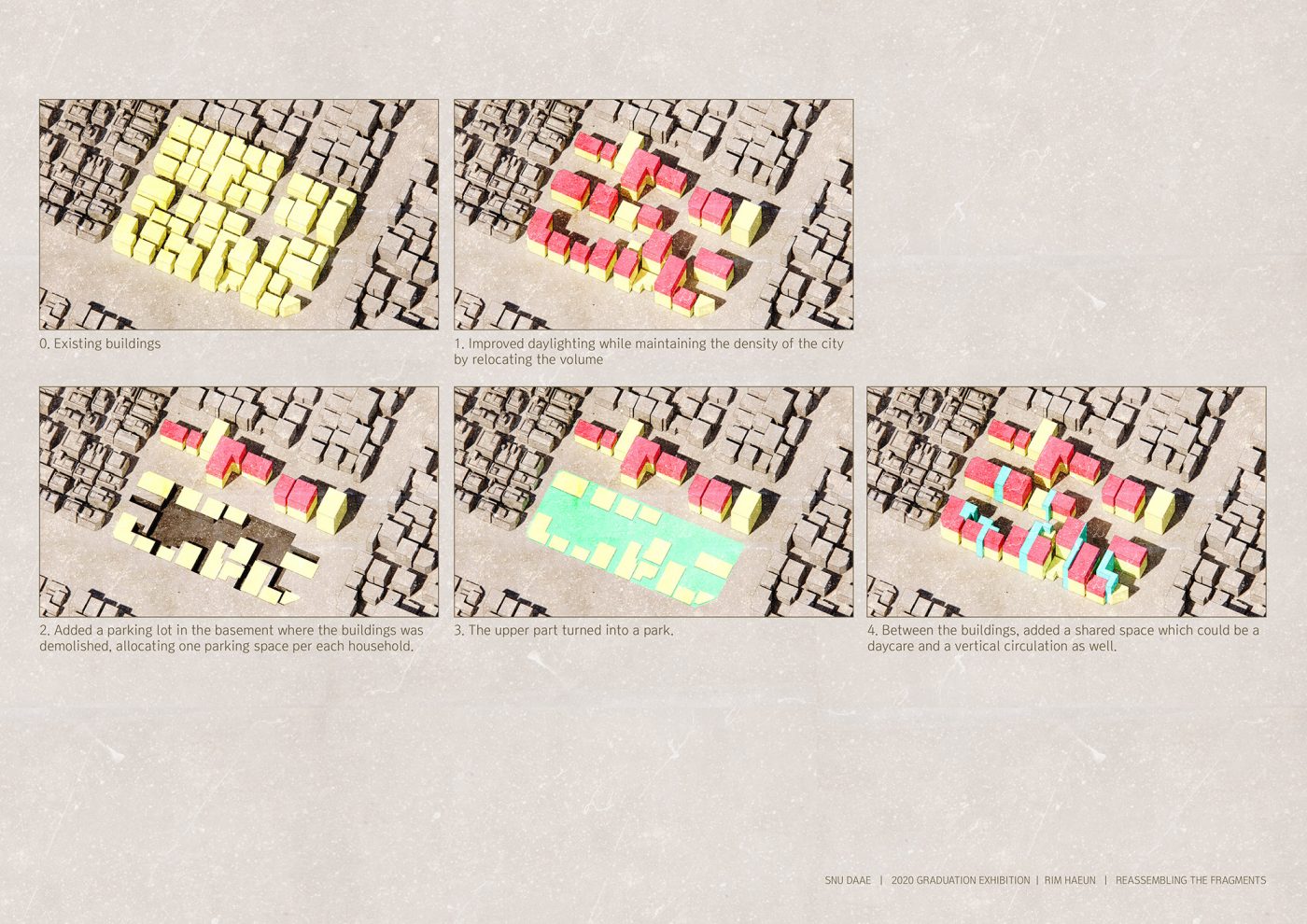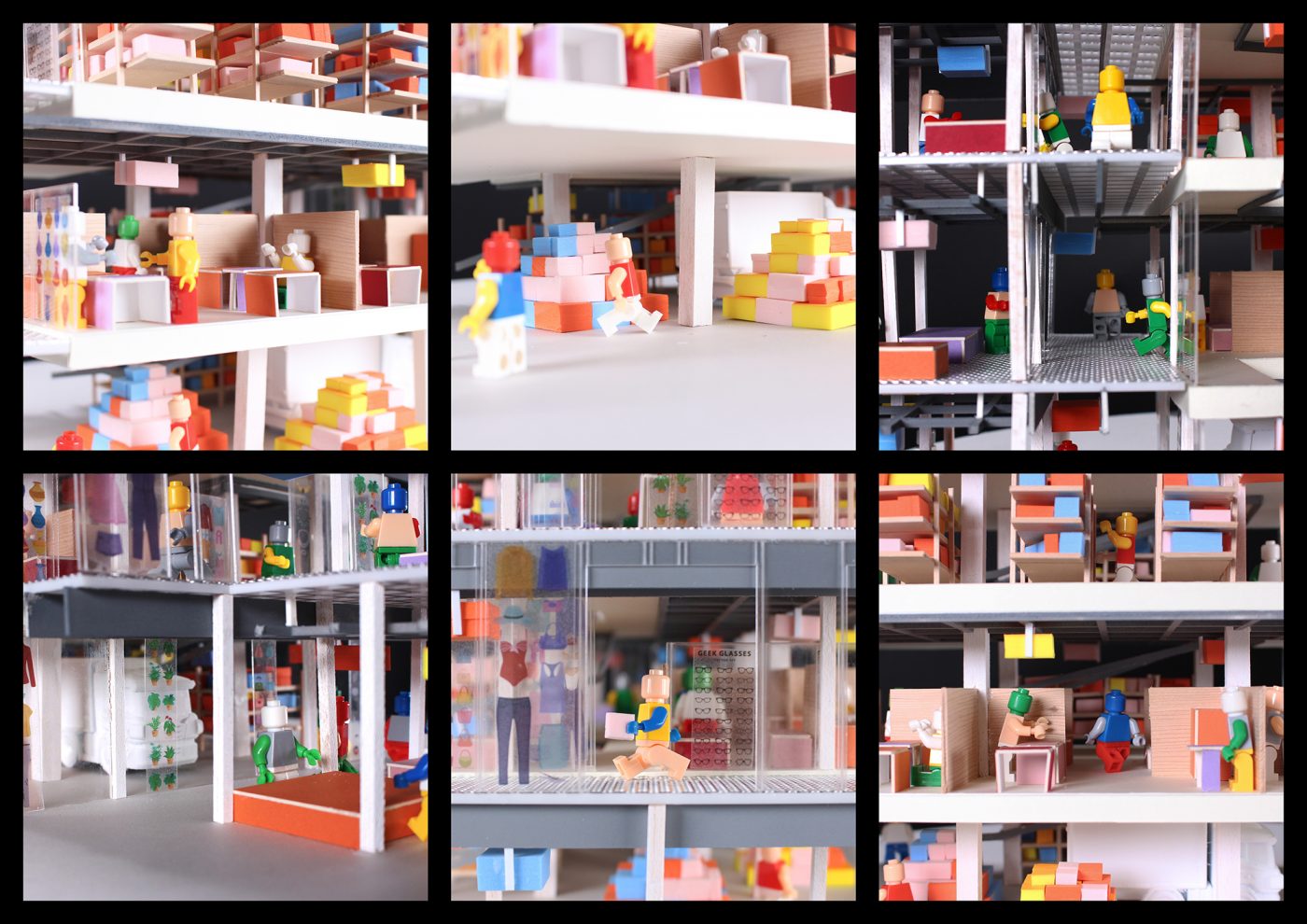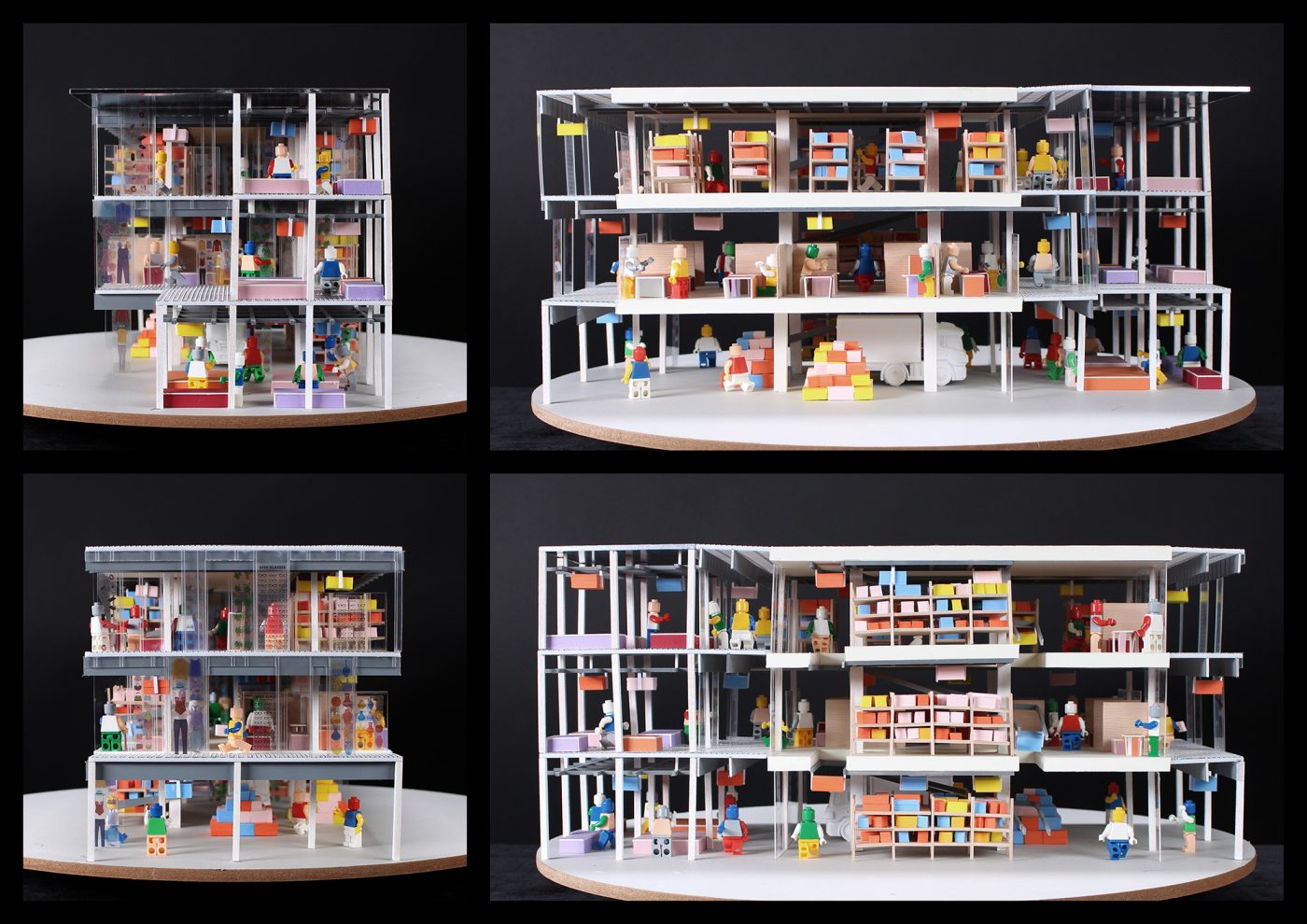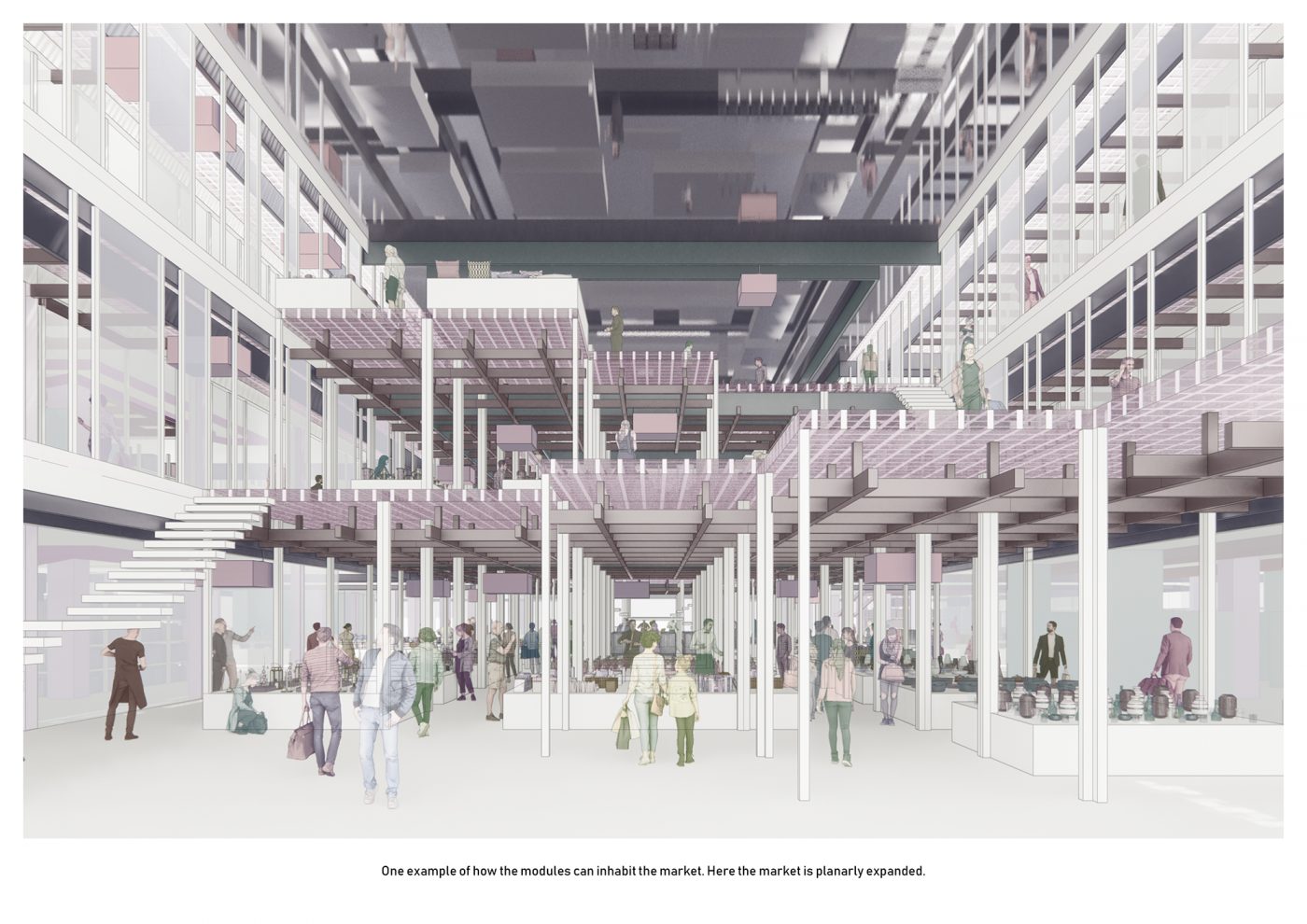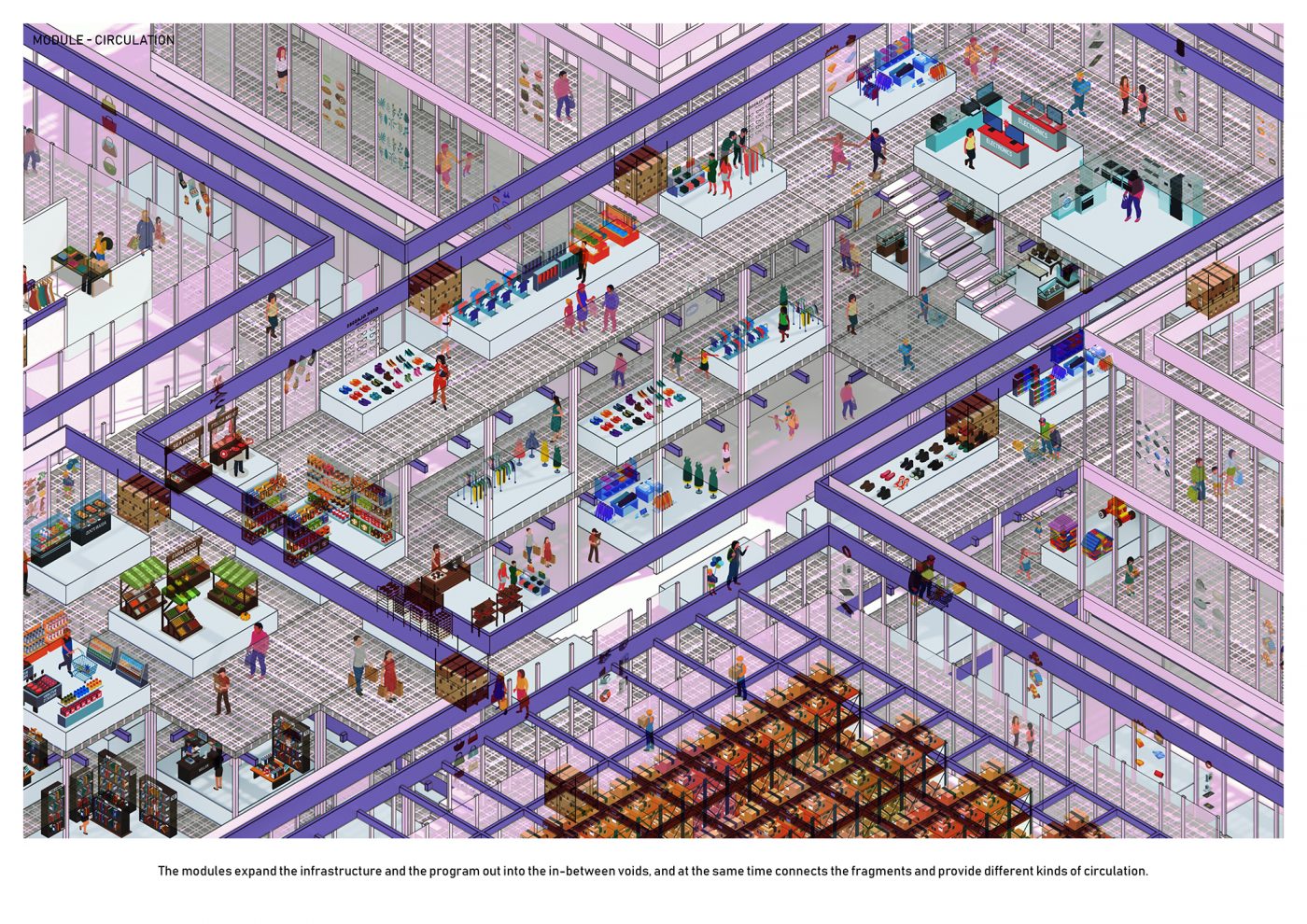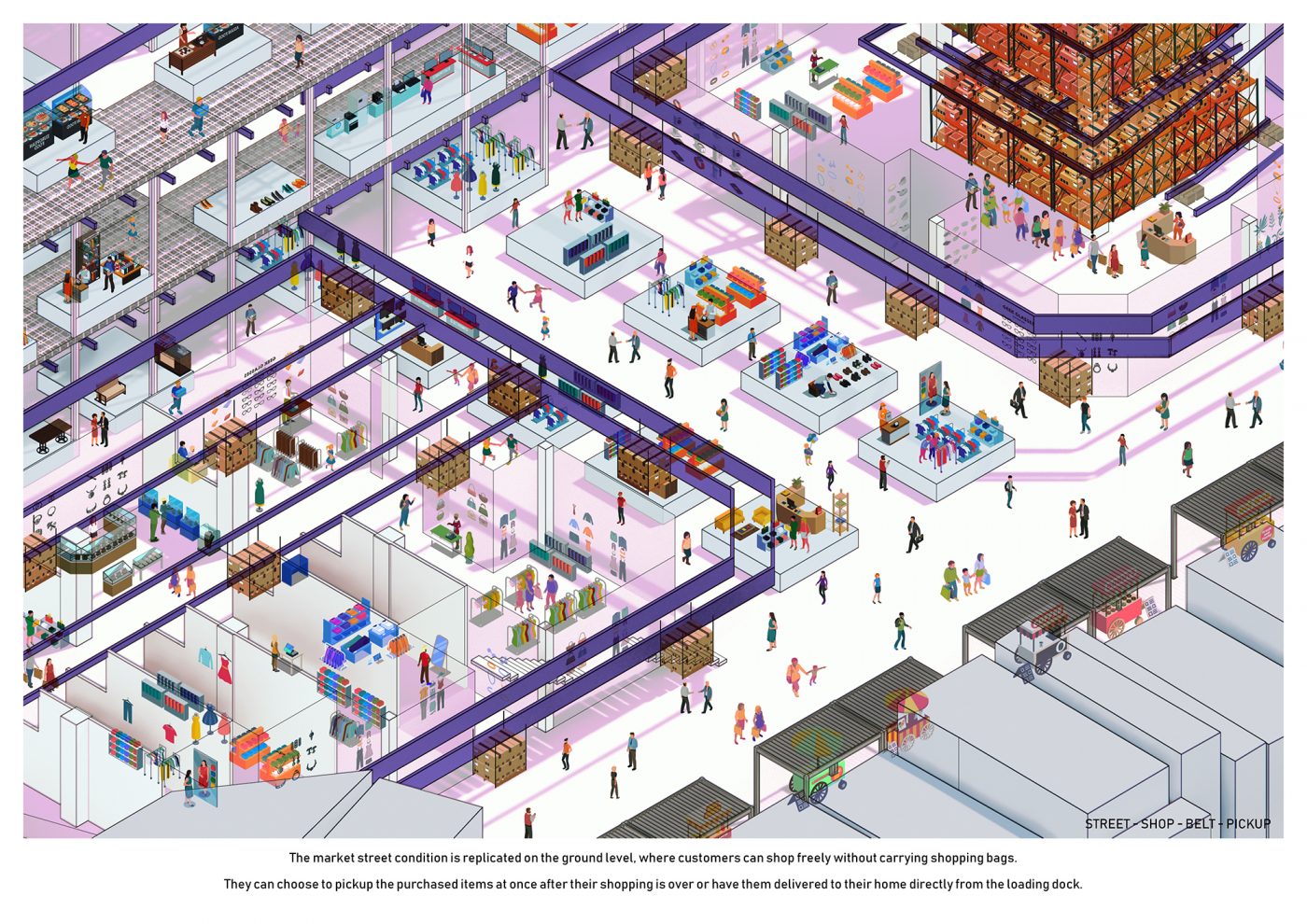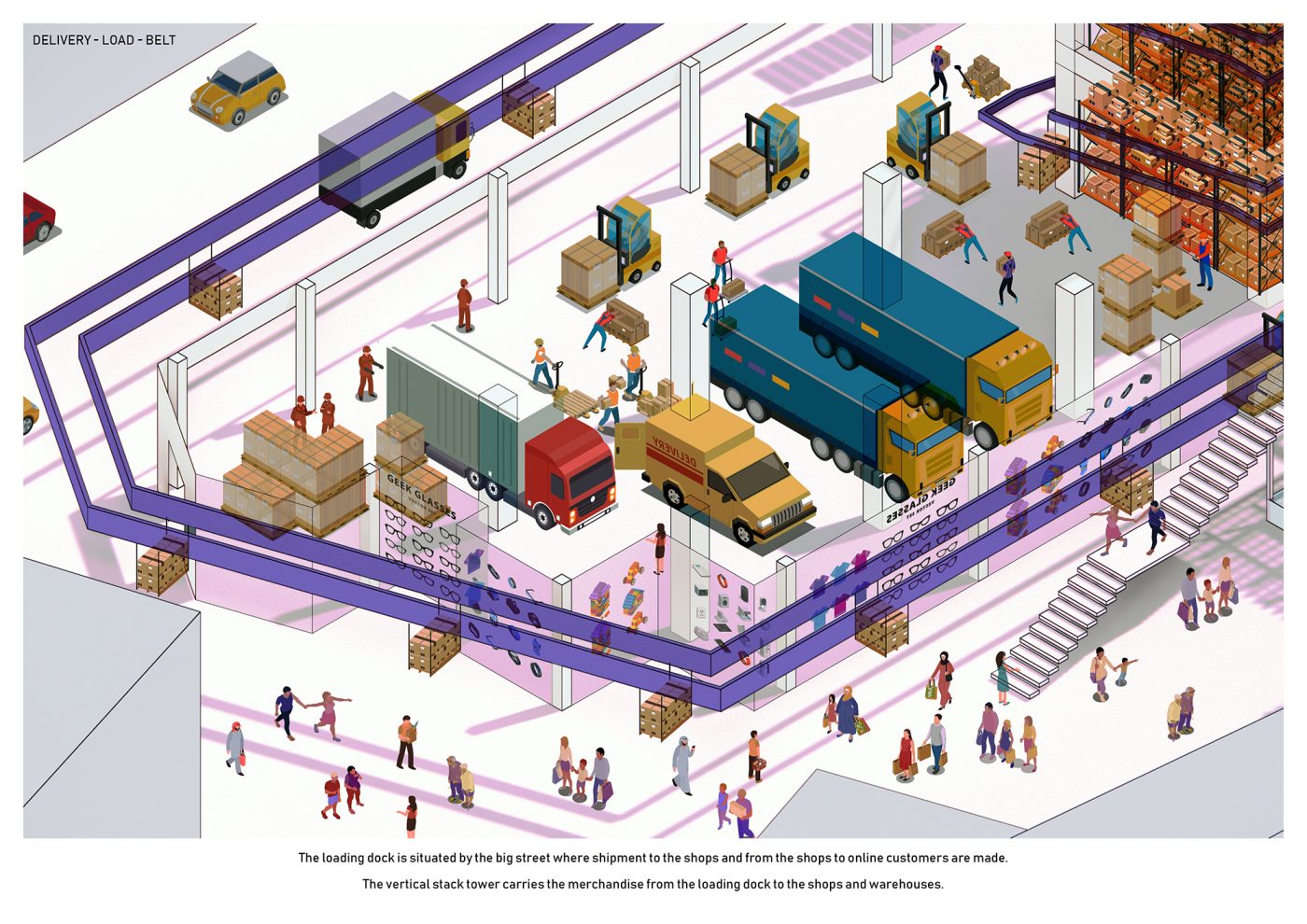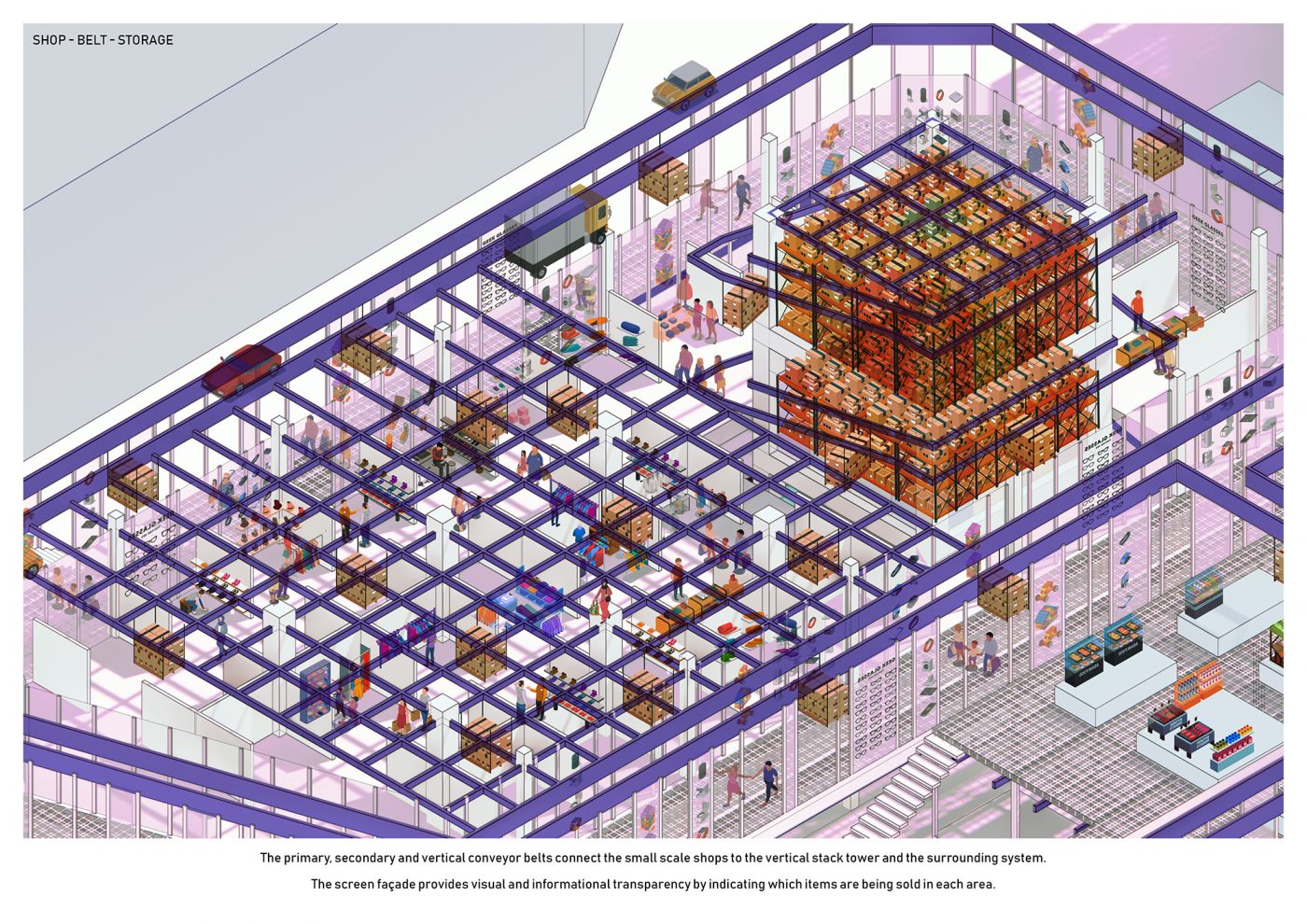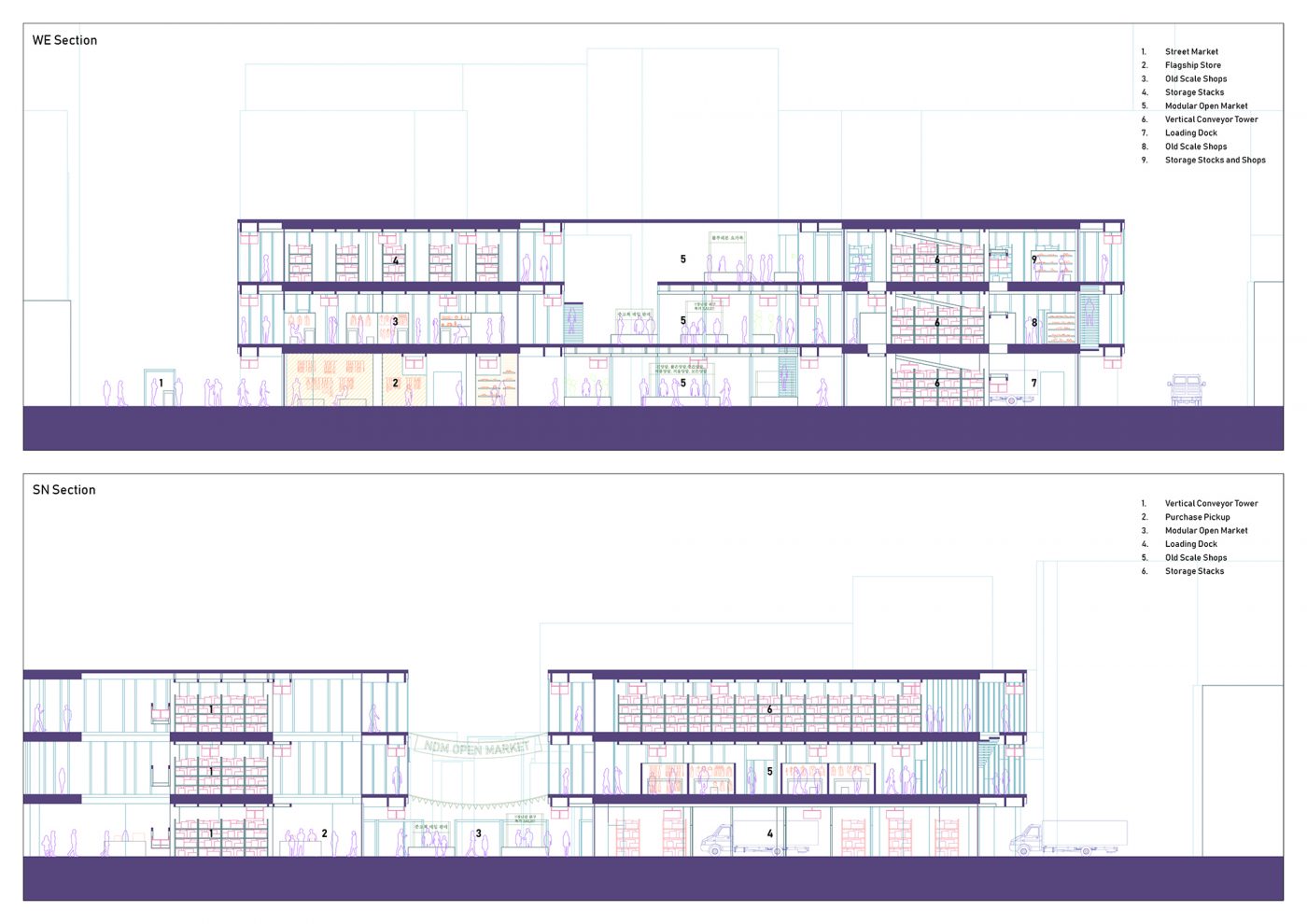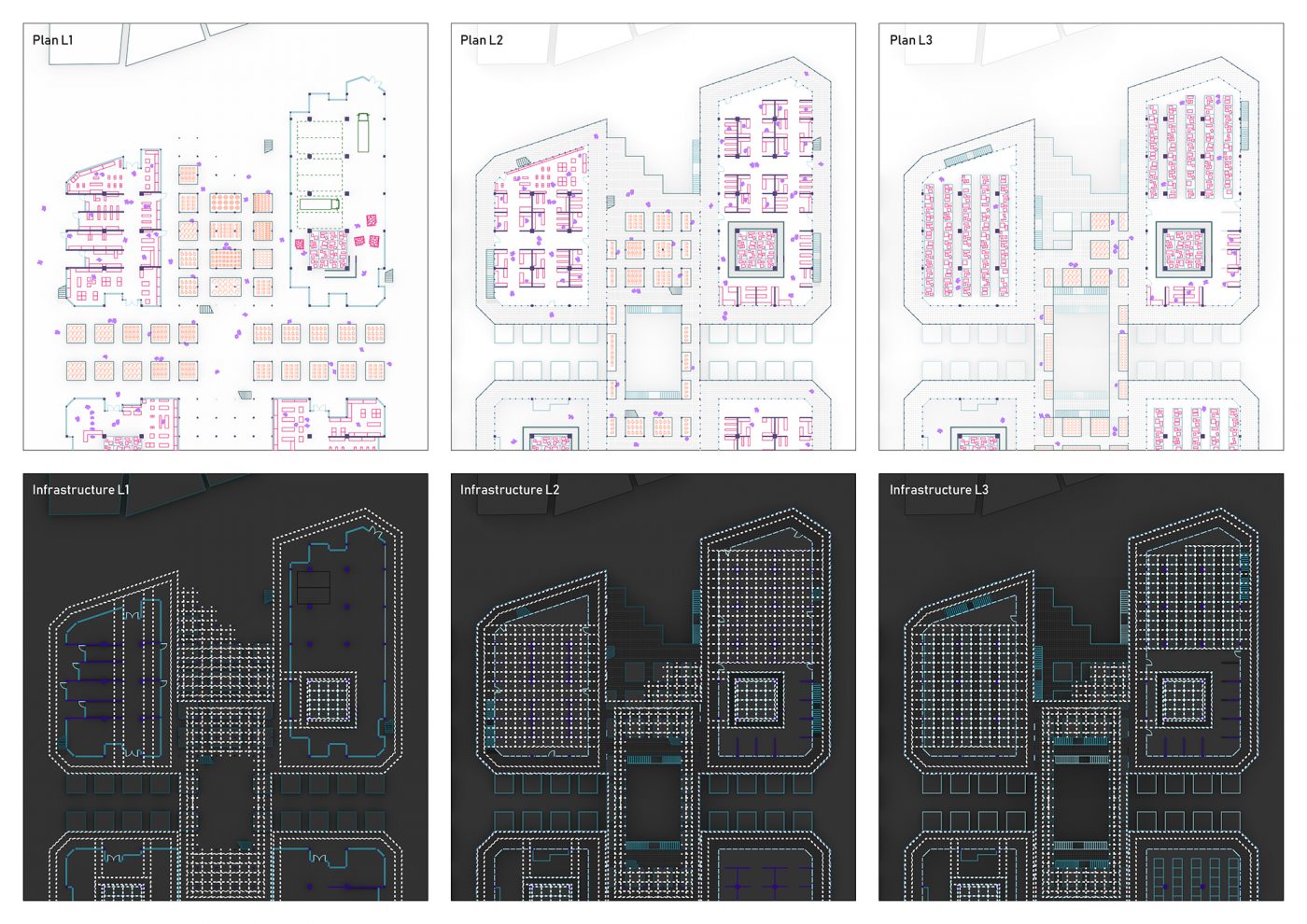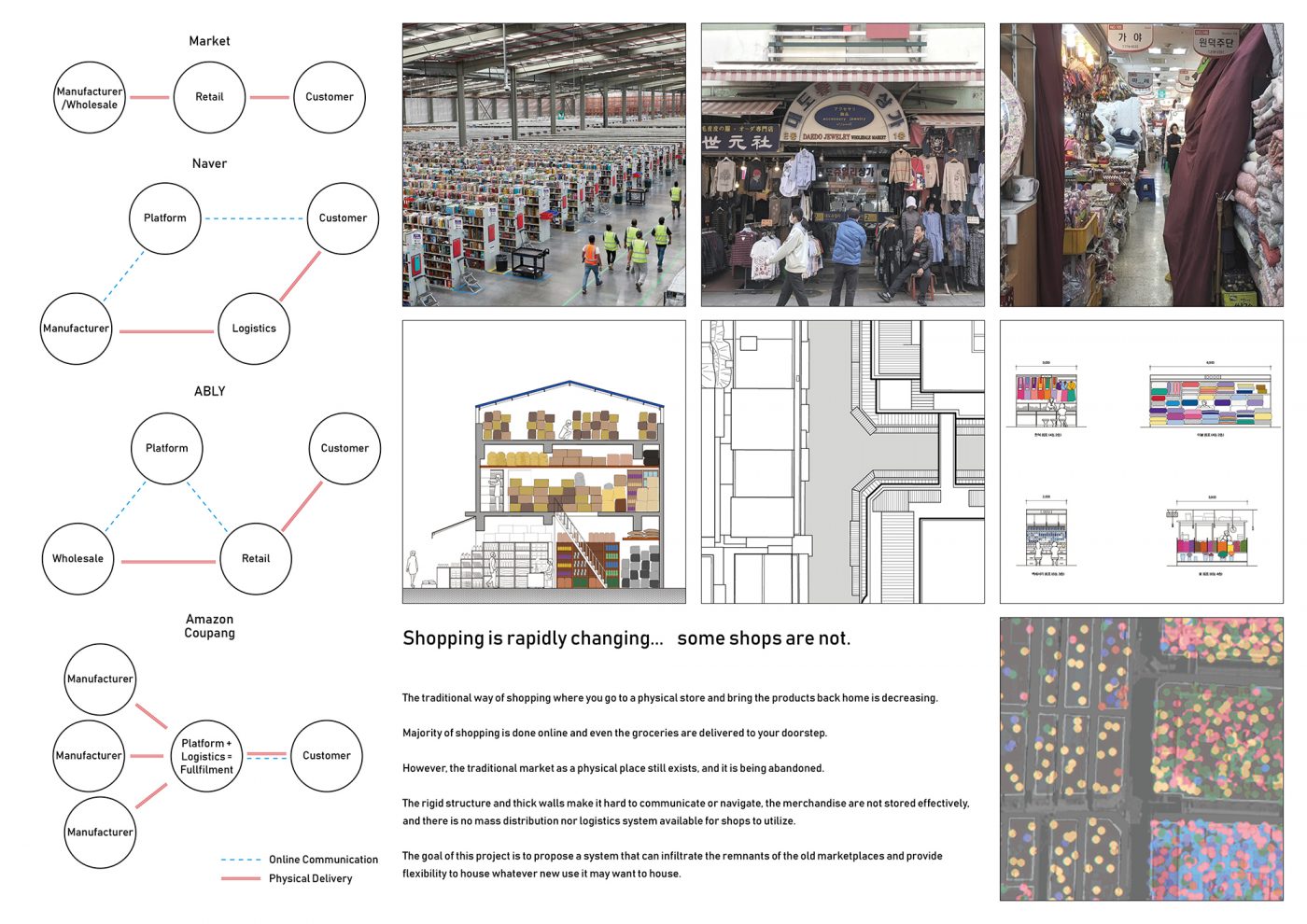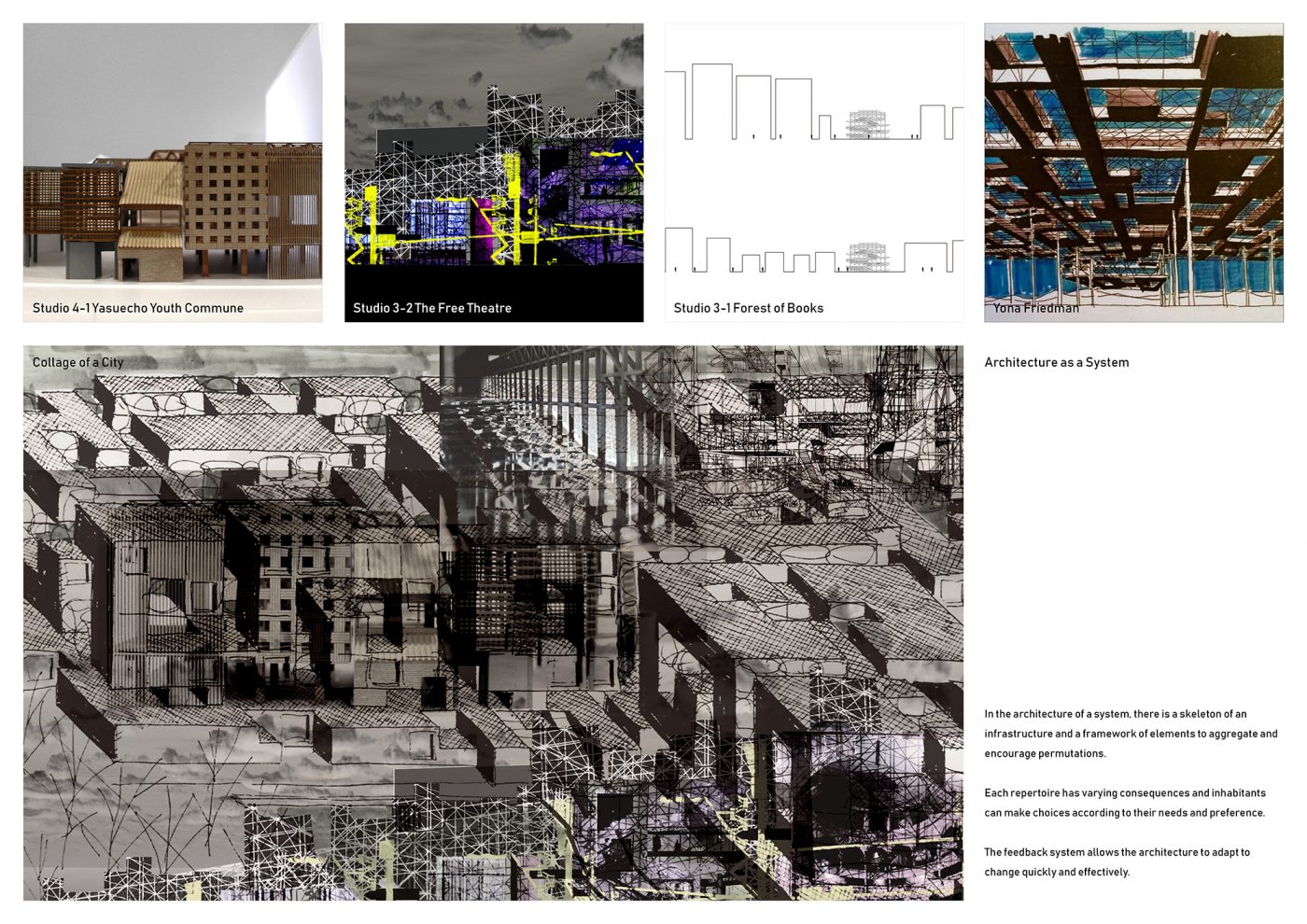2020년 학생 우수 프로젝트 (건축학전공)
students’ projects on 2020 (Architecture)
이주형
Joohyung Lee
최우수상
1st Prize
내포된 허구
서울 경희궁 일대는 역사와 허구가 극명하게 충돌하는 지역이다. 이곳에는 20년 전 복원된 궁궐, 일제강점기 지어진 방공호, 궁궐의 축선상에 지어진 서울역사박물관이 위치한다. 리쾨르에 의하면 역사와 허구는 이야기로 구성되기에 구조적으로 동일하다. 그렇다면 건축은 역사와 허구를 교차시키며 이야기를 생산해낼 힘을 갖는다. 이 프로젝트는 경희궁지에 들어설 개방형 수장고를 제안한다. 지금까지 금단의 영역에 속하던 수장고는 공공에 개방되며 새로운 의미를 만들어낸다. 이러한 수장고들의 형식은 허구적이다. 수장 공간들은 도서관, 키오스크, 창고, 사일로의 형식을 띠는데 이러한 허구적인 형식들은 유물을 보관하고 경험하는 새로운 방식을 제안해낸다. 수장 공간들은 지하를 가득 채운 기둥 체계에 포함되는데 기둥들의 배치는 과거 경희궁의 배치에 따른 것이다. 이를 통해 역사는 허구적 형식 속에, 허구적 형식은 다시 역사적 형식 속에 담기는 이중의 의미 구조가 완성된다. 동시에 지하와 지상을 연결하는 두 개의 계단을 통해 궁궐은 개방형 수장고의 일부로 편입된다. 서울역사박물관-개방형 수장고-경희궁-방공호가 유기적으로 연결되며 궁궐은 독립적으로 존재하는 대신 도시 속에 내포되어 보다 적극적으로 주변과 관계를 형성한다.
프로젝트 상세 설명
nestedfictions.work
Nested Fictions
Gyeonghuigung Palace in Seoul is a conflicting ground where fiction and history collide. It is where 20-year old restored palace, air-raid shelter from WWII, and a history museum that sits on the very ruins of the palace are located. In light of the assertion that fiction and history are structurally identical because they are made of narratives (P. Ricoeur), architecture interweaves the two to unleash stories and interpretations. This project proposes a visible storage for museums where artifacts hitherto kept secret are revealed to the public. Forms of fiction, including library, kiosk, warehouse and silos store and display artifacts in an unprecedented method. The column system in the underground is derived from the footprint of the palace, completing the double semantic structure where forms of fiction that nest historical artifacts are nested in forms of history. Two staircases that rise from the underground nest the palace into the circulation system. The museum, the air-raid shelter, the palace, and the visible storage are integrated into one compound, and the palace is no more a solitary island but a part of the urban fabric.
For more information, visit
nestedfictions.work
이정은
Jeongeun Lee
우수상
2nd Prize
매개도시 : 운동장
근린주구 이론에 따라 서울 도시 내 가장 균질한 오픈스페이스인 운동장은 사실 닫힌 공간이다. 주민들은 제한된 시간에 제한된 형태로 이용하며, 초등학교 구성원 또한 마찬가지이다. 한편 일시적으로 영화상영회, 물놀이장, 음악감상회 등 다양한 이벤트를 갖는 운동장은 ‘오픈스페이스’가 될 잠재성을 갖고 있다. 한편 초등학교 내 학생 수는 감소하고 있으며 폐교를 하는 상황도 발생한다. 또 코로나사태로 인해 학교의 역할에 물음표를 던지는 현상을 비추어 봤을 때, 학교는 사회적 교류의 장으로 기능해야 할 것이며 운동장 또한 진정한 의미로 지역 커뮤니티의 장(場)이 될 필요성이 있다. 이 프로젝트는 운동장과 학교의 새로운 프로토타입을 제안하며, 예시로 사당동 저층주거지 일대의 사이트에 카탈로그를 조합한다. 학교의 프로그램들은 도시와 공유가능한 성격을 띄고 있으며, 특히 지면 레벨의 운동장 뿐만 아니라 계단-복도-옥상 운동장의 연속적인 바닥은 입체적인 도시가 되어 적극적으로 주변과 관계를 형성하며 도시와 영향을 주고받는다.
Connected City : Playground
The most homogeneous openspace in the city is the playground according to the Neighborhood Unit. But it is actually a closed space. There’s some concert, film screening, and swimming events, but these events occur limitely and temporarily. But It says the playground has the potential to become an ‘openspace’. On the other hand, There is also a situation where the number of students is decrease, and the school close. If there is no school, it means that the school district will be expanded, which means that the community will be blurred. In addition, we have some questions about the role of the school due to the coronavirus. ‘what is the fundamental role of the school? What should the school’s role be?’ If the school share the programs of the school and playground with the city, the whole city can be active while protecting the existing schools and playgrounds. This project proposes new prototypes for schools and playgrounds, and I designed an example which combines my catalogues on the site of a low-rise residential area in Sadang-dong, Seoul. In my suggestion, The playground becomes the city itself. In particular, The continuous floors of the playground will become a three dimensional city, actively forming realationships with the surroundings. That could cause changes in the city in the near future.
현하영
Hayoung Hyun
우수상
2nd Prize
Re-defining the meaning of Seoul city wall
한양도성의 새로운 역할은 무엇인가?
건축은 의사소통 언어이다. 건축은 우리에게 의미를 전달하고, 그 의미는 주변 맥락에 따라 계속 변화한다. 따라서 건축은 역사적 맥락 속에서 계속 변화한다. 오랜 시간 존재해 온 한양도성 역시 그 의미가 변화하였다. 도성의 경계를 표시하고 외부로부터 성 안을 방어하던 성벽은, 서울의 경계가 점차 확장함에 따라 서울 중심에 자리잡게 되었다. 그러나 한양도성은 새로운 역할에 대한 고민이 간과된 채 보존의 대상으로만 지정되었고, 그 결과 한양도성의 요소들이 파편화되어 존재하게 되었다.
창신동과 동대문 일대를 연결하는 부지에 위치하고 과거 한양도성의 흔적에 인접한 새로운 도시공간은 한양도성을 벽이 아닌 ‘일상적인 길’로 새롭게 정의한다. 사라진 한양도성의 흔적을 따르는 새로운 ‘벽 구조물’은 한양도성과 창신동, 그리고 연접된 공원인 청계천을 연결하고, 창신동의 디자이너와 방문자들이 소통할 수 있는 장을 제공한다. 이 곳에서 사람들은 벽과 나란한 방향으로 이동하거나, 벽 사이를 왔다 갔다 하며, 한양도성의 역사적 · 문화적 가치를 재조명한다. 벽 주위에서는 다양한 행위가 교차한다. 이로써 한양도성은 더 이상 두 공간을 단절시키는 벽이 아니라, 두 공간을 모두 마주할 수 있는 길이 된다.
Re-defining the meaning of Seoul city wall
“what is a new role of Seoul city wall?”
Architecture is language for communication. Architecture delivers meaning to us, and its meaning changes as the surrounding context changes. Therefore, architecture continues changing in historical context. The meaning of Seoul city wall has also changed; a fortress wall to mark city’s boundaries and defend the city from the outside, became to be located in the middle of Seoul. However, the fortress was simply designated as a target for preservation, ignoring concerns about its new role. As a result, the elements of Seoul city wall were left fragmented.
Located on a site between Changsin-dong and Dongdaemun, the new urban space adjacent to the traces of the former Seoul city wall re-defines it as a routine path rather than a wall. The new “wall structure” that follows the traces of the disappeared Seoul city wall connects changsin-dong and cheonggyecheon and provides a place for young designers and visitors to communicate. Here, people move in a direction that is parallel to the wall or move back and forth between the wall, reconfiguring historical and cultural values of the Seoul city wall. Various acts intersect around the wall. As a result, Seoul city wall is no longer a wall that disconnects two spaces, but a path to face both spaces.
박지혜
Jihye Park
특선
3rd Prize
Aging in Seoul
건축은 공간을 만드는 것에 그 목적과 결과가 있고, 이는 공간의 쓰임을 전제로 한다. 그러나 쓰임은 영원하지 않고, 그것을 따르는 건축 또한 그렇다. 사회를 향한 건축적 제안은 기능적인 면으로 귀결되는 경우가 많았고, 이런 제안은 사람들을 연령대에 따라 특정한 ‘마을’에 살게 하는 현상을 낳았다. 서울의 전형적인 저층 주거 밀집 지역 중 하나인 해당 영역에는 세 개의 노인 시설이 있다. 그리고 그 시설들은 모두 행정적 편의로 인해 경사지의 가장 위쪽, 남는 땅에 위치하여, 물리적으로도, 심리적으로도 지역 사회와 단절되어 있다. 지금까지 이러한 방법은 합리적인 대안이었으나, 고령 인구가 급격히 증가하는 사회에서 고령 인구를 한 데 묶어 그들의 삶이 있던 공간에서, 혹은 다른 사회 구성원들로부터 서서히 배제시키는 방법은 더 이상 최선의 제안이 될 수 없다. 이 프로젝트는 변화하는 사회에 대한 새로운 제안이다. 이 도시의 사람들이 자신의 삶이 있던 공간에서 나이 들어갈 수 있게 하는 제안이기를 바란다.
Aging In Seoul
Architecture aims and results in creating space, which is assumed to be the use of space. However, the use of space is not permanent and the architecture that follows will be temporary. The proposals towards society have resulted in the functional aspects, and such proposals related to the situation that people live in a certain ‘town’ by age. This site is typical low-rise residential area in Seoul, and three elderly facilities are sited. These facilities are all located at the top of the slope, on the remaining site, because of administrative expediency, and are physically and psychologically excluded from the local community. So far, this method has been a reasonable alternative, but in aging society, the method of gradually excluding the elders from where their lives existed, without considering any diversity of them, can no longer be the best proposal. This project is a new proposal towards ever-changing society. I expect it to be a proposal that makes citizen to aging in place where their lives have been.
김범부
Bumboo Kim
특선
3rd Prize
‘신(新) 아고라 : 민주주의 문화의 새로운 타이폴로지’
건축은 경계를 만드는 것입니다. 건축은 경계를 통해 관계를 형성하거나 단절시키는 것에서 시작합니다. ‘사이영역’은 경계와 경계가 만나는 중간 지대로, 다양한 관계가 공존하는 독특한 공간입니다. 그러므로 사이영역은 도시 속에 공공성을 담아낼 수 있는 열쇠입니다.
정치는 우리의 일상을 크게 좌우합니다. 하지만 흔히 접하는 정치의 모습은 우리의 일상과는 전혀 다른 세상의 것으로 느껴지곤 합니다. 정치 집단이 관료제화 되고 정치 담론이 진영 논리에 빠져감에 따라 정치는 우리의 삶과는 점차 멀어지고 있습니다.
시장이자 광장이자 정치 공간이었던 고대의 아고라는 일상과 정치가 공존하는 곳이었습니다. 사람들이 각기 다른 생각을 나누면서 민주주의가 발전할 수 있었던 것이죠. 반면, 지금의 한국 사회는 도시와 광장, 그리고 정치 공간이 분리되어 존재합니다. 우리 사회의 민주주의가 발전하기 위해선, 아고라와 같이, 시민들이 어우러져 다양한 관점을 공유할 수 있는 ‘공공의’ 공간이 필요합니다. 저는 정치와 일상이 포개어진 새로운 타이폴로지의 정치-문화 공간을 제안합니다.
공연장과 전시실, 도서관과 같은 익숙한 문화 시설의 형식을 빌려와 시민들이 정치에 쉽게 스며들 수 있는 공간을 만들었다. 그리고 이러한 대형 공간을 감싸는 복도 공간은 다양한 공공의 프로그램으로 자유롭게 배치했습니다.
방대한 매스를 덮는 거대한 캐노피는 건물과 실외 공간의 빛을 조절함과 동시에, 상징성을 드러내는 역할을 합니다. 도시에 우뚝 서서 존재하지 않고 낮고 넓게 아우르는 건물의 모습과 그 사이를 자유롭게 거니는 수많은 사람들의 풍경이 우리 사회의 새로운 상징성을 함축할 것입니다.
‘Neo Agora : The New Typology of Democratic Culture’
Architecture begins with the formation or disconnection of relationships through boundaries. ‘The in-between space’ is the middle area where the boundaries meet, and it is a distinctive space where various relationships coexist. Therefore, ‘the In-Between space’ is the key to capturing publicness in the city.
Politics greatly influences our daily lives. However, we usually feel politics are too far from our daily life. As politics become bureaucratic and political discourse locked in two parties, politics is gradually moving away from our lives.
The ancient Agora was a marketplace, a square, and a political space, where politics blended in with our lives. People were able to develop democracy through sharing different opinions. On the other hand, now in Korea, cities, squares, and political spaces are separated. To take our democracy one step further, we need a “public” space like ‘Agora’, where citizens can share various perspectives. I propose a new typology of political-cultural space that blends politics with our lives.
By borrowing familiar forms of cultural facilities, such as auditoriums, exhibition halls and libraries, I created a space for citizens to easily immerse themselves in politics. And the common spaces surrounding these large spaces were freely arranged with various public programs.
The massive canopy that covers the entire building, controls the light in building and outdoor spaces, while revealing its symbolism. Instead of standing tall in the city, the building emcompasses low and wide. The scenery of countless people walking freely through the building will imply a new symbolism in our society.
임하은
Haeun Rim
장려상
4th Prize
빌라의 재구성
개요
AI가 설계 및 시공하는 시대에 건축가는 독창적 이미지를 통해 포토스팟과 해시태그를 선점하는 트렌드 리더의 역할이 더 강조될 것입니다. 사이트인 빌라 밀집지역을 레노베이션하면서 이 일대를 재구성해 일조권, 주차, 보안, 녹지 부족 등의 주거 문제를 해결하고, 공용 거실이자 공동 육아 공간인 수직 공간을 중심으로 공동체를 강화하며, 철거한 건물의 벽체, 가구, 마감재 등을 재활용해 독창적인 이미지를 강조한 빌라 레노베이션 프로토타입을 제시합니다.
공용 거실 계단
수직 공간은 반복되는 계단 없이 다이나믹하며 서로 계속 마주치고 자연스럽게 소통하는 공간입니다. 계단을 포함한 모든 곳이 공용 거실이며 신발을 벗고 이용합니다. 계단참과 복도에는 공용 키친, 다이닝, 놀이터, 어린이집, 도서관, 영화관, 운동시설 등이 경계없이 있습니다.
구조 전략
구조물의 종류에 따라 세 가지 전략이 있습니다. 철근콘크리트 건물은 기둥과 외벽만 남긴 채 기존 그리드를 유지해 3개층까지 증축합니다. 조적조는 세심하게 보수되어야 하기 때문에 건물을 감싸는 형태로 트러스 선반을 만들어 증축합니다. 사이 공간의 경우 기존 건물의 측벽을 공유하며 바닥은 양쪽에 걸쳐져 있습니다.
재활용과 재구성
이 프로젝트의 컨셉이 빌라를 재구성하는 것이기 때문에 철거된 건물에서 많은 요소들을 가져와 재활용했습니다. 철거된 건물의 마감재를 섞은 콜라주 패턴이 마감재로 적용됐습니다.
Reassembling the fragments : Reconfiguration of Korean Villas (Multi-family housing)
Summary
In an era of AI design and construction, the architect’s role as a trend leader who preoccupies photo spots and hashtags through original images will be more emphasized. By renovating Korean villas (multi-family housing), housing problems such as daylighting, parking, security, and lack of green has been solved and strengthen the community with shared-living-stairs, presenting a renovation prototype of the villa which emphasizes an original image by recycling the elements from the demolished buildings.
Shared-living-stairs
The shared space is a communication place where the tenants naturally encounter each other. The whole building including stairs is a shared living room where tenants take off their shoes. They sit on the stairs read books and talk. On landings and corridors, there are lots of programs without boundaries like shared kitchens, dining, playgrounds, daycare, libraries, theaters and sports facilities.
Structural strategy
There are three structural strategies depending on the type of structure. For the RC buildings, the existing grid will be extended up to three additional floors, leaving only columns and outer walls. And for masonry buildings there will be truss shelves casing them. For the in-between space, it shares the sidewalls of the existing buildings and the floors are hung on both sides.
Reassembling the fragments
Because the concept of this project is reconfiguring the villa, I brought many elements from the demolished buildings and recycled them. For the finishing material, a collage pattern mixed with the finishing material from the demolished buildings was applied.
김대홍
Daehong Kim
장려상
4th Prize
Shoppertoire
“건축은 세계를 따라잡는 영원한 순환 속에 있다.”
시스템으로서의 건축은 인프라의 골격과 각 요소의 프레임워크의 집합 및 결합으로 구성된다.
이때 건축가의 역할은 설계 과정을 독점하는 것이 아니라 레퍼토리의 틀을 세워 주민들이 자신의 필요와 선호에 따라 선택할 수 있는 다양한 결과를 이끌어내는 것에 있다.
본 프로젝트에서는 남대문시장 상가의 옛 구조물에 쇼핑, 물류, 상품 취급의 요소를 해체, 모듈화, 재조립, 중첩하였다.
컨베이어벨트 시스템은 각 규모의 상점, 창고, 상하차장, 쇼핑 보조 서비스를 연결하며, 모듈화된 구조는 그리드 시스템의 공간적 확장을 가능하게 한다.
각 요소의 명확성과 병치를 통해 불투명하고 미로 같은 단지에서 정보의 투명성, 그리고 방향적 투명성을 얻을 수 있으며 쇼핑객들은 체험으로서의 쇼핑의 가치를 발견하게된다.
레퍼토리는 지속적으로 변종, 미러링, 변형되며, 건축은 점유자가 건축에 일정 권력을 가지는 시스템에서 신속하고 효과적으로 변화에 대응할 수 있다.
Shoppertoire
“Architecture finds itself in a perpetual cycle of catch-up with the world.”
In architecture as a system, a skeleton of infrastructure and a framework of elements combine together to aggregate and encourage permutations. The role of the architect is not to monopolize the design process but to set up a framework of repertoires leading to varying consequences from which inhabitants can make choices according to their needs and preference. In this project, elements of shopping, logistics and product handling were deconstructed, modularized, reassembled, and overlaid on the old structures of Namdaemun market complexes. The conveyor belt system connects the small and large scale shops, the warehouses, the loading dock, and the shop-aiding services while the modularized tectonics allow spatial expansion of the grid system. The clarity of each element and their juxtaposition provides both informational and navigational transparency in the once opaque, maze-like complexes in which the shoppers can discover a new experience value to shopping. Repertoires are mutated, mirrored and morphed continuously in a system where the inhabitants wield power on their own habitat, and the architecture responds to change quickly and effectively.
